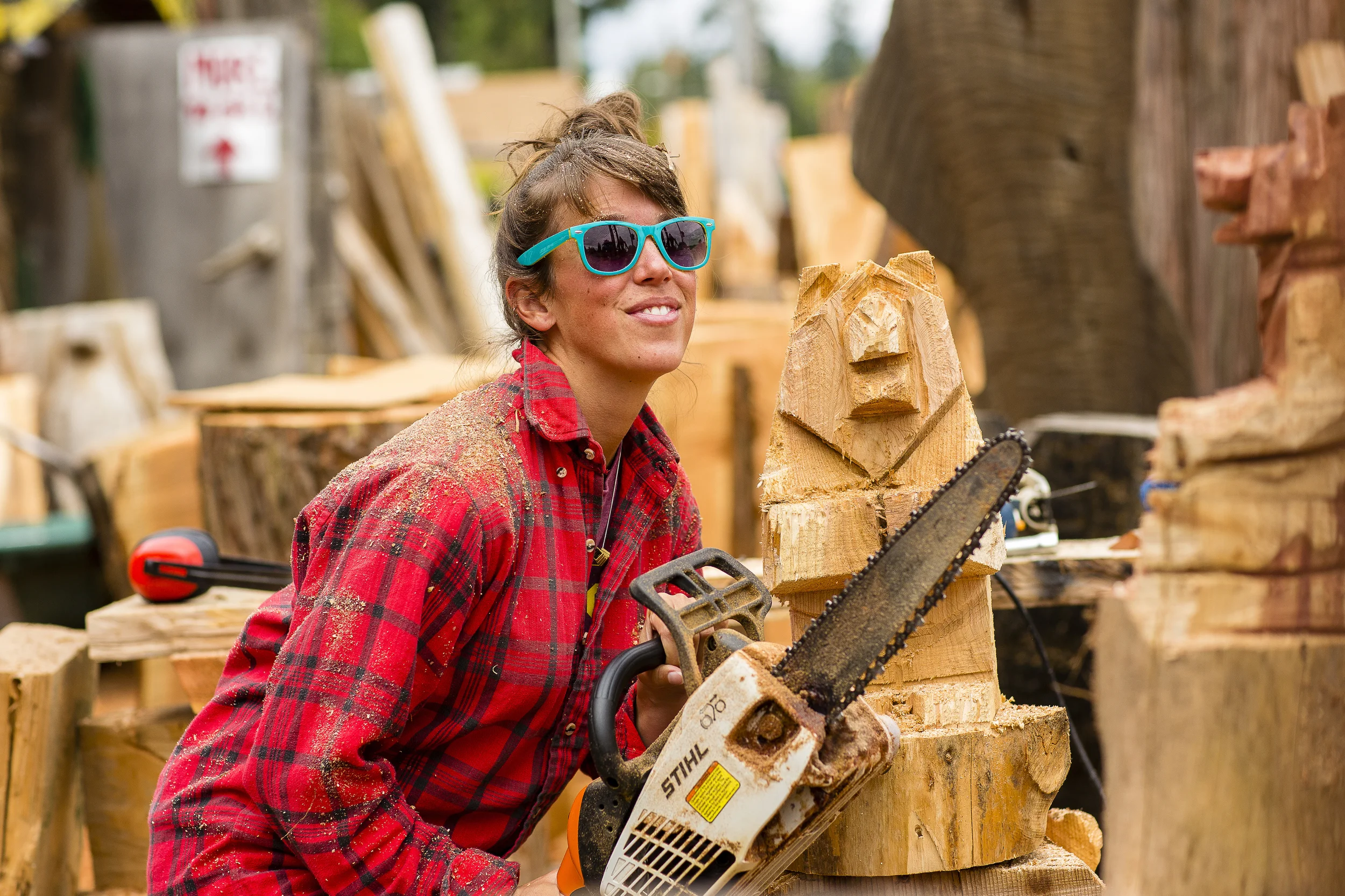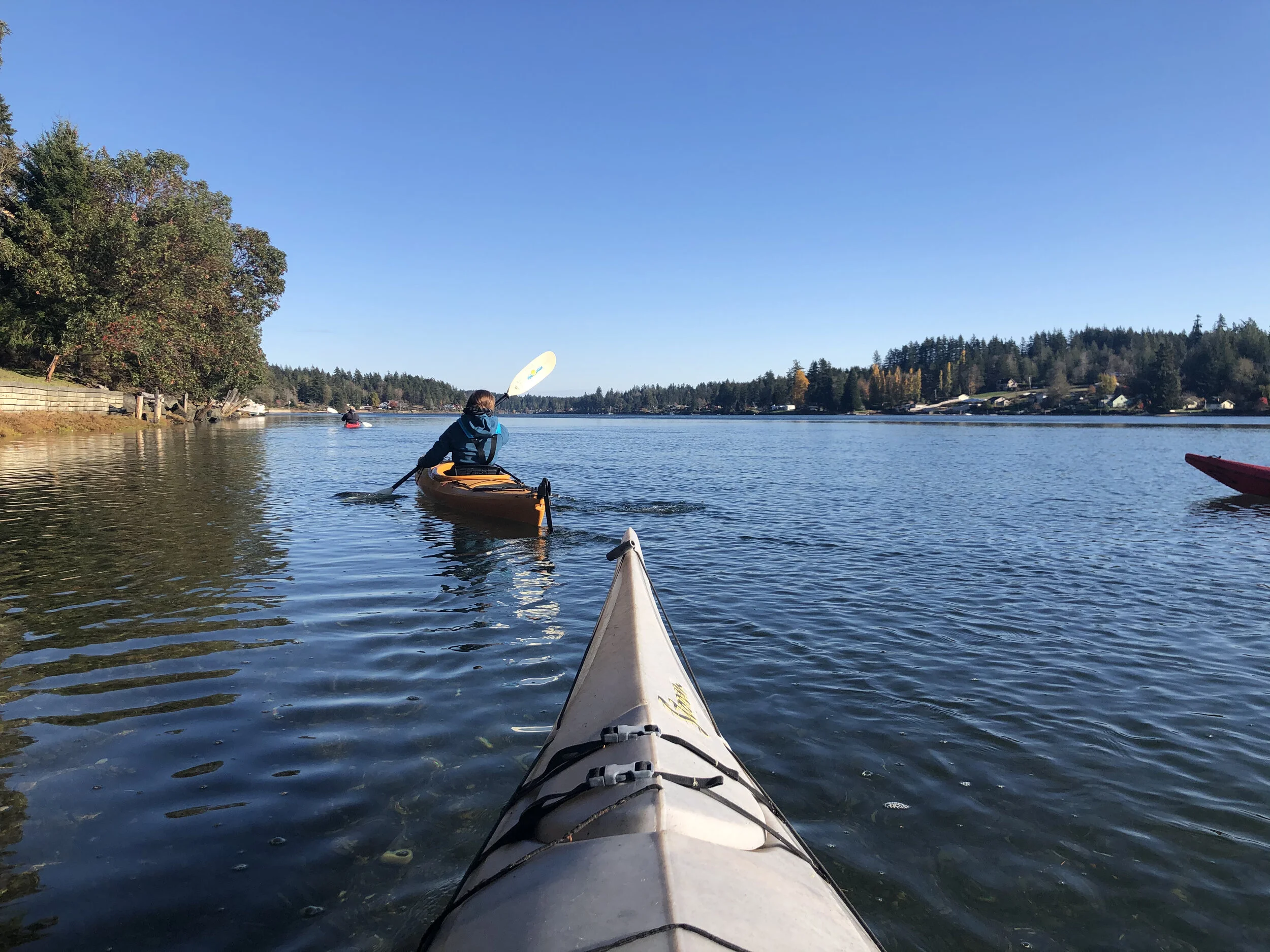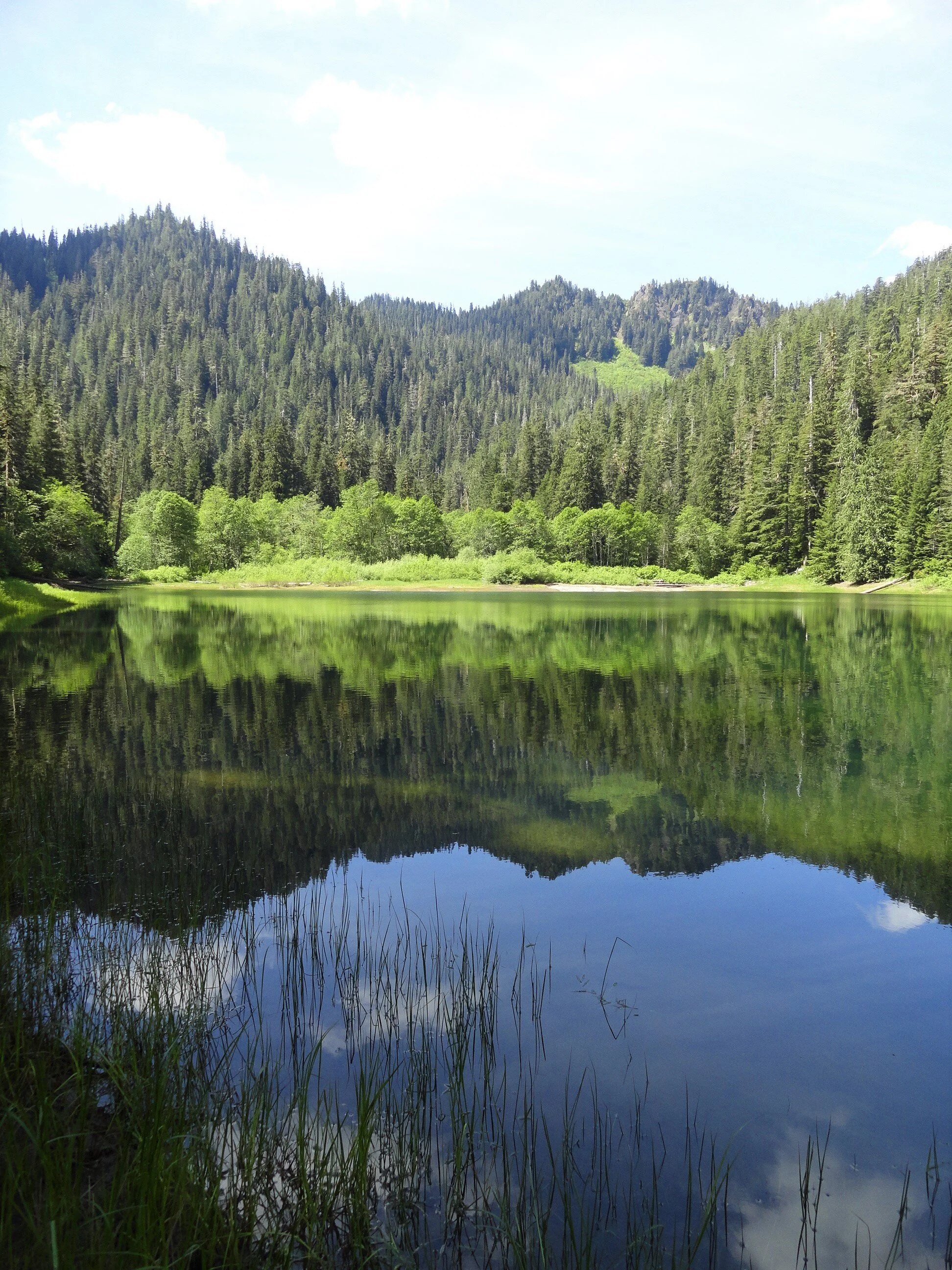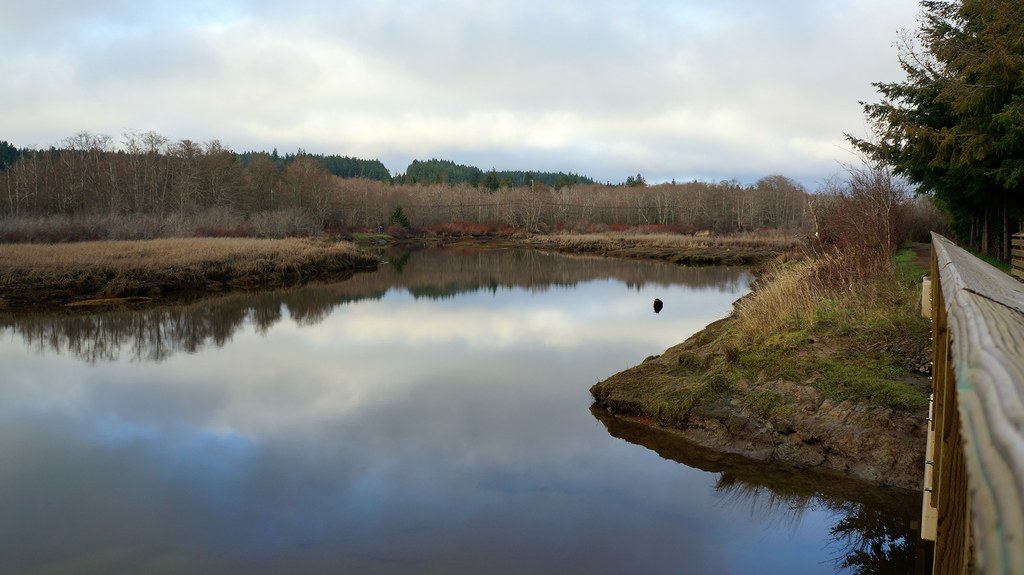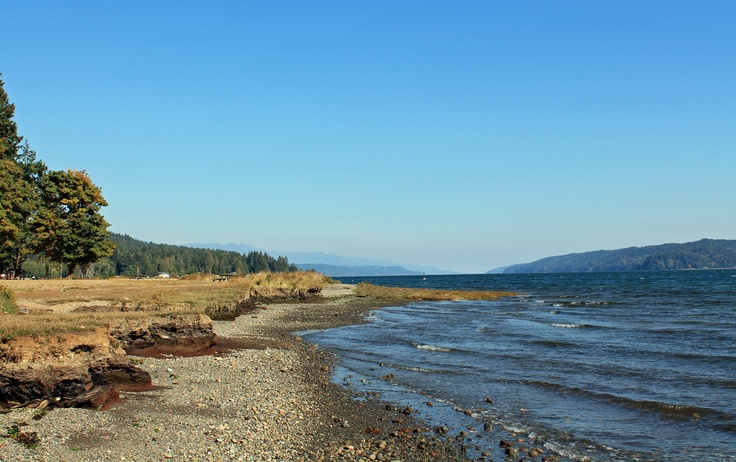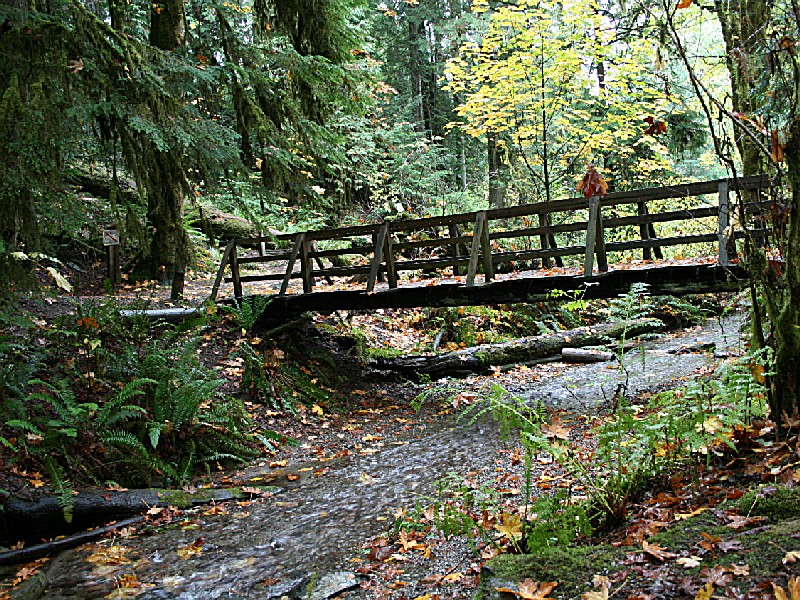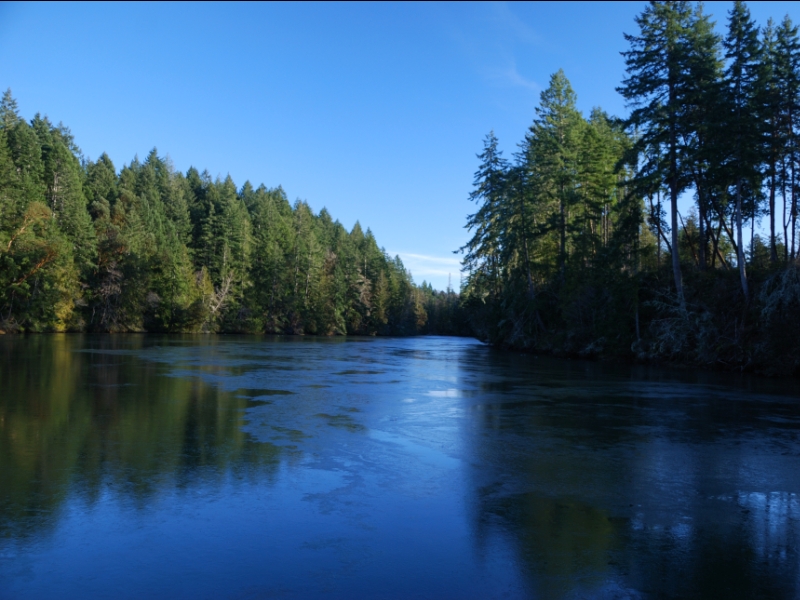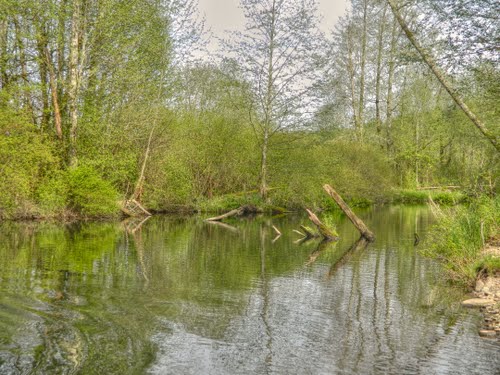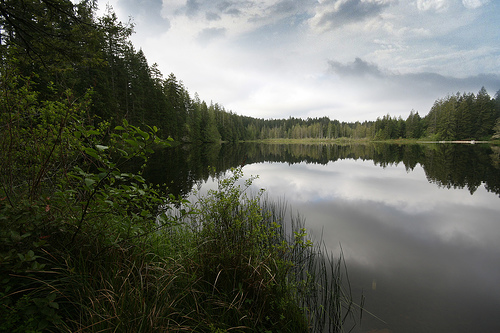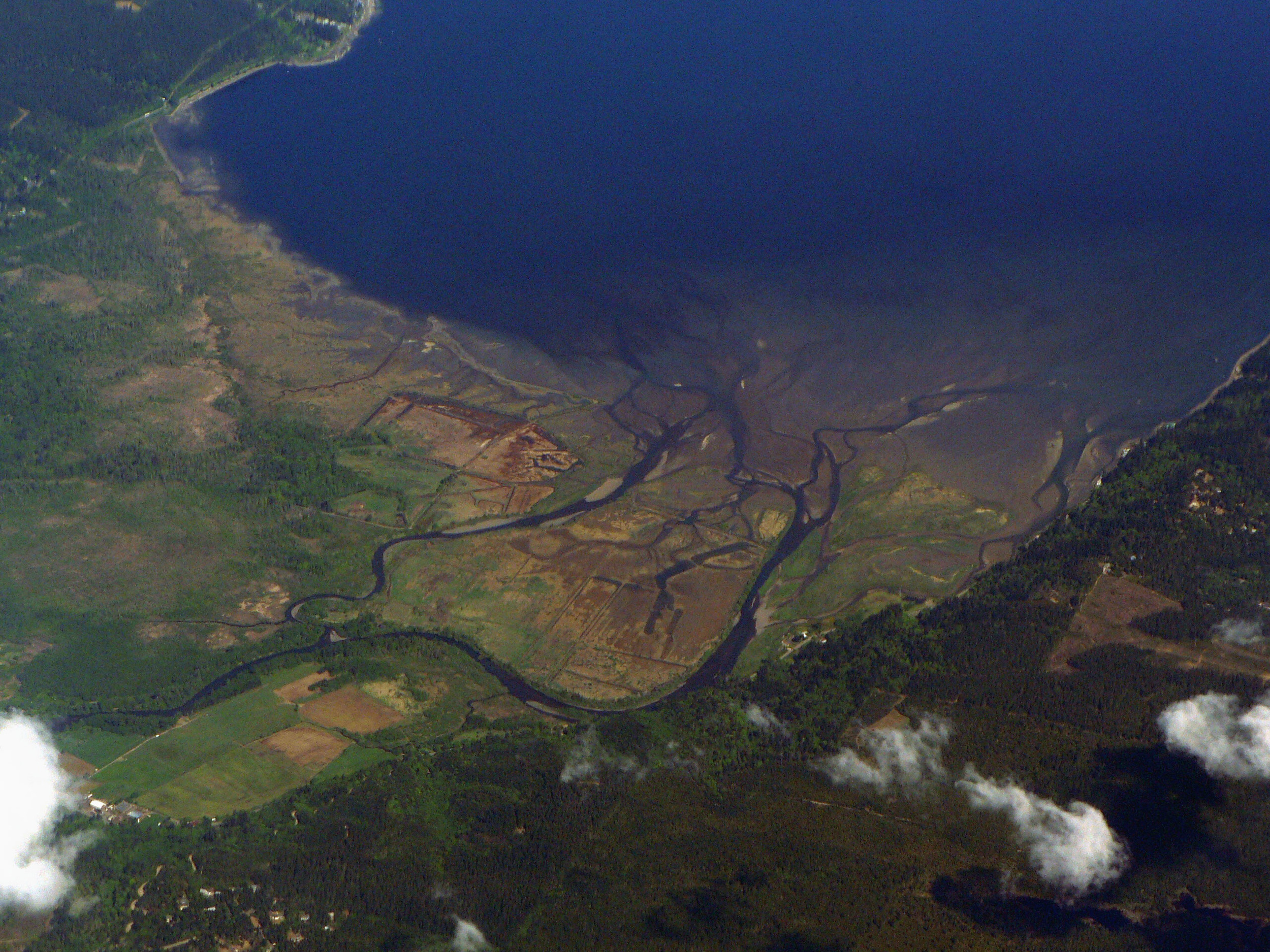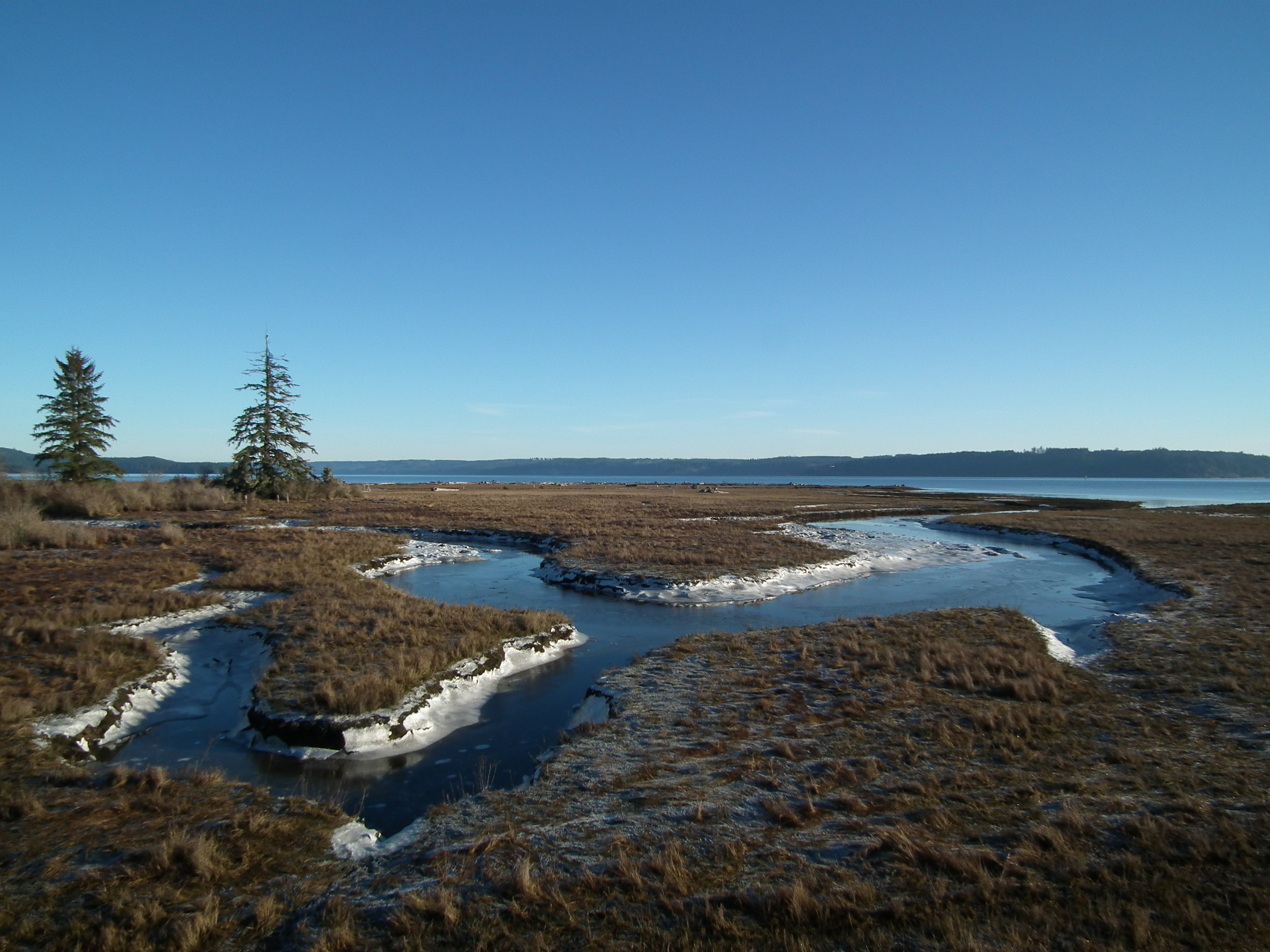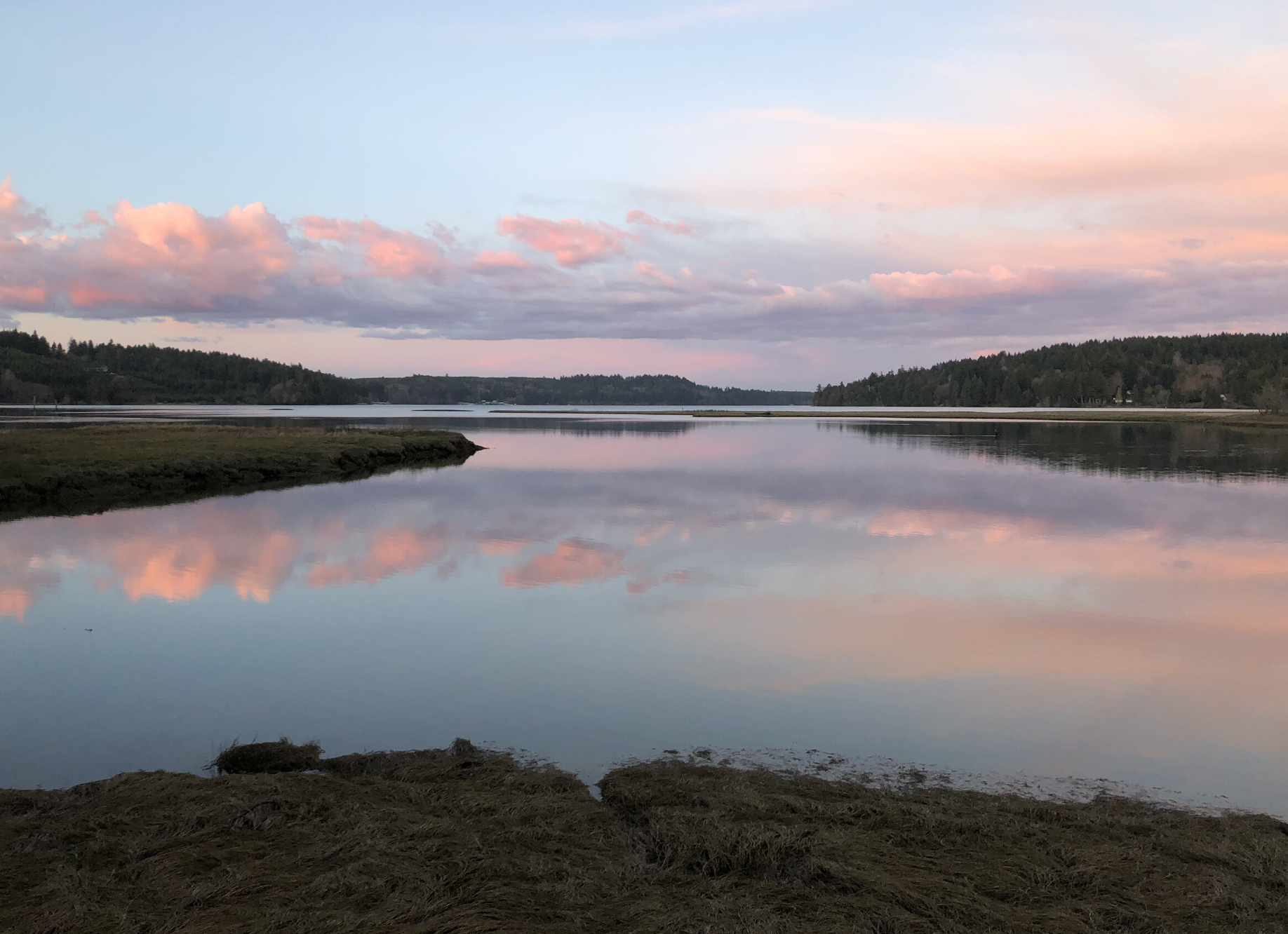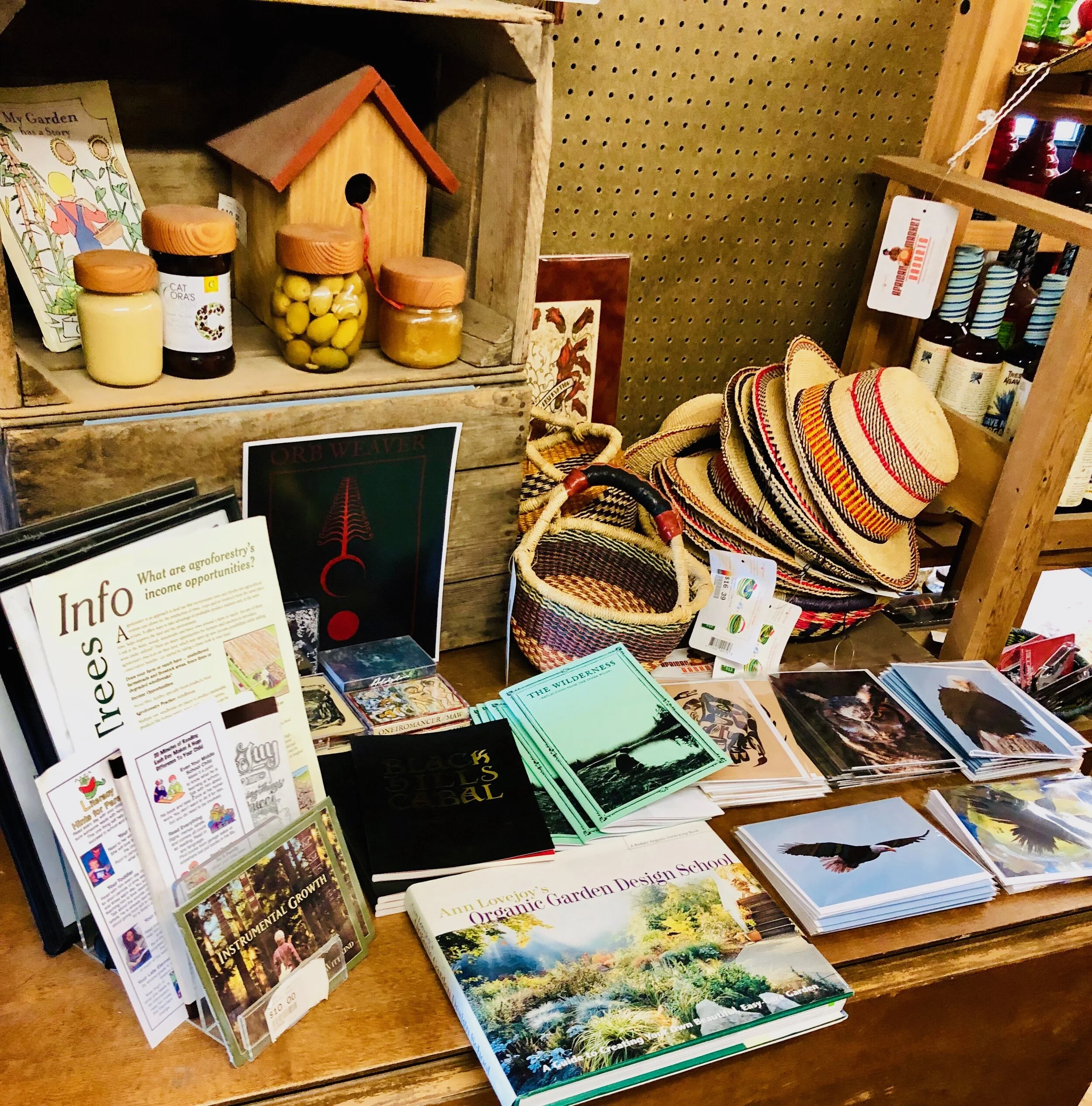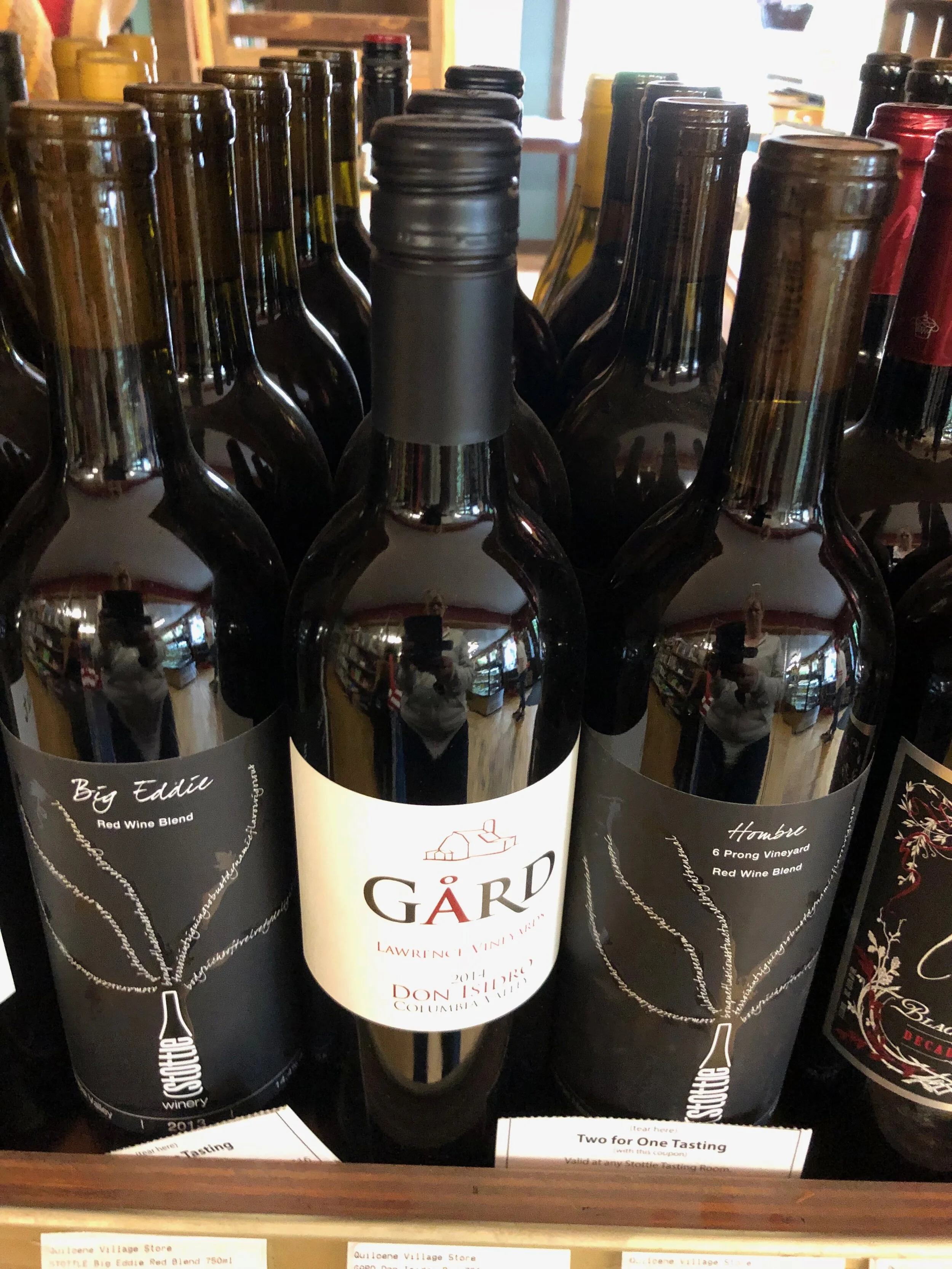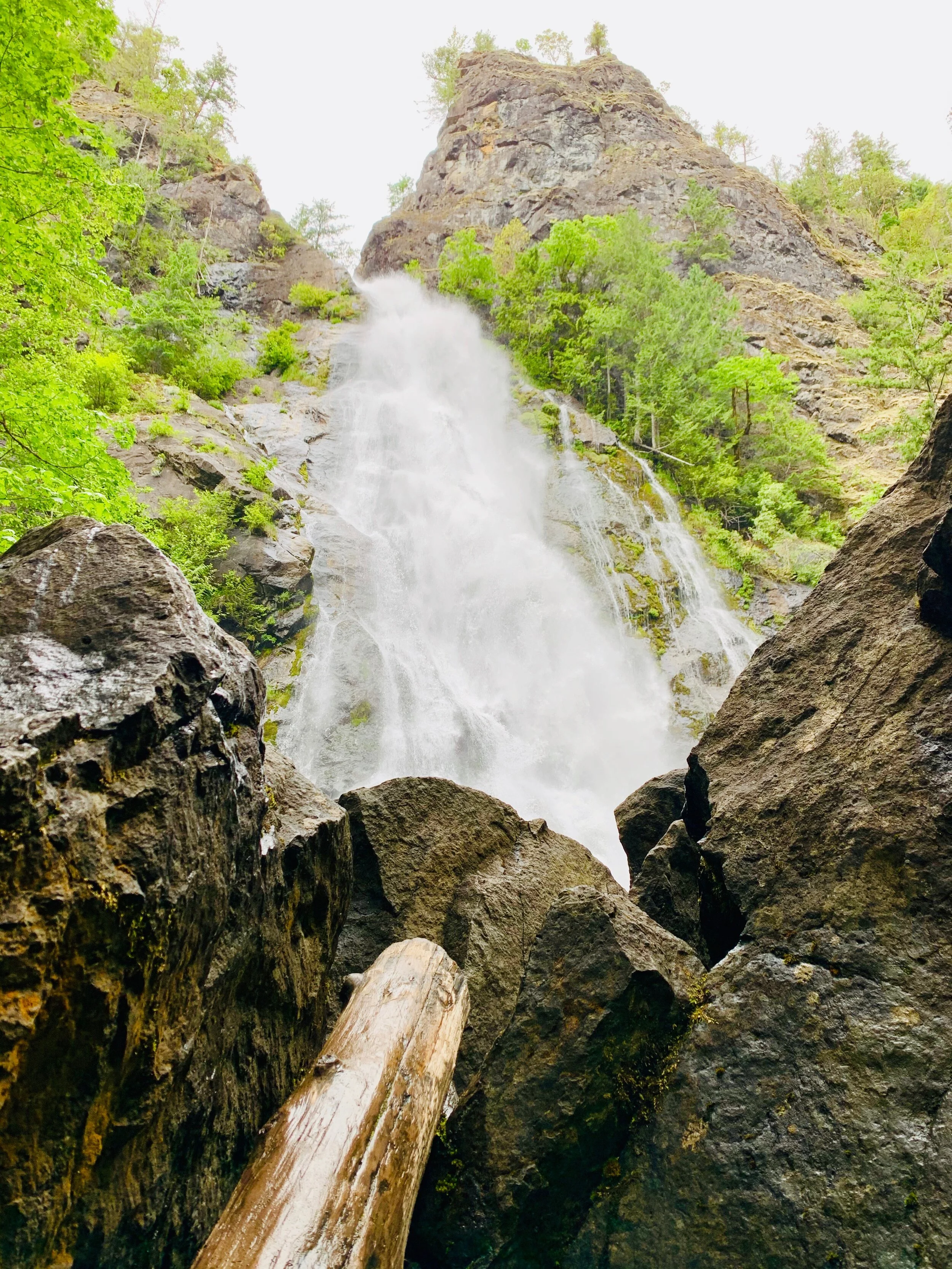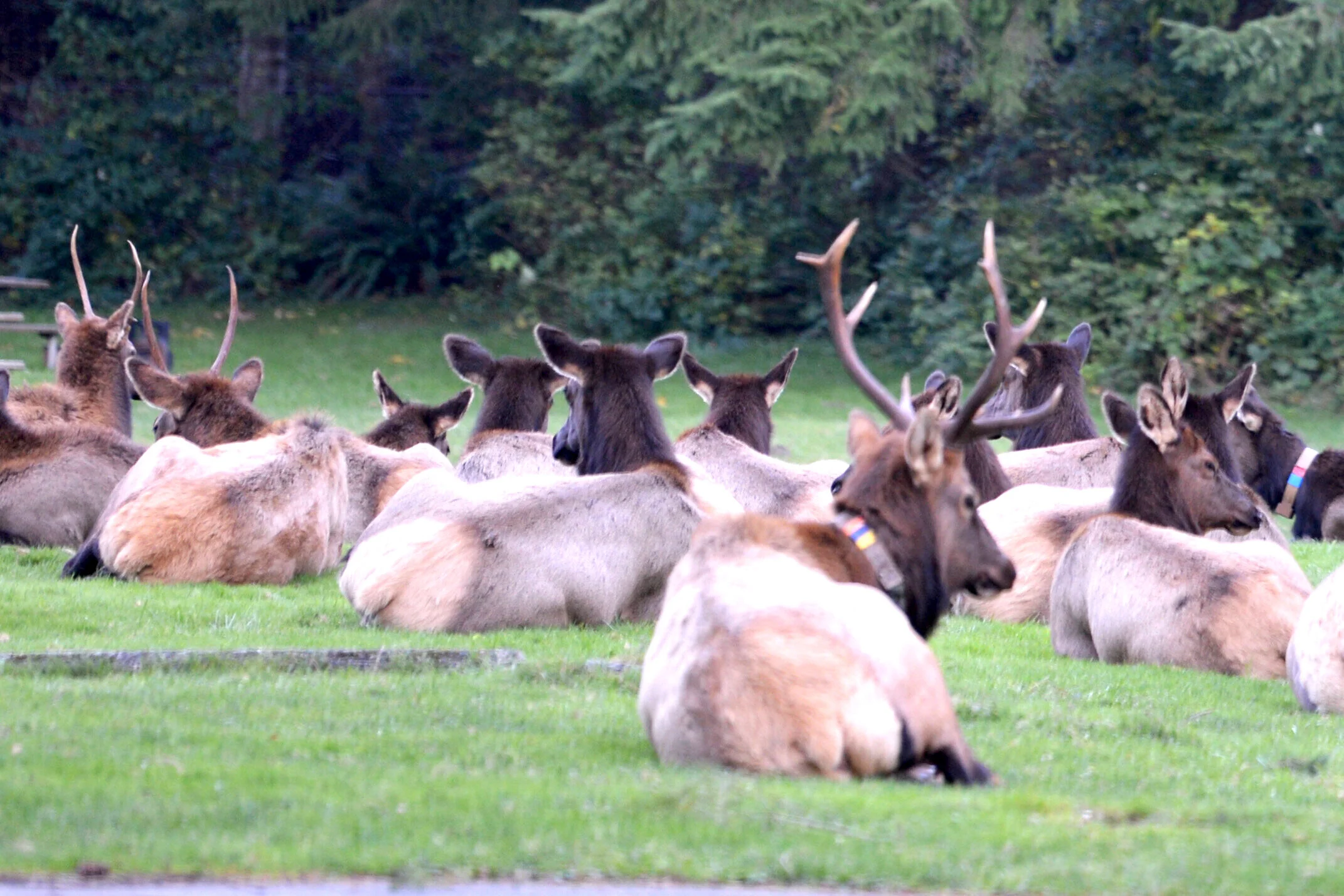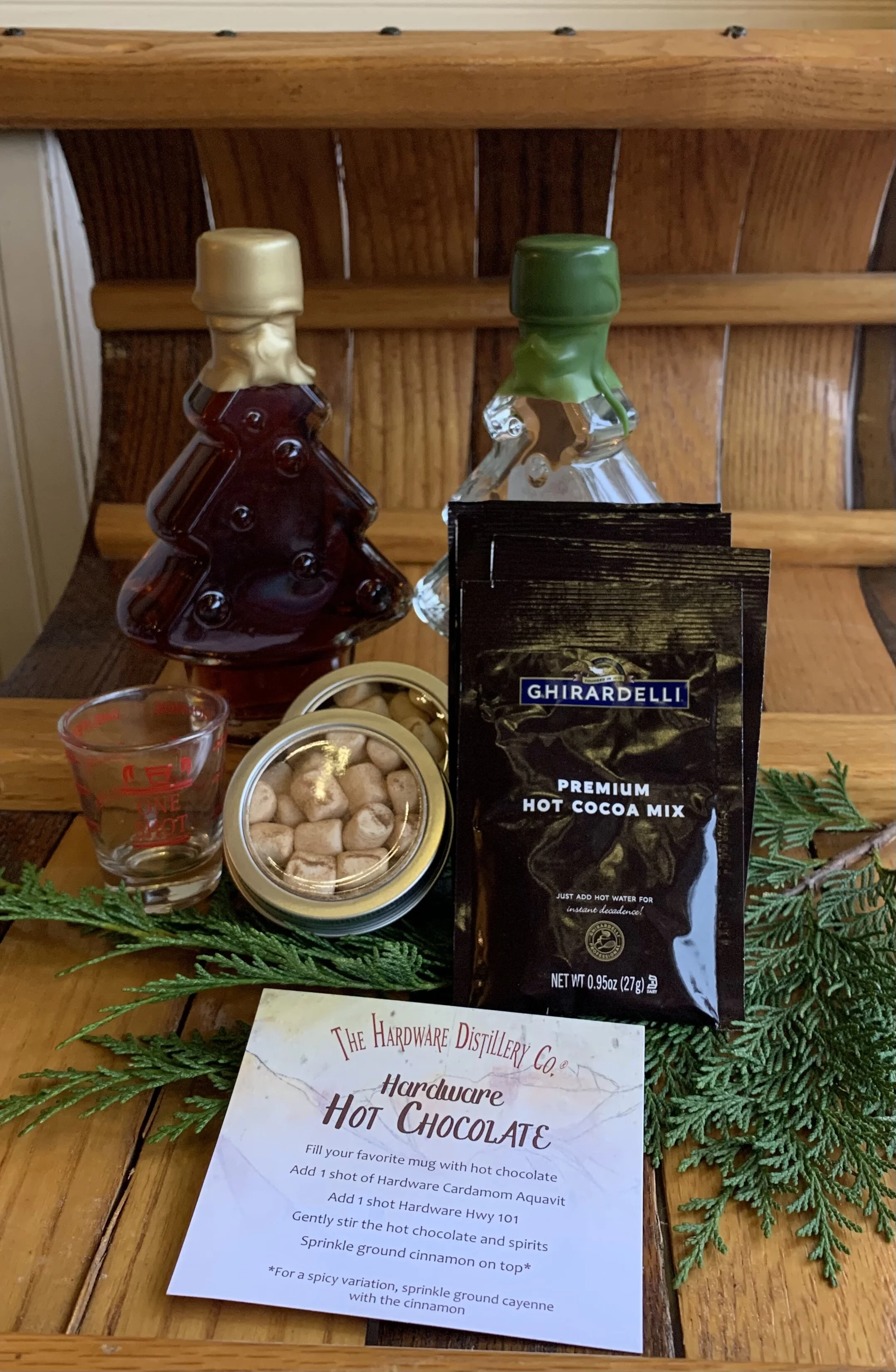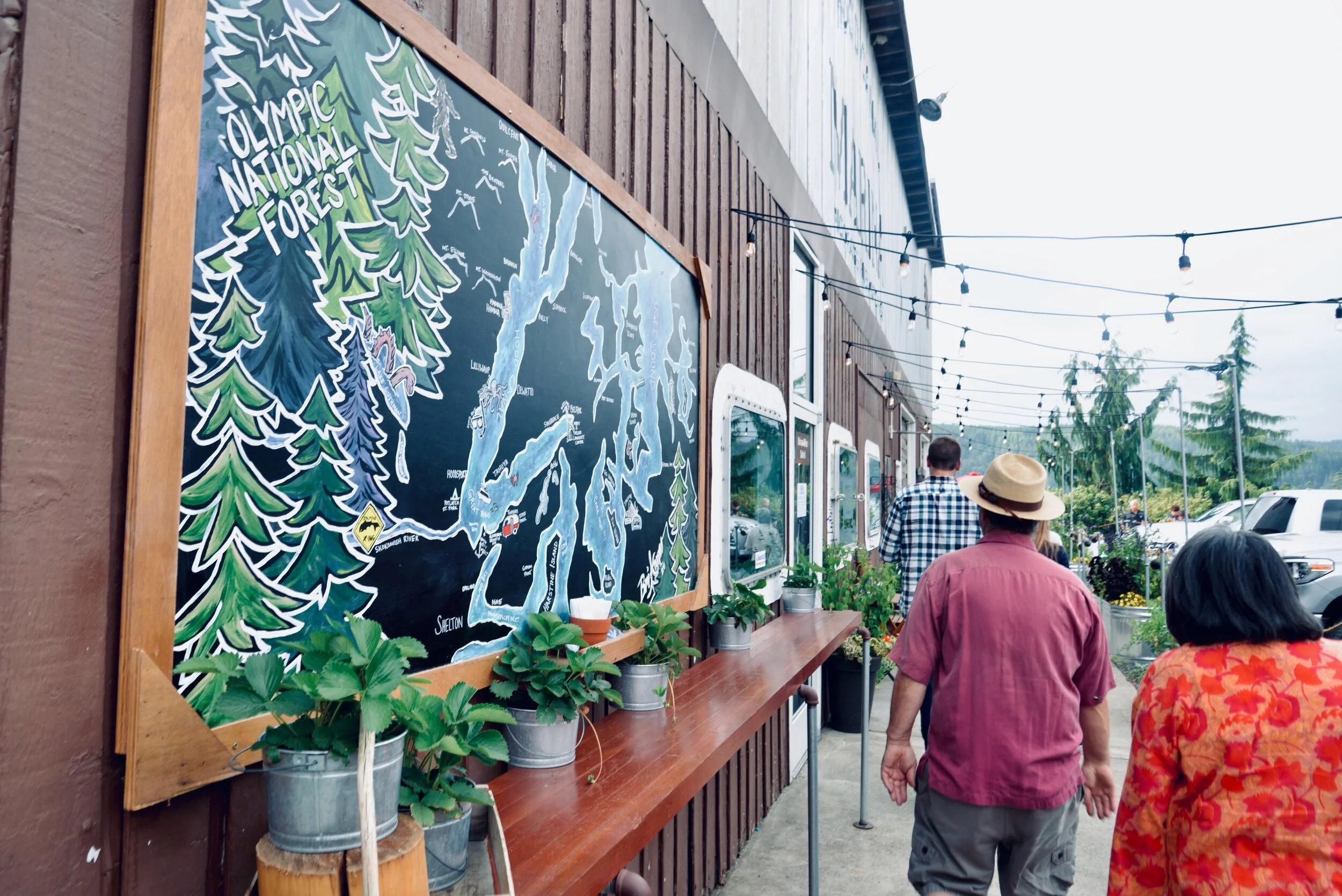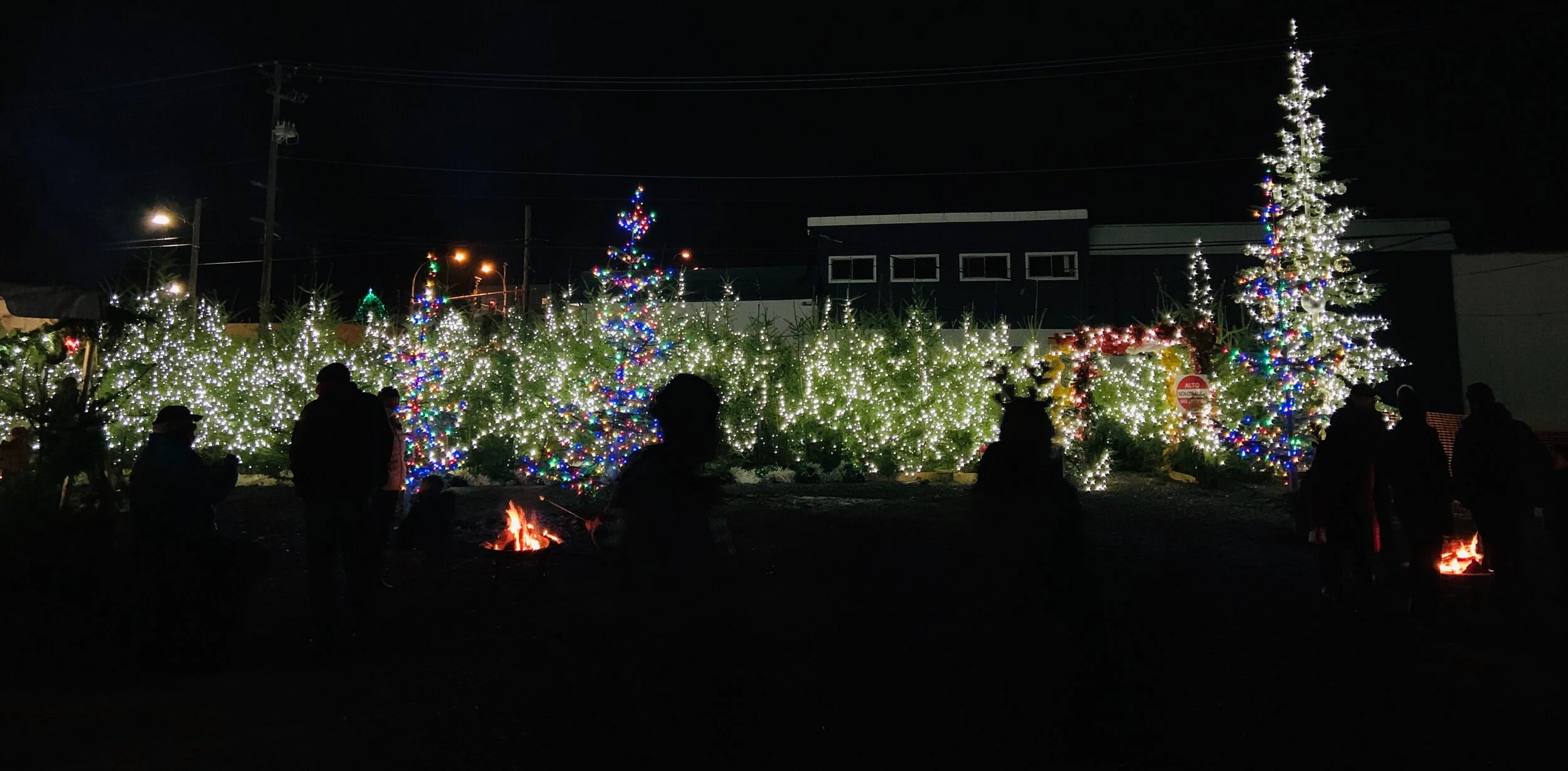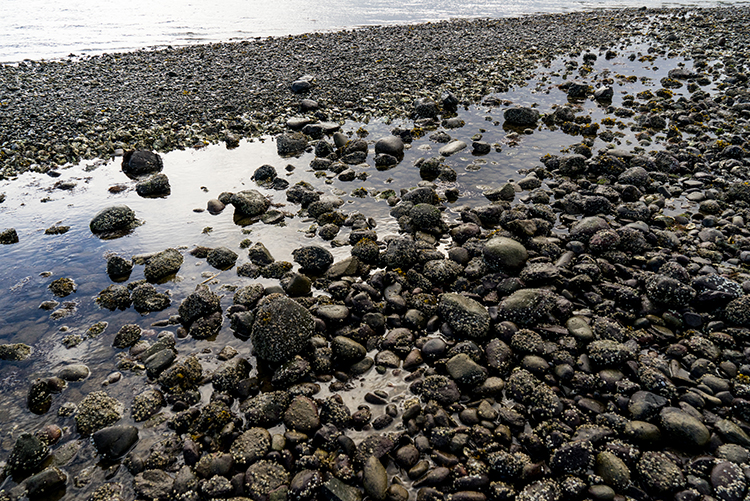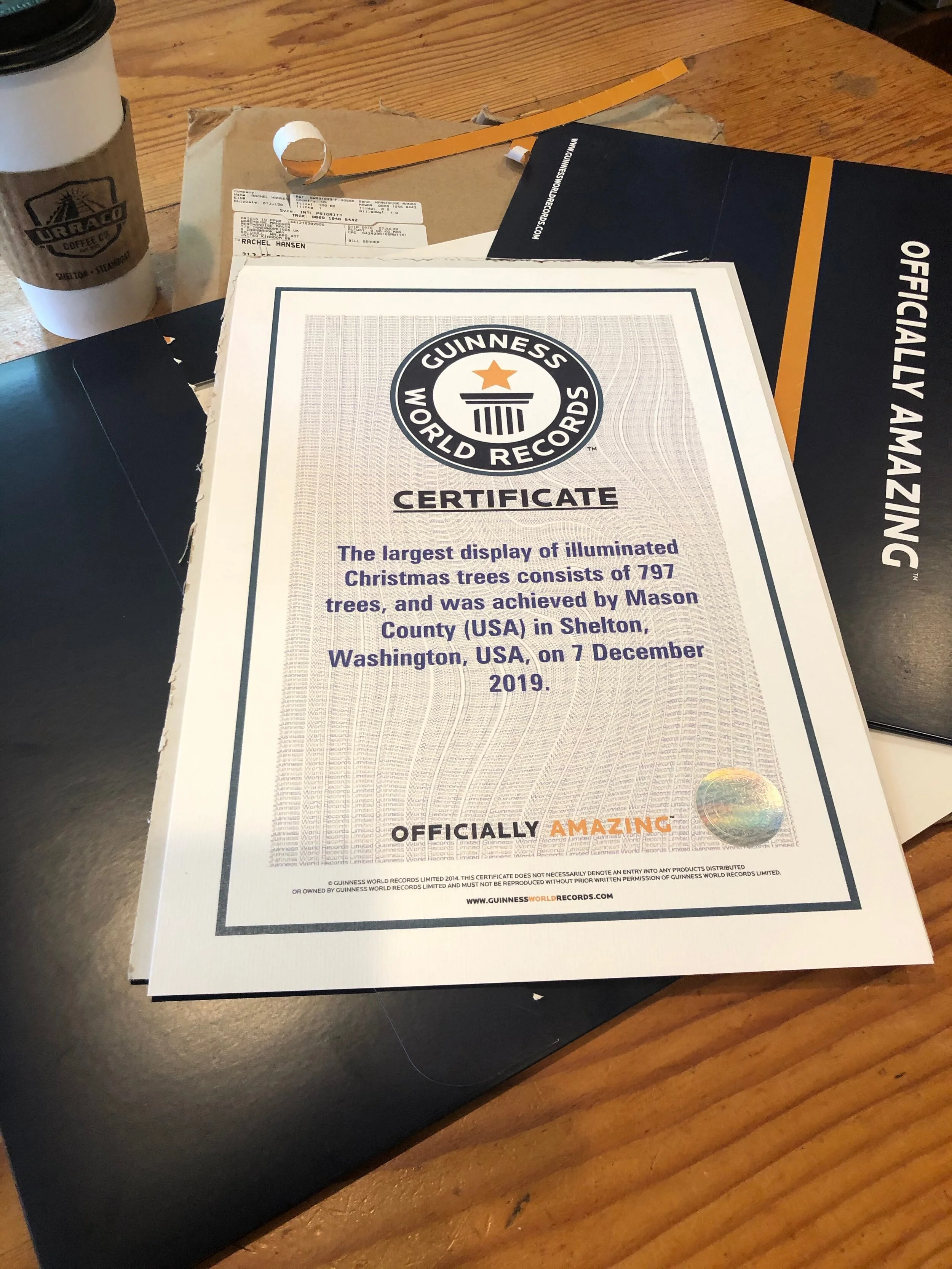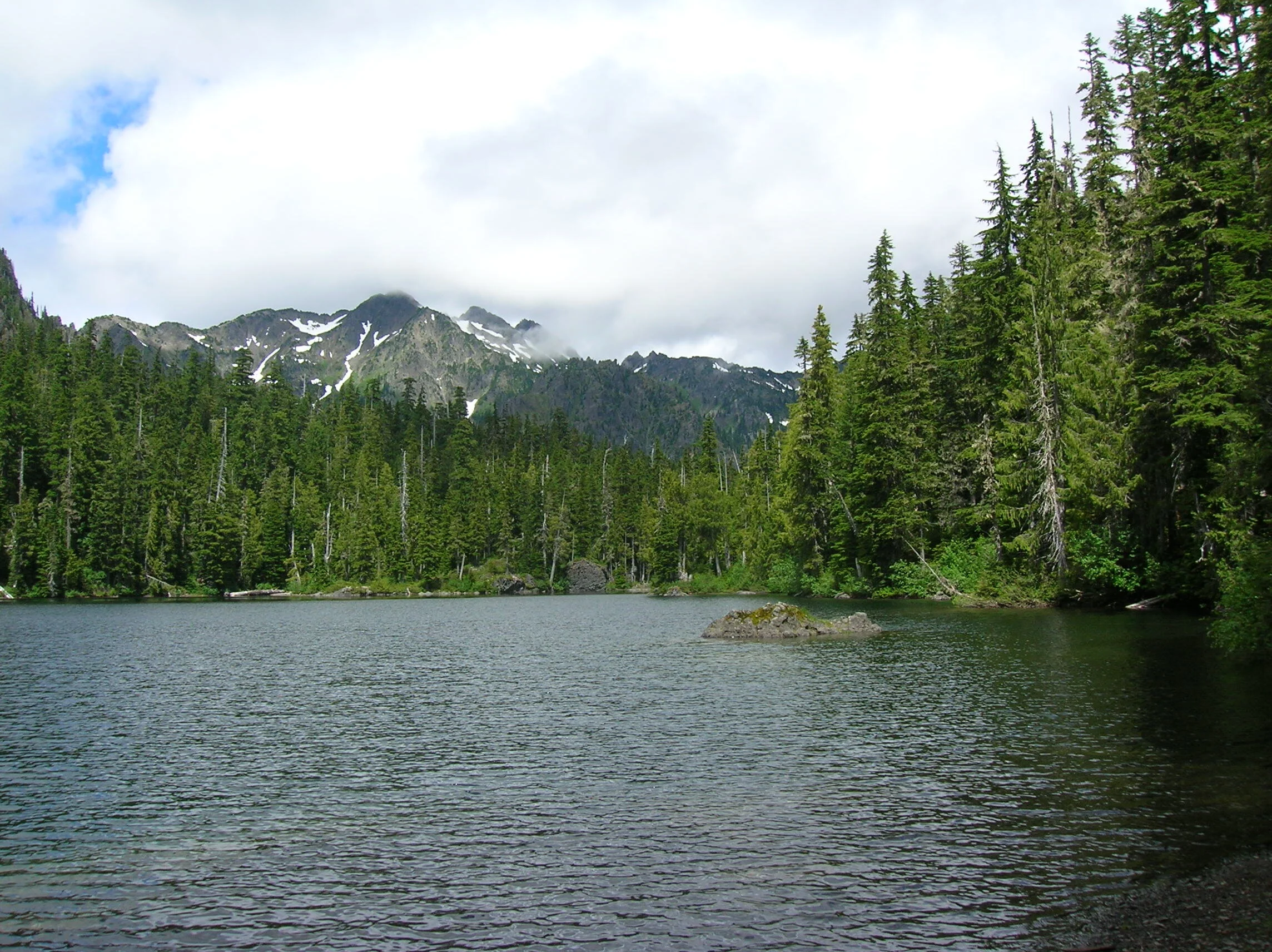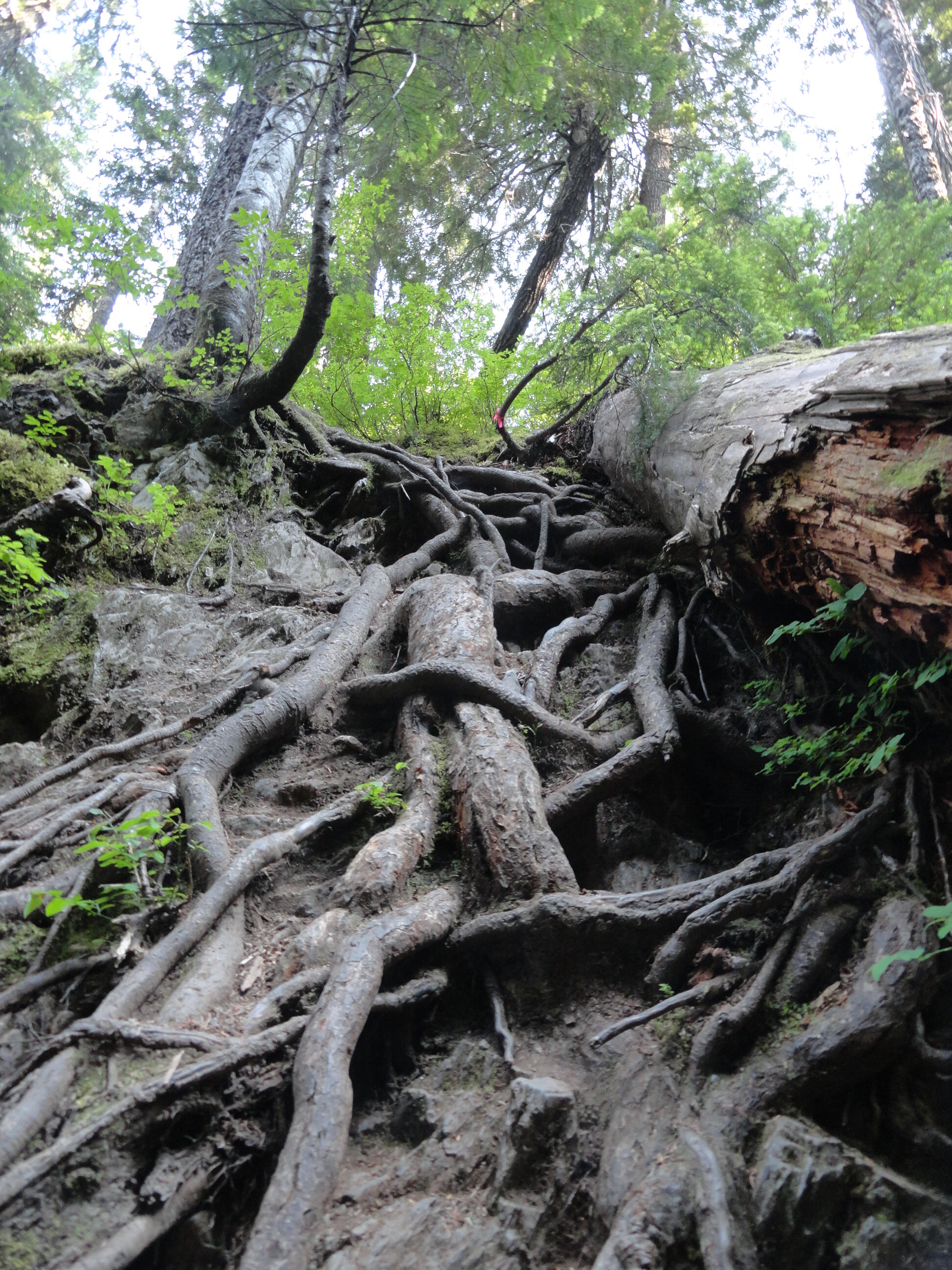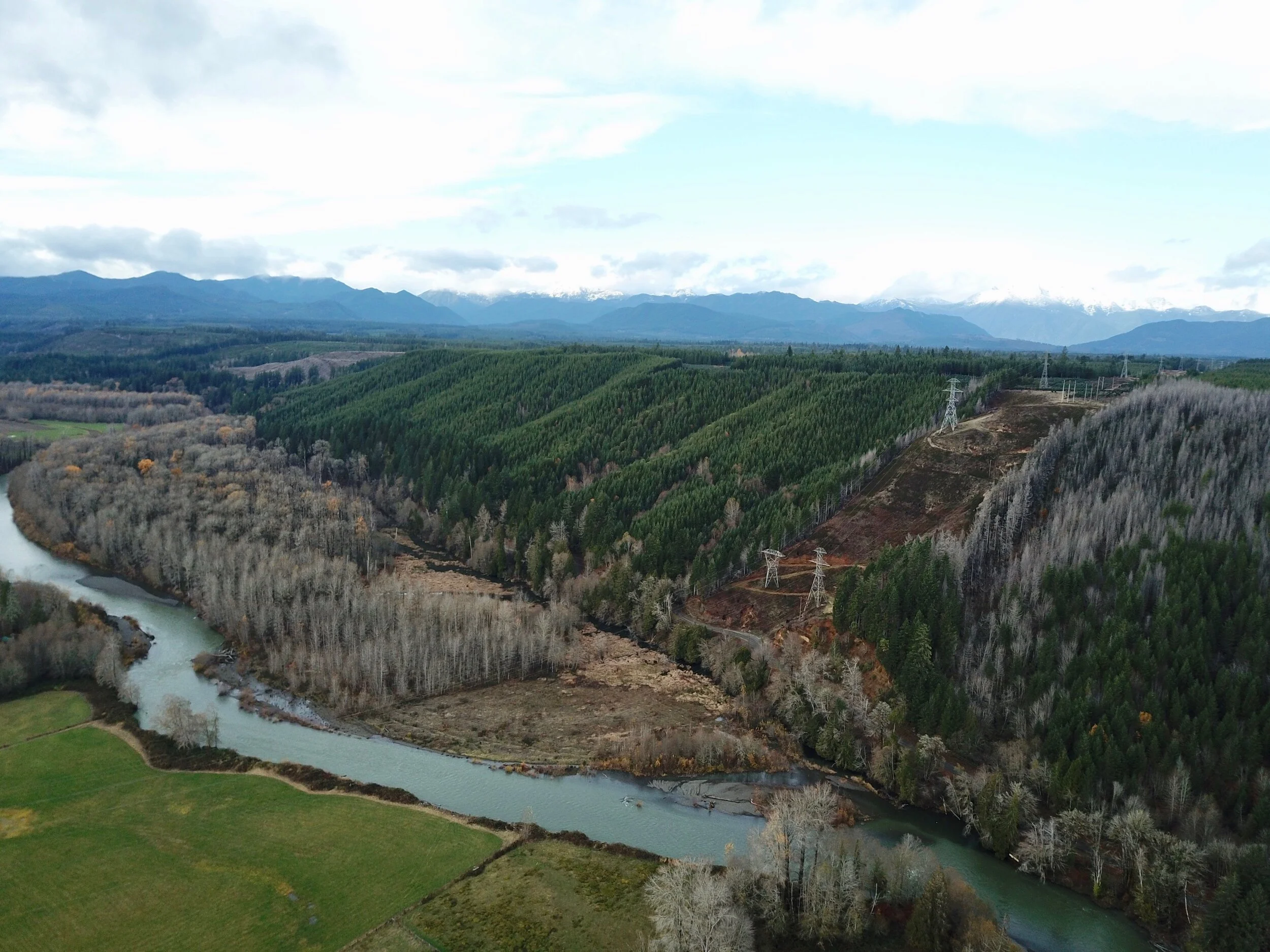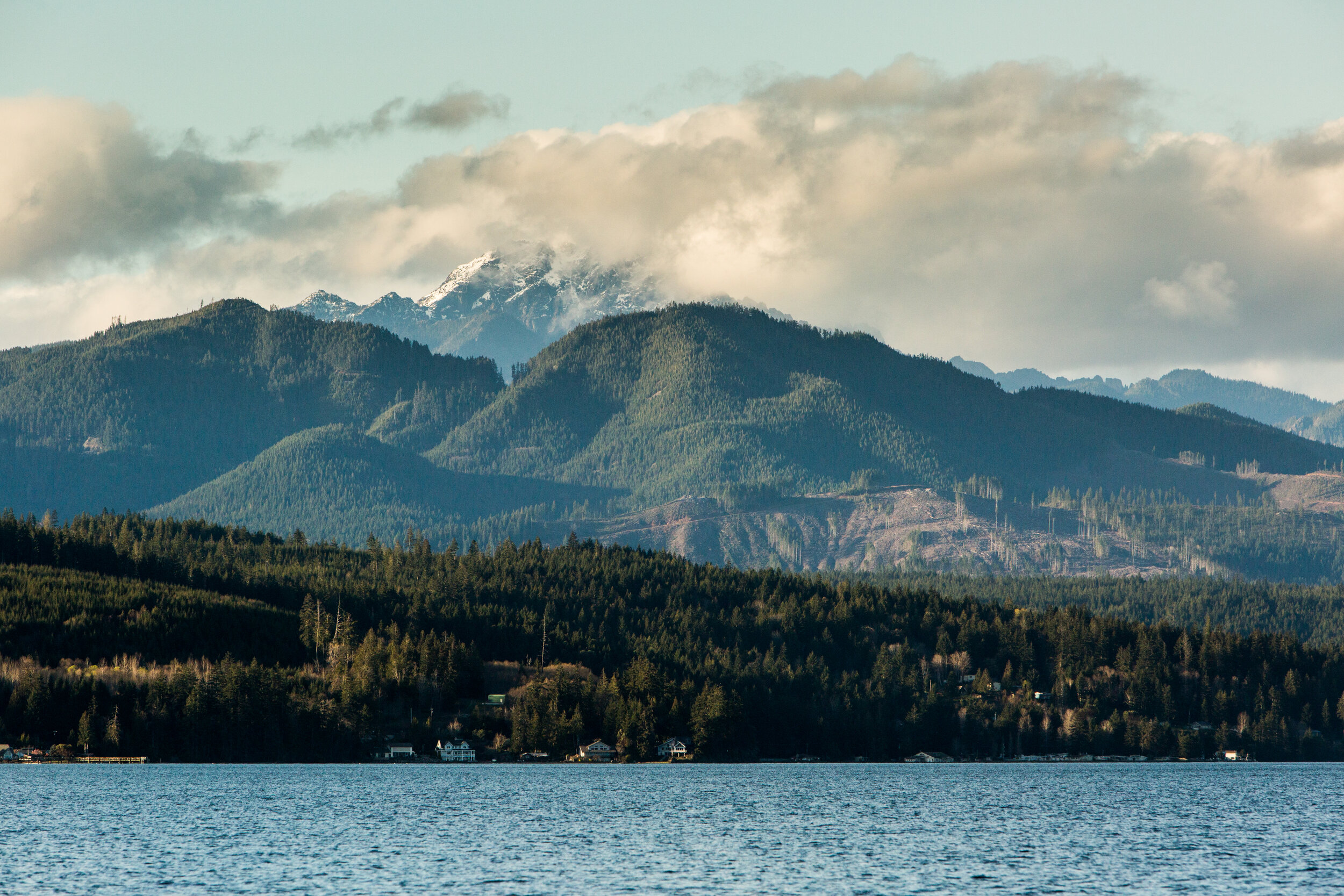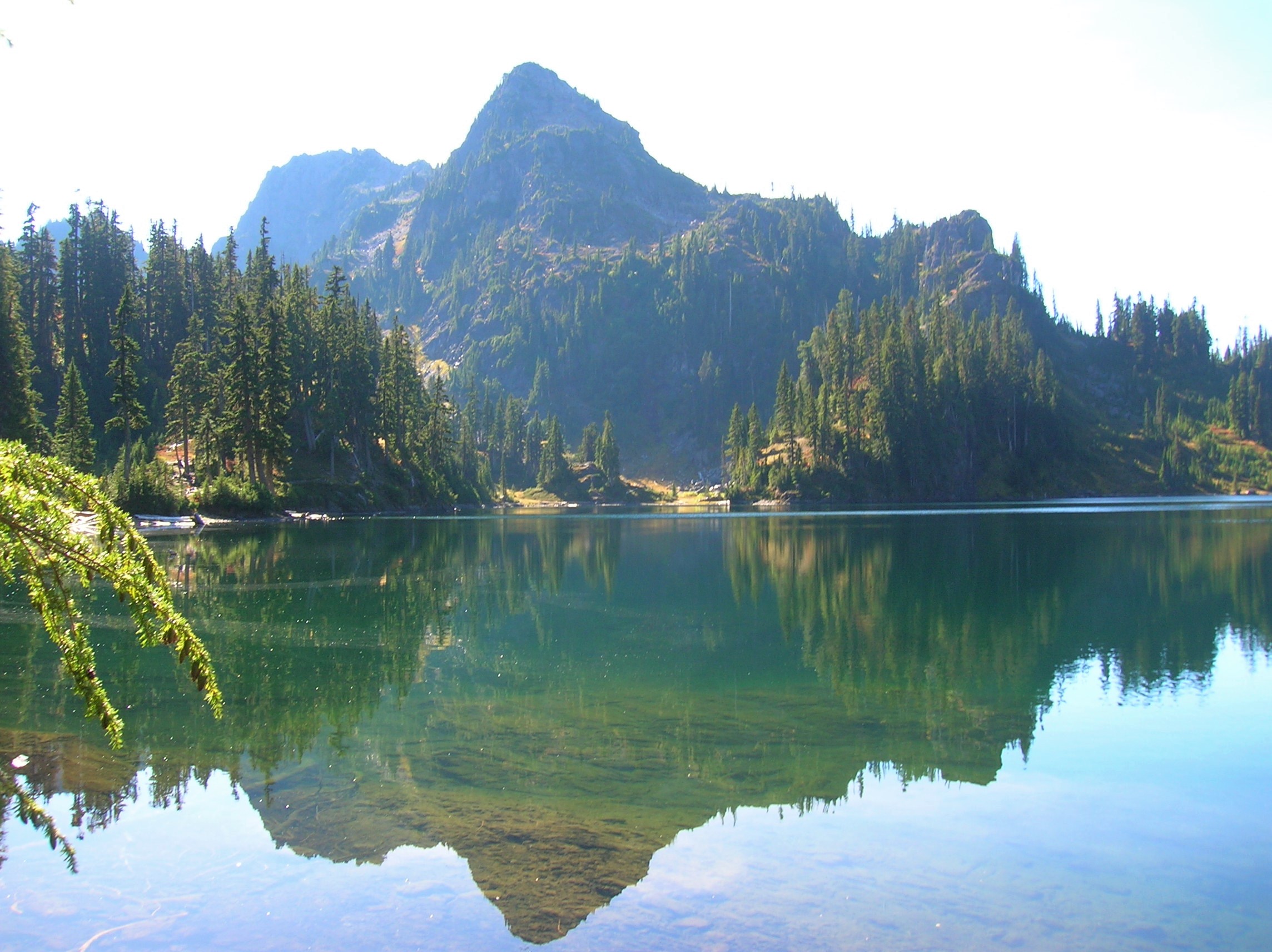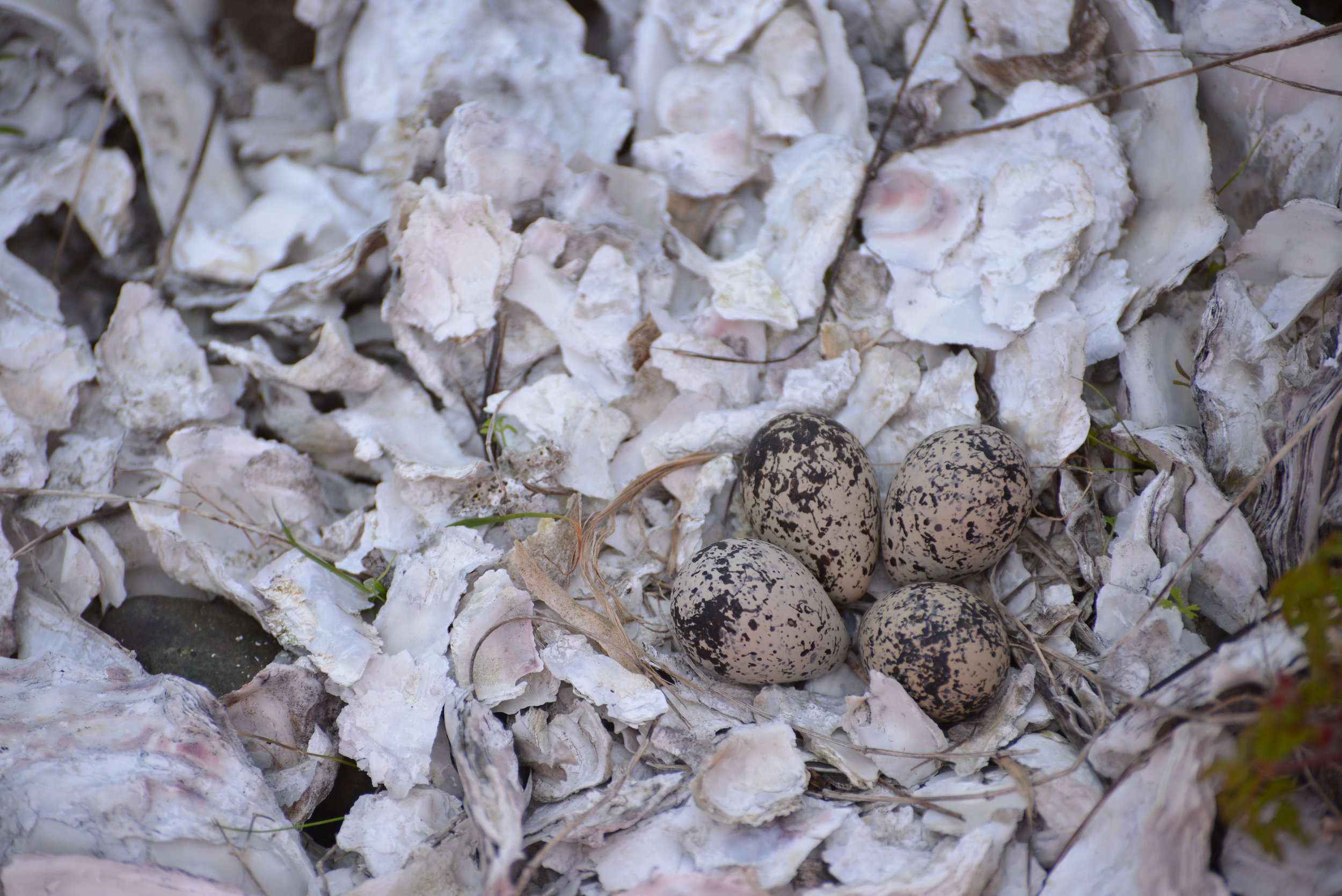
Get Your Carve On: George Kenny’s Chainsaw Carving School
That funky wooden bear was a staple to your grandparent’s front yard, and there’s always the one quirky neighbor on the block that has one—but did you know there are entire competitions centered on chainsaw carvings? Did you know there exists a chainsaw carving school in Allyn that will teach you how to make one of your own? Truth and truth.
That funky wooden bear was a staple to your grandparent’s front yard, and there’s always the one quirky neighbor on the block that has one—but did you know there are entire competitions centered on chainsaw carvings? Did you know there exists a chainsaw carving school in Allyn that will teach you how to make one of your own? And almost always has a live demonstration going on? Truth, truth, and truth.
George Kenny and his wife Diane own a combination wine shop and chainsaw carving school in Hood Canal, and people flock from all over for a chance to have at an old log with a chainsaw. As Brian Ruth, professional chainsaw artist was noted as saying, “If Michelangelo had had a chainsaw, he probably would have used it.”
There’s a whole culture centered on chainsaw carving, and George is equipped with over 20 years of experience creating and teaching. His introduction class teaches a myriad of skills and equips students with the know-how to keep at this quirky art form.
At the time of its first settlement, the Olympic Peninsula depended, and came to thrive on one of its most prolific natural resources—wood. Founded in 1890, Simpson Lumber Company, operating out of Shelton (just a short jump from Allyn) is one of the oldest, continuously operating lumber companies in the Pacific Northwest.
A history rooted in woodcraft breeds artistic culture centered on it. The primitive craft of woodcarving has evolved over time coinciding with the invention of technology like the chainsaw. Contemporarily, chainsaw carving encompasses a sweeping variety of styles, skill levels and themes—some artists prefer to be strictly performance artists.
George Kenny is a wealth of historical, artistic, and technical information when it comes to chainsaw carving. It’s surely reflected in the varied and intricate carvings that fill the yard surrounding his school, and studied by the staggering number of people that have taken his class over the years.
If perusing mind-blowingly intricate, carved wooden oddities is up your alley, the Kennys care to host, boasting an extensive sculpture garden chock full of quirky creations ranging from NW native creatures, to native inspired works of art, to classic bears and more. To peek at this spectacle, stop by any day of the week between 9am and 5pm.
And, at the end of an afternoon poking around all corners filled with over 600 carvings, bounce next door to Top of the Cork for a tasty sampling of locally sourced wines.
There’s never a lack of fun, new, sometimes out-there things to do in Hood Canal. Keep up with us on Instagram, Facebook, Twitter, and Pinterest.
Hammersley paddling race, kayak workshop & SUP clinic
Hammer the Inlet is a new endurance paddling race that follows the curves and bends of Hammersley Inlet on South Puget Sound as the tidal push allowing for a nice glide with current.
This spring, with an event barren landscape looming in our area, the Explore Hood Canal team began brainstorming how we could support local communities and local non-profits bring back some of the energy with Covid-conscience tailored safe events. Paddling events kept rising to the top of the list with their inherit social distancing properties.
Apart the “paddle length distancing” outdoors, Hood Canal and South Puget Sound waterways are pristine, beautiful, and the perfect match for all water skill levels.
Paddling Safety Awareness
Like the trails and parks filling to bursting, Covid restrictions have led to a rise in purchase of personal watercraft but perhaps not an increase in water safety awareness.
Kayaks and SUPs, mass produced for the desperate consumers in dizzying shades of enticing colors, are available at every big box store promising a cheap and easy way to get freedom on Washington’s waterways. Although one can be delighted that sales surged and people got outdoors, the risk associated with little instruction on proper use offered by stores online or giants like Walmart or Dick’s has led to a much more disturbing fallout than litter and over-crowding in our parks. Accidents and drownings statistics in 2020 were so alarming that a Bill was proposed to require safety certification for all people on the water — not just for those in powered boats over 15 HP.
The current rules are simple and common sense should prevail. Life jackets, understand your surroundings, educate yourself about winds, currents, tides, travel in groups and develop a safety plan. But then, who thought we had to tell people to respect the trails?
Opportunities to Educate (and have fun)
Paddling events are a great way to share ideas on skills as well as safety. When the tourism team began researching possible anchor events in the local area, imagine our delight when we found that Salmon Bay Paddle had included Hammersley Inlet in their paddling competition series and has included a sea kayak paddling clinic in their events in Shelton.
Fiona Wylde SUP Racing Clinic | May 7
Cost: $40 per person / Max 20 participants / Open to: All skill levels welcome from novice to experienced racer. Participants use own gear.
To register email in advance.(Payment methods accepted: Cash, Venmo, Paypal)
Salmon Bay Paddle is the leading provider of personalized private one on one and small group stand up paddle board (SUP), kayak and surf ski lessons in the Pacific Northwest. Owner, Rob Casey, is the author of two paddling books and is considered a pioneer of stand up paddling by Stand Up Journal Magazine. Rob and his certified coaches travel all over the Northwest offering paddling skills and safety classes to everyone from beginner to advanced paddler.
Salmon Bay Paddle’s event in Shelton (May 7-8) includes guest speaker, ICF World Champion Fiona Wylde, hosting a SUP Racing Clinic Friday May 7 (5-7pm) at the Shelton Yacht Club; the Hammer the Inlet Race beginning at 10:15 am, May 8; and on-site Kayaking Clinics beginning at 9 AM.
Hammer the Inlet
Saturday – May 8, 2021
Heat Start Times: 10:15 AM to catch end of the ebb current.
Hammersley Inlet hosts some notoriously swift tidal currents that can work with - or against - the paddler. | photo Rob Casey, Salmon Bay Paddle
Hammer the Inlet is roughly a 15.3 mile race in swift tidal current on Hammersley Inlet in South Puget Sound. Beginning at Shelton’s yacht club, paddlers will take the 1.9 knot ebb out from Shelton and the 1.4 knot flood current back up the winding picturesque inlet to where it empties into lesser Puget Sound.
Paddlers call this run the ‘Hammersley Shuttle’ for the tidal push allowing for a nice glide with current. Back eddies and eddy-lines add a little spice or challenge around the various bends and curves at Skookum and Libby Points and Cape Horn.
All human powered paddling and rowing craft that can self rescue ae welcome to participate in this race. The cost is $45/ single person craft, $55 /double person craft. The fee increase on May 7th ($55 1p, $65 2p) with registration ending Friday at 7 PM.
Salmon Bay Paddle has arranged a motel discount for racers (10% off) a the Shelton Inn but there is plenty of lodging locally at waterfront Short Term rentals as well as lodging on nearby Hood Canal. Visit Explore Hood Canal’s lodging pages for an overview.
Shelton Pop UP Kayak Clinic
An adventure seeker, Robert has paddled much of the Puget Sound, kayaking and camping year-round, navigating tidal currents, wind, rough water, and large, open-water crossings. He is an ACA certified instructor, member of Washington Kayak Club, and instructor with the North Sound Sea Kayaking Association. He is a member of Qajaq USA. When not on the water, he’s looking out to it, writing from his home off Poverty Bay in Des Moines, WA.
Salmon Bay Paddle instructor, Robert Nissenbaum, will provide kayak lessons during the race limiting each clinic size for safety. All kayak instructors are ACA certified. Must book 48 hours before start of clinic to hold your spot. Call (206) 465-7167 for questions.
Clinic Schedule
9-11 - Kayak Basic Stroke Clinic
11-12 - Kayak gear and outfitting session
12-1 - Lunch / Break
2-4 - Kayak rescues and recoveries
A portion of proceeds from this event are donated to the South Puget Sound Salmon Enhancement Group.
Shrimp Season on Hood Canal
WDFW recently announced that Hood Canal will open next month for recreational spot shrimp fishing. We’re celebrating the news by sharing some great recipes from local celebrity chef, Xinh Dwelley.
WDFW recently announced that Puget Sound will open for recreational spot shrimp fishing beginning May 19.
Marine Area 12 (Hood Canal Shrimp District): Open from 9 a.m. to 1 p.m. on May 19, May 22, June 2, June 5, and June 16.
In all areas of Puget Sound, fishers are limited to 80 shrimp per day on open days in May. Fishers may keep dock, coonstripe, and pink shrimp caught incidentally while fishing for spot shrimp, but they count toward the 80-shrimp limit. Beginning June 1, the daily limit is 10 pounds of all shrimp with a maximum of 80 spot shrimp.
A valid 2021-22 combination license, shellfish license, or Fish Washington license is required to participate in all shrimp fisheries. More information on recreational shrimp seasons, and a description of the marine areas, is available on WDFW's recreational shrimp fishing website.
Shrimp & prawn recipes
Thanks to local celebrity chef, Xinh Dwelley, here are a few delicious ways you can prepare and serve your Hood Canal bounty!
Crunchy Sweet Coconut Shrimp
Of all the recipes tasted for Xinh’s recently published cookbook, this was definitely a favorite. Easy, attractive, and a crowd pleaser – this simple but delicious creation would be good as a starter or for dinner!
2 lbs shrimp
2 cups panko
2 cups shredded coconut
3 Tbsp flour
2 eggs
1 cup coconut milk
3 Tbsp cornstarch
1 tsp garlic, minced
1 tsp lemongrass, finely chopped
1 Tbsp soy sauce
1 tsp salt and pepper, or to taste
Peel, devein prawns, leave tails on, and set aside. Make egg wash by combining eggs, coconut milk, cornstarch, garlic, lemongrass, soy sauce, salt, and pepper. Mix pan-ko, flour and shredded coconut together in another bowl to create breading mixture. Dip shrimp in egg wash. Then dip in the breading mixture. Arrange on cooking sheet and refrigerate for at least 15 minutes to help breading stick to shrimp. You could prepare in advance and cook when serving. Heat a few inches of canola oil to 375°F. Place shrimp into oil and cook until golden brown.
Prawns in Tamarind Sauce
2 lb prawns
⅓ cup white onions, chopped
1 Tbsp garlic, minced
1 Tbsp lemongrass, minced
1 Tbsp canola oil
1 tsp dry Italian seasoning
1 tsp cumin
1 pinch crushed dried cayenne pepper
1 cup crushed pineapple in its own juice
2 Tbsp tamarind concentrate
1 Tbsp fish sauce
1 Tbsp brown sugar
1 cup mushrooms, sliced
1 cup celery, sliced
1 cup carrot, sliced
1 cup coconut milk
1 whole medium tomato, sliced into wedges
2 Tbsp fresh Thai basil, chopped (garnish)
2 sprigs scallions, thinly sliced (garnish)2 Tbsp cilantro, chopped (garnish)
Peel and devein prawns and set aside. Sauté garlic, lemongrass, and white onion in oil until golden brown. Add Italian seasoning, cumin, cayenne pepper, pineapple, coco-nut milk, tamarind concentrate, fish sauce, and brown sugar. Simmer for 5 to 10 minutes. Add prawns and sauté for 2-3 minutes. Add remaining vegetables and mix gently until prawns and vegetables are cooked. Garnish with Thai basil, cilantro, and scallions. Serve with Jasmine rice.
Easy and Delicious Pad Thai
Xinh’s Pad Thai stir-fry dish made with rice noodles, fresh vegetables, peanuts, and prawns/shrimp all mixed together with a spicy and sweet sauce is surprisingly easy to make and can be customized with any vegetables or protein you wish – prawns, shrimp, chicken, tofu – and spice level you prefer.
1 lb prawns
1 Tbsp soy sauce
1 Tbsp fish sauce
1 Tbsp oyster sauce
1 Tsp garlic, minced
1/4 cup Tamarind concentrate Pinch red pepper flakes Juice of 1/2 lime
3 Tbsp canola oil
16 oz package of pad Thai noodles
2 cups Napa Cabbage, shredded
1 cup bean sprouts
1 cup pea pods
1/2 cup onion, sliced
1/2 cup carrots, cut in matchsticks
3 green onions, chopped
1/2 cup garlic chives, chopped (optional)
Peel and devein prawns and set aside. Place noodles in hot boiling water for 3-5 minutes, or until they “relax,” and then drain. Set aside. In a bowl mix soy sauce, fish sauce, oyster sauce, tamarind, red pepper flakes, and lime juice. Using a large wok or large frying pan on high heat, saute garlic, carrots, cabbage and onions in oil until vegetables reduce (about 5 -7 minutes). Add noodles. Turn mixture with tongs and wooden spoon, Add beans sprouts, pea pods, green onions, and chives. Cook, turning often until incorporated (about 5 minutes). Remove from heat. Saute prawns in oil until cooked. Add prawns to mixture and toss well. Serves 4.
About Xinh
Chef Xinh Dwelley was born in South Vietnam, in a village near Siagon, where she discovered her natural talent of making people happy with her food as she cooked for an entire U.S. battalion. When she moved to Washington in 1970, she sold her spring rolls at the Olympia Farmers Market, and became an ace oyster shucker, winning the West Coast Oyster Shucking Championship at OysterFest five times in a row.
She finally found her home at Xinh's Clam & Oyster House in Shelton, WA. This book celebrates 25 years of favorite recipes and memories.
Do the dirty work to protect and preserve
Hood Canal Salmon Enhancement Group has volunteer opportunities available to enhance salmon habitats on the Union River on Hood Canal. Consider vacationing in the area and doing some good for the fjord.
Salmon are a keystone species and the foundation of Pacific Northwest culture, and the Hood Canal Enhancement Group has been working hard to change the projection of their uncertain fate through riparian enhancement and weed control. Interested in helping out? The Salmon Center has plenty of opportunities for families and individuals to sign up - for a day, or week - to volunteer and help these precious resources.
Saving our Salmon Habitats
In addition to Chinook, Coho, Pink and the occasional Sockeye, Hood Canal is home to Endangered Species Act listed Puget Sound steelhead and listed Summer Chum, the latter of which is a completely unique species to this watershed. Structurally mature and diverse streamside plant communities not only increase the likelihood that salmon will continue to survive for future generations, but that the entire ecosystem will remain resilient against the effects of a changing climate.
Riparian habitat is the transitional area between land and aquatic ecosystems; therefore, the work in this program mainly takes place along rivers, streams, wetlands and estuaries. These are critical habitats for salmon and steelhead where they are born and die, and where they grow strong for their journey out into the ocean. Riparian habitat provides essential services and functions for fish, such as food; clean, cold water; large woody debris recruitment; and habitat complexity.
Without these, our salmon and steelhead populations would cease to exist, along with hundreds of species, the culture, and economy that depends on their survival.
Enhancement Group’s riparian enhancement program
HCSEG’s riparian enhancement program serves to protect and restore these services and functions, which can be understood by 4 broad categories: provisioning - the production of food and water; regulating - the control of climate and disease; supporting - nutrient cycles and oxygen production; and cultural - spiritual and recreational benefits.
“Salmon are a keystone species and the foundation of our sacred Pacific Northwest culture, and we have been working hard to change the projection of their dismal fate through riparian enhancement and knotweed control. “
The World Conservation Union lists invasive knotweed as one of the world’s worst 100 invasive alien species. Knotweed spreads aggressively along rivers establishing dense monocultures that reduce native riparian plant diversity, structure and function. Invasive plant species are the second greatest threat to global biological diversity, only second to habitat destruction. In 2020, HCSEG installed 11,000 native plants, restored 0.5 river miles and 9 acres of riparian habitat through new riparian plantings, and the survey and control of knotweed on over 40 stream miles.
In 2021, HCSEG plans to install 17,500 native plants, and restore 1 river mile and 15 acres of habitat through new riparian plantings. All of this work would not be possible without the outstanding help from our volunteer community and our Washington Conservations Corps crew.
“If we plan to install 17,500 native plants this year, we are going to need lots of environmental stewards helping us fight for the future of Pacific Northwest salmon and steelhead.” Salmon Center volunteer
Visit the Salmon Worksites and be inspired to help
If you would like to see this work for yourself, we have several public riparian enhancement worksites that you can visit: Big Beef Creek and Estuary (feel free to park at the gate and walk-in), Seabeck Creek (by the new bridge) and the Union River Estuary Preserve (at the Salmon Center). And while you’re there, consider signing up to join our community of volunteers!
Volunteers make our work possible
From data collection at fish traps, habitat restoration, support at fundraising events, and education programs, so much of what we do is made possible by the dedicated and passionate involvement of our community.
If you have questions about visiting these sites or would like more information about these projects, visit pnwsalmoncenter.org for a full list of staff contacts as well as project descriptions and opportunities to volunteer.
A Quiet trek to Pine Lake
The South Fork Skokomish River Valley offers quite a contrast from the North Fork Skokomish River Valley. Located within Olympic National Forest and not Olympic National Park, the South Fork sees a fraction of the number of folks that visit the North Fork.
Craig Romano | Story and Pictures
The South Fork Skokomish River Valley offers quite a contrast from the North Fork Skokomish River Valley. Located within Olympic National Forest and not Olympic National Park, the South Fork sees a fraction of the number of folks that visit the North Fork. Once a heavily logged area, the South Fork is slowly reverting back to a more natural state. Miles of former Forest Service logging roads in this wildlife rich valley have been decommissioned; some converted into trails. The converted trail to pretty little Pine Lake is a pure pleasure to walk. And surprisingly, the lake is surrounded by beautiful ancient forest. Majestic hemlocks, Douglas firs, and red cedars—just no pines.
Hit the Trail
Much of the South Fork Skokomish Valley in the Olympic National Forest was intensely logged from the 1940s to the 1980s. By the 1990s however timber harvesting on the Olympic and other Western Washington national forests was heavily curtailed due to market place changes and new management objectives favoring habitat protection and recreation. This resulted in the Forest Service decommissioning hundreds of miles of old logging roads. Some of these old roads however presented new opportunities to expand the trail system.
Olympic National Forest once contained hundreds of miles of trails in the South Fork Skokomish and Wynoochee River watersheds. Intensive logging destroyed most of those trails. Forest Service officials and citizen groups now see new opportunities to regain many miles of these lost trails through road conversions. The trail to Pine Lake is one of these new trails. And unlike so many road-trail conversion that simply involves gating the road and removing culverts—the Pine Lake Trail was designed with aesthetes in mind.
The road to trail conversion to this little lake involved constructing bends and curves in the original road bed to better mimic a real trail. And the road bed was restored to original contours in places further obscuring old road cuts.
The Forest Service planted native vegetation along the road bed so that in time it will be very difficult to see that this route was once a wide logging road. And while logging did occur within the Pine Creek watershed, it wasn’t as intense as in some of the smaller watersheds farther south and east. Large patches and tracts of old-growth forest were left uncut. And as the second growth patches adjacent to the primeval tracts continue to mature, evidence of past logging in the basin containing Pine Lake becomes less obvious.
"Surprisingly this trail is not on many hiker’s radar. Come on a weekday and you may have the lake to yourself."
From the small parking area, follow the trail through second growth forest traversing slopes high above Pine Creek. About half way up the trail you’ll encounter a patch of invasive Scotch broom, a plant that crowds out native vegetation in disturbed areas. The Forest Service along with Washington Conservation Corp crews have done a good job at Pine Lake restoring native vegetation. Unfortunately this pervasive and hardy invasive plant has gotten a foothold in this valley. Hopefully they can soon attack the broom before it sweeps across the valley.
At about two miles the trail enters an attractive grove of old-growth forest. The way then steepens a little breaking stride from its relatively gentle grade to this point. In another .75 mile the trail leaves the old road bed to traverse a grove of big trees and descend to Pine Lake. The lake is pretty shallow and surrounded by grasses, sedges and other small plants—many planted by the Forest Service to help rehabilitate the shoreline from past abuses.
Treat the area with respect by sticking to established paths and not trampling vegetation.
Savor the serenity of the scene. Look for resident waterfowl on the lake’s open waters and in its vegetated coves.
Admire the forested hillsides too and Chapel Peak which often reflects upon the lake’s placid waters. Notice too that among the stately conifers surrounding the lake, there does not appear to be any pines. Western white pines valued for their fine wood, were once abundant in the Olympics and Cascades. But it wasn’t logging that erased them from much of these landscapes—but a Eurasian disease, white pine blister rust that decimated stands of this majestic tree.
It’s possible that is what occurred here at Pine Lake. Then again, early pioneers and explorers were also known for misnaming features. There are no badgers in Olympic National Park’s Badger Valley for example nor black oaks growing anywhere near Black Oak Creek in the North Cascades. Perhaps someone named the lake Pine referring to the area’s evergreens as pines. I have seen this mistake numerous times in travel journals and tourism brochures! Anyhow, Pine Lake’s name origins may remain a mystery. But pine or no pines, the lake is a pretty hiking destination. And if you are intent on seeing some beautiful western white pines, nearby Six Ridge in Olympic National Park harbors some healthy stands of them—but it is no easy hike reaching them.
Pine Lake Hike Resources
Land Agency Contact: Olympic National Forest, Hood Canal Ranger District, Quilcene, http://www.fs.usda.gov/olympic
Recommended Guidebooks: Day Hiking Olympic Peninsula
2nd edition (Romano, Mountaineers Books)
Trailhead directions: From Shelton, travel north on US 101 for 7 miles, turning left at milepost 340 onto the Skokomish Valley Road (signed “Skokomish Recreation Area”). Follow for 5.6 miles, bearing right at a V intersection onto Forest Road 23. Continue for 9.3 miles bearing left at Y-junction with FR 2353. Continuing on FR 23 (pavement ends) follow this good gravel road for 4.3 miles bearing right onto FR 2361. Continue for 1.2 miles and turn left onto unsigned Spur 200. Follow .7 mile to trailhead.
Distance: 5.8 miles roundtrip
Elevation Gain: 700 feet
High Point: 1830 feet
Difficulty: moderate
Snow free: Mar—Dec
Trailhead Pass Needed: None
Notes: Forest Road 2361 is gated and closed from October 1 to April 30th to protect wildlife. You can walk or bike the road (adding 3.8 miles roundtrip) during this time to reach the trailhead.
GPS waypoints: Trailhead: N47 26.270 W123 25.678 | Pine Lake: N47 25.839 W123 28.618
Features: kid and dog friendly, backcountry lake in old-growth forest, chances for solitude and wildlife watching
Safe & healthy hiking during the Covid-19
Avoid crowded hiking destinations. If you arrive and the parking lot is already full, head to another location
Opt for weekdays over weekends and/or early morning to hit the trail
Avoid hiking in large groups outside of your family
Practice Social Distancing while on the trail, giving other hikers lots of room to pass and keeping your distance from them at lakes, summits, etc.
Wear a mask when encountering others on the trail. A buff or bandanna works well, and remember to pack hand sanitizer
Pack it in pack it out (including pet waste) and don’t be a surface pooper. Always using privies first if available-or head at least 200' away from all trails, campsites and water sources and digging a cat hole for your business. Bury your waste and toilet paper.
Our Guide
Craig Romano is an author of more than 20 hiking guidebooks including the bestselling Day Hiking Olympic Peninsula 2nd Edition (Mountaineers Books), which includes descriptions for 136 hikes throughout the Olympic Peninsula.
Hood Canal Travel Guide: Birdwatching
With its wealth of shoreline, fresh and saltwater marshes, mudflats, and bountiful forests, the Olympic Peninsula is a birders’ paradise.
A canalside Birding Itinerary
With its wealth of shoreline, fresh- and saltwater marshes, mudflats, and of course the bountiful forest, the Olympic Peninsula is a birders’ paradise. And whereas winter and spring aren’t the most popular seasons for human tourists (meaning less competition for lodging and dining), they happen to be the best for catching the avian crowds.
From soaring birds of prey to elusive divers, birdwatching is one more reason to get to Hood Canal when there aren't hordes of RVs cruising down HWY 101.
If you are looking for all the gritty details on Olympic Peninsula birding locations, check out Craig Romano’s list of the Top 25.
Whether it satisfies your ornithological cravings for the season or simply whets your appetite for much more, gear up (our suggestions are below) and follow along!
Theler Wetlands | 7am
If you only make one dedicated birding stop in the Hood Canal, Theler Wetlands, with its easily navigated trails, interpretive kiosks, and educational exhibits, should be it. More than two miles of interpretive walking trails through 39 acres of protected wetlands provide an excellent introduction to birdlife in the Hood Canal. Newbies and experienced birders alike will delight in views of bald eagles, green-winged teals, horned grebes, and more. You may even be able to spot otters in the freshwater marsh!
Photo courtesy of Clint Ferarra
Sunset Beach Deli | 10am
Whether you worked up an appetite for lunch or just need a quick coffee to fuel the next birding venture, the Sunset Beach Deli is a local favorite for gyros and Philly-style cheesesteaks. In the mornings, it’s also the go-to location for filling breakfast burritos. If you’re not quite ready to eat, have them wrap up a sandwich and take it to go.
Twanoh State Park | 1pm
Twanoh State Park is a favorite in the summer for swimming and watersports, but the quieter winter and spring months make it a great place for viewing wildlife and birds. Bring your binoculars to the shoreline for an eyeful of diving birds such as loons, mergansers, murrelets, and ruddy ducks with their distinctive upright tails. In the towering cedars and maples inland, listen for brown creepers and red crossbills.
Bonus: Between Twanoh and Potlatch, Highway 106 takes you right by the Skokomish River Delta. The overlook pull-off is a good spot to scope gulls, grebes, and goldeneyes.
Photo courtesy of Clint Ferarra
Potlatch State Park | 4pm
Like Twanoh, Potlatch bustles with humans in the summer and birds in the winter and spring. With 5,700 feet of saltwater shoreline, it’s a great place for viewing waterfowl, particularly during high tide. In the water, look for heron, scoters and scaups, and check the trees for fox sparrows and Steller’s jays.
Dinner at 2 Margaritas | 6pm
Nothing works up an appetite quite like a day spent in the bracing sea air. Whether you’re celebrating new additions to your Life List or toasting to better luck next time, we recommend a margarita (or two) at the warm, colorful 2 Margaritas restaurant in Union. Generous portions in a cozy atmosphere make it the perfect cap to another beautiful day in the Hood Canal.
Need More inspiration?
Renowned guidebook writer and trail advocate, Craig Romano, shared 25 of his favorite bird viewing destinations with us. Start planning your trip now!
5 Paintings - Five Olympic Tales
A visit to the newly restored Hamilton-Worthington House in Quilcene, just might indeed leave you speechless. One of the final acts in this remarkable decade-long volunteer project by the Quilcene Historical Museum is the hosting of a painting collection by Northwest artists whose heydays coincided with that of the mansion.
“If you could say it in words, there would be no reason to paint.”
–Edward Hopper
Brian Cullen | Story
Background content on the painting collection provided by Allan Kollar.
A visit to the newly restored Victorian mansion, the Hamilton-Worthington House in Quilcene, just might indeed leave you speechless. One of the final acts in this remarkable decade-long volunteer project by the Quilcene Historical Museum is the hosting of a painting collection by Northwest artists whose heydays coincided with that of the mansion.
The sixteen painting collection is on loan from Allan and Mary Kollar of A.J. Kollar Fine Paintings, LLC. Both Allan and Mary, volunteers since 2011, share a commitment to the cultural and educational mission of Worthington Park. They are also in large part responsible for the historical furnishings in the mansion.
“We would like to thank the Kollars for the loan of these lovely paintings and for the amazing support they have given the project since 2011.”
Chair of the Museum, Christine Satterlee.
In 2021 the Museum is exploring ways now to showcase the mansion interiors, including this extraordinary art collection, to the public. What follows are five representative paintings culled from the collection for their significance.
Women artists of the 19th and early 20th century had an uphill battle in a world of practicing artists. The Academies were founded by men. The exhibitions were judged by men. Women had to rise above the norm to break into art establishments. The Hamilton-Worthington House is exhibiting four paintings by three women artists of the period: Abby Hill, Harriet Beecher, and Eliza Barchus. Two of those artists’ works are profiled below.
Abby Hill, Cedars Above Trout Lake, Mt Adams
Photo: Jeff Childs
Abby Hill (Am. 1861-1943)
Cedars Above Trout Lake, Mt Adams
Abby Hill moved to Tacoma, Washington from Iowa in 1889. She exhibited her art in the 1893 Columbian Exposition at the Chicago World’s Fair, the 1904 World’s Fair in St. Louis, the 1905 Lewis & Clark Centennial Exposition in Portland, and in many other national art exhibitions. She won two gold medals in the 1909 Alaska-Yukon Pacific Exposition in Seattle. Her great fame was established by her numerous landscape commissions from the Northern Pacific and Great Northern Railways to promote tourism. She left her personal painting inventory to the University of Puget Sound in Tacoma, WA.
Harriet Foster Beecher, Pondering, 1895
Photo: Jeff Childs
Harriet Foster Beecher (Am. 1854-1915)
Pondering, 1895
Harriet Beecher moved from Indiana to San Francisco to study at the School of Design. She moved to Port Townsend in 1880, and later moved to Seattle in 1893. Beecher was considered one of the most noted female artists of the 19th and 20th century in America. She was one of the first women artists to be selected to serve on the Panama-Pacific International Exposition’s Advisory Board. Her works were exhibited nationally and she was the recipient of numerous awards.
This romantic young lady in an interior, represents a signature work of the Victorian Era in America. The sitter’s formal dress is a sign of classic upper-middle class. The writing desk as a symbol of communication, and the roses, a symbol of love, present us with a young woman pondering a possible suitor.
In addition to these outstanding works by regional women artists, there are also several notable paintings in the collection by their male colleagues, Paul Morgan Gustin.
Paul Morgan Gustin, Mount Olympus, Cascade Range, WA, 1923
Photo: Jeff Childs
Paul Morgan Gustin (Am. 1886-1974)
Mount Olympus, Cascade Range, WA, 1923
Paul Gustin was born in Fort Vancouver, Washington. He was a painter and printmaker of Northwest landscapes. His work has been exhibited in New York galleries, the Art Institute of Chicago, the Pan-Pacific International Exposition in the San Francisco (1915), Pennsylvania Academy of Fine Art, the Corcoran Gallery in Washington, D.C. as well as the Seattle Art Museum. He taught at the University of Washington in the 1920’s. He has murals in many Northwest buildings.
James Everett Stuart, Windy Point Hood Canal, 1891
Photo: Jeff Childs
James Everett Stuart (Am. 1852-1941)
Windy Point Hood Canal, 1891
Stuart painted several paintings in the Hood Canal area in 1891. He started painting at eight years of age. He titled and dated his work on the reverse of his canvases, and is reported to have painted over 5,000 landscapes, many in the Pacific Northwest. He was the grandson of America’s famous 19th century portrait painter Gilbert Stuart, and his paintings have appeared in the White House.
William Samuel Parrott, Northwest Territory
Photo: Jeff Childs
William Samuel Parrott (Am 1844-1915)
Northwest Territory
Parrott was considered one of the most accomplished artists of the Northwest. He opened his first studio in Portland, Oregon, in 1867. In 1887, he closed his studio and painted in the woodlands of northern California, Oregon, and Washington.
He moved to Klickatat, Washington, in the 1890’s, but exhibited widely in New York City, Paris, and London. He eventually settled in Goldendale, Washington, where he spent the rest of his life painting the beautiful Northwest. He did not sign many of his donated paintings as he wanted his style and imagery to speak for itself.
Christina Satterlee, Quilcene Museum Chair
Worthington Park Mansion
Quilcene, WA
Visit worthingtonparkquilcene.org to learn about the Worthington and Hamilton families and their legacies, how the estate came to be acquired by the Quilcene Historical Museum, and view images of the extensive restoration of the mansion to its original architectural style.
Quilcene, on the edge of Hood Canal, is a great place to begin your fjord explorations. Besides the museum and extensive grounds (which incidentally host some great events all year when its not COVID climate) there are restaurants, shops, a bank, and a great community spirit which is evident around every corner.
Head south to summit Mt Walker and then descend on a fantastic entrance to a view of Hood Canal. Mt. Walker is the only peak facing Puget Sound that has both a road and trail to its summit. The trail is easily accessed year-round, though the summit road is subject to seasonal closure. At the summit there are picnic tables and restrooms available.
Places to Stay Nearby
Eldon House, Waterfront on Hood Canal | Lilliwaup, WA
Disconnect from the world with stunning views from the large two story windows and large new deck with stairs down to the beach. Check availability
Cozy A-Frame Cottage near Lake Cushman | Hoodsport, WA
Nestled the forest in small friendly community just three miles from Lake Cushman (and very near the Staircase entrance to the Olympic National Park), this updated sweet cottage is the perfect place to begin your Hood Canal adventure. Small on size but big on charm! Check availability
A winter roadtrip with just the right mix of nature and holiday
We have received so many calls lately regarding the perfect local roadtrip. A mix of natural sites to renew your spirit along with a dash of holiday cheer to lift your spirits. Here’s our top picks for a safe and fun day exploring Hood Canal.
We are all looking for something different to do with our cooped up familes this year. We have received so many calls lately regarding the perfect local roadtrip – a mix of natural sites to renew the spirit along with a dash of holiday cheer to lift the spirits.
Here’s our top picks for a safe and fun day exploring Hood Canal.
Let’s get started
We begin our Hood Canal Loop in Quilcene but you can join us anywhere along the way – whatever suits your travel direction.
Lunch in Quilcene, WA
Quilcene is a small town with a load of community spirit. Here you can pick up some great take out from a local restaurant or explore some of the quaint shops. Our favorites are the Quilcene Village Store and Fiber and Clay. Also high on our list is a drive by the Worthington Park Manor.
Gas, food, liquor, housewares, tea, coffee, snacks, locally baked goods, wonderful gifts, chocolates, gourmet treats and unique handmade locally sourced items.
Quilcene Village Store, Hwy 101
Heading south on Hwy 101 you will climb into the chance of roadside snow as you pass by the Mt. Walker outlook. The road up the mountain is closed right now for winter conditions, but many choose to park and hike to the summit.
On a clear day you can see all the peaks including Rainier, Baker and Seattle’s skyline. Our family loves to drive up in the Spring and see the wild rhododendrons along the journey.
Rocky Brook Falls | From Brinnon at Milepost 306 on US 101, drive west on the Dosewallips Road for 3 miles to parking in turnout on your left just after bridge over Rocky Brook
2. Brinnon for the Road side Waterfall Stop
One of the tallest waterfalls on the Peninsula, Rocky Brook Falls is also among the prettiest. Follow the trail past a small hydroelectric generating building and come to the base of the stunning towering falls fanning over ledges into a large splash pool surrounded by boulders. This classic horsetail waterfall crashes more than 200 feet from a small hanging valley above. More information here
3. Not quite Reindeer, but pretty darn close
Just past Brinnon, and sometimes in the town of Brinnon itself you see the “reindeer” of Olympic Peninsula. Pass over the Dosewallips River, keep your eyes peeled for the herd of Roosevelt Elk that hang in this area.
Swing into the Dosewallips Campground as they are often resting in the grassy areas here.
4. Hama Hama Oysters and Views
A visit to Lilliwaup would not be complete without a stop in at Hama Hama Oyster Co. We love how the Hama Team has completely pivoted operations to be safe and still loads of fun and great memories.
For the Saloon dining area they have created wooden a-frames over each distanced tables. Each with great views of the beach and access to the fire pits. Rain or shine, these cozy little pods make the perfect spot to wile away an hour soaking in the view. Enjoy grilled oysters or their famous crab cakes. The clams aren’t half bad either.
Shopping? Each day they set up the shop outside market style. You will find tons of unique gifts here.
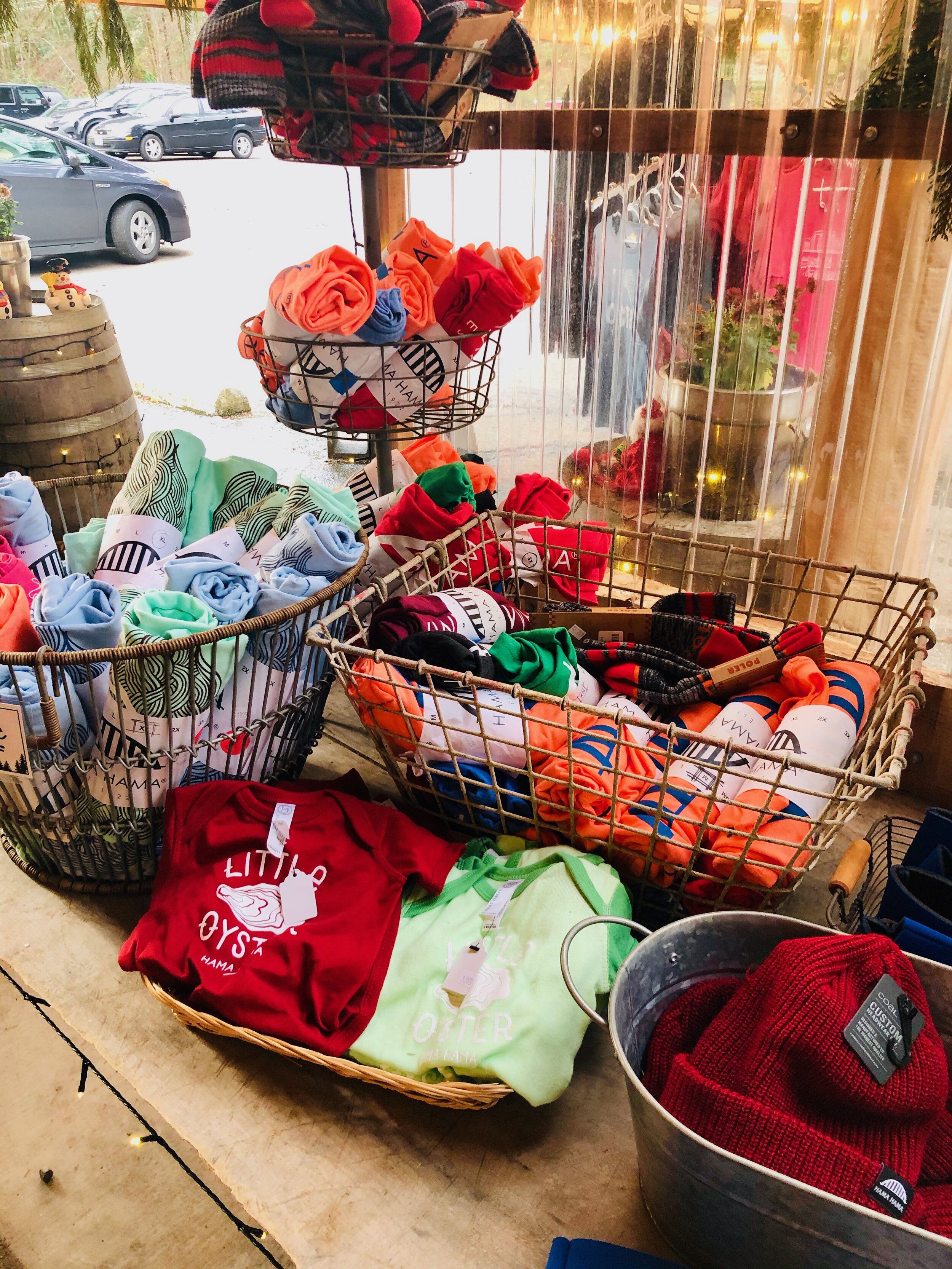
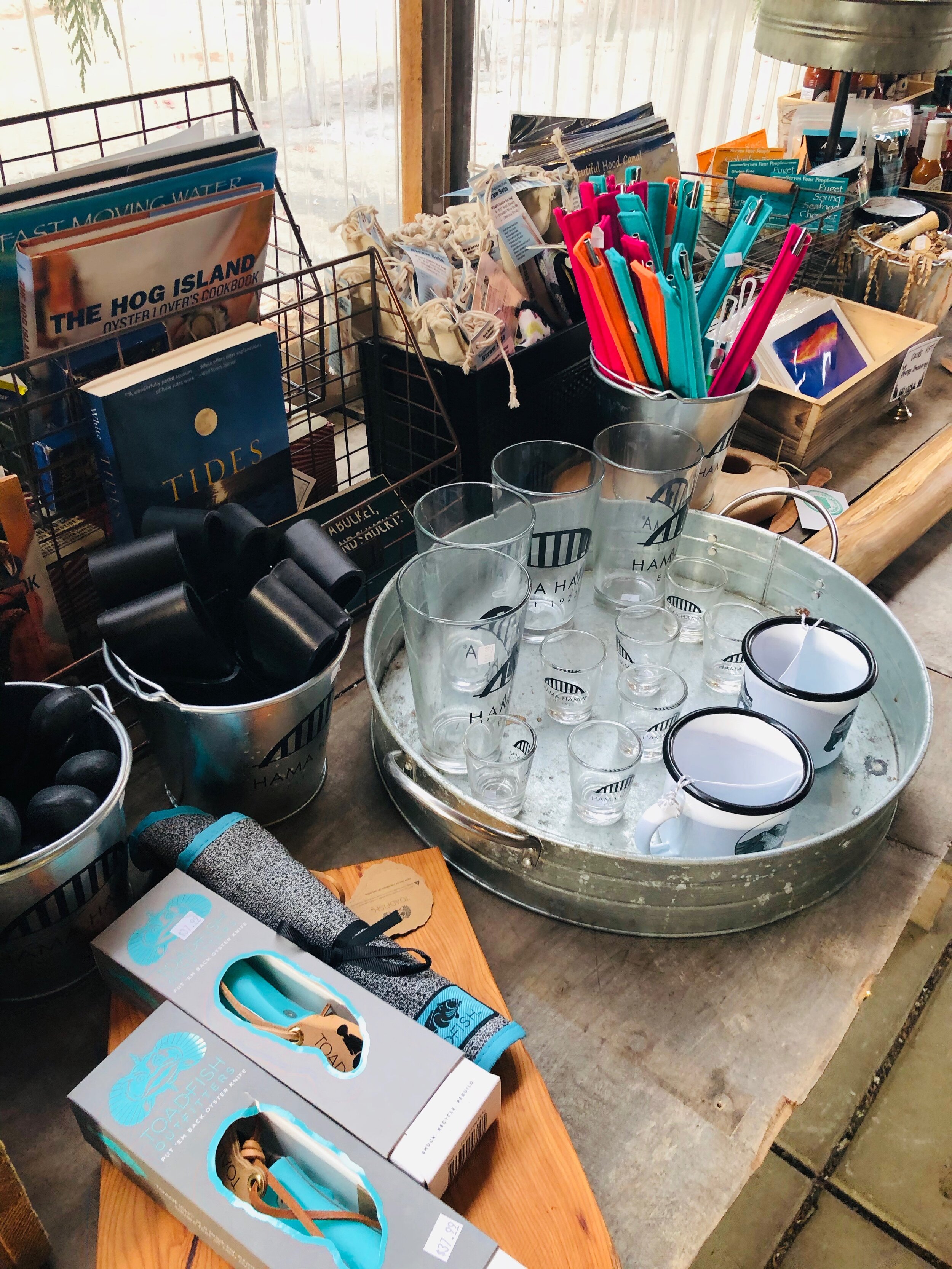
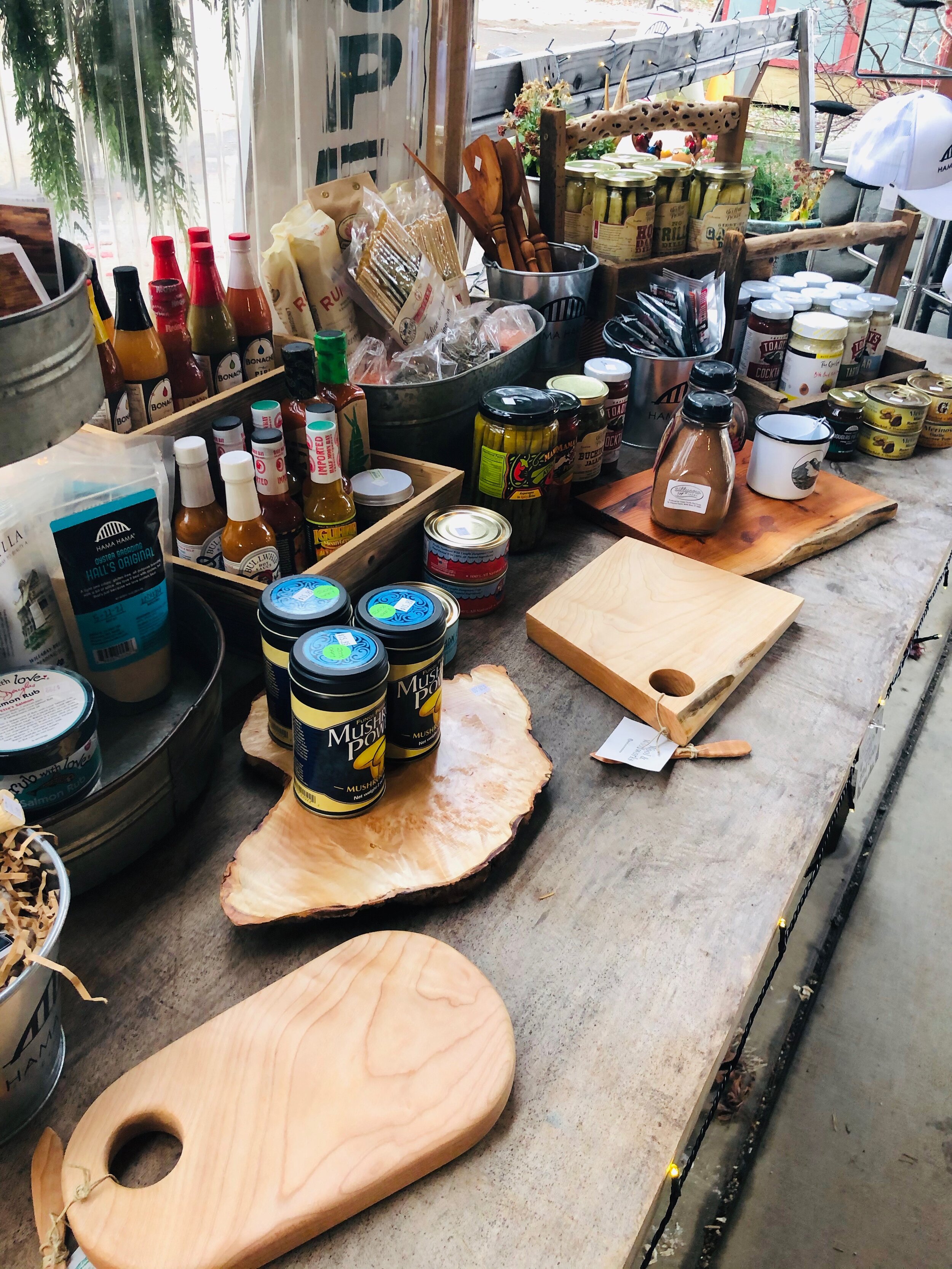
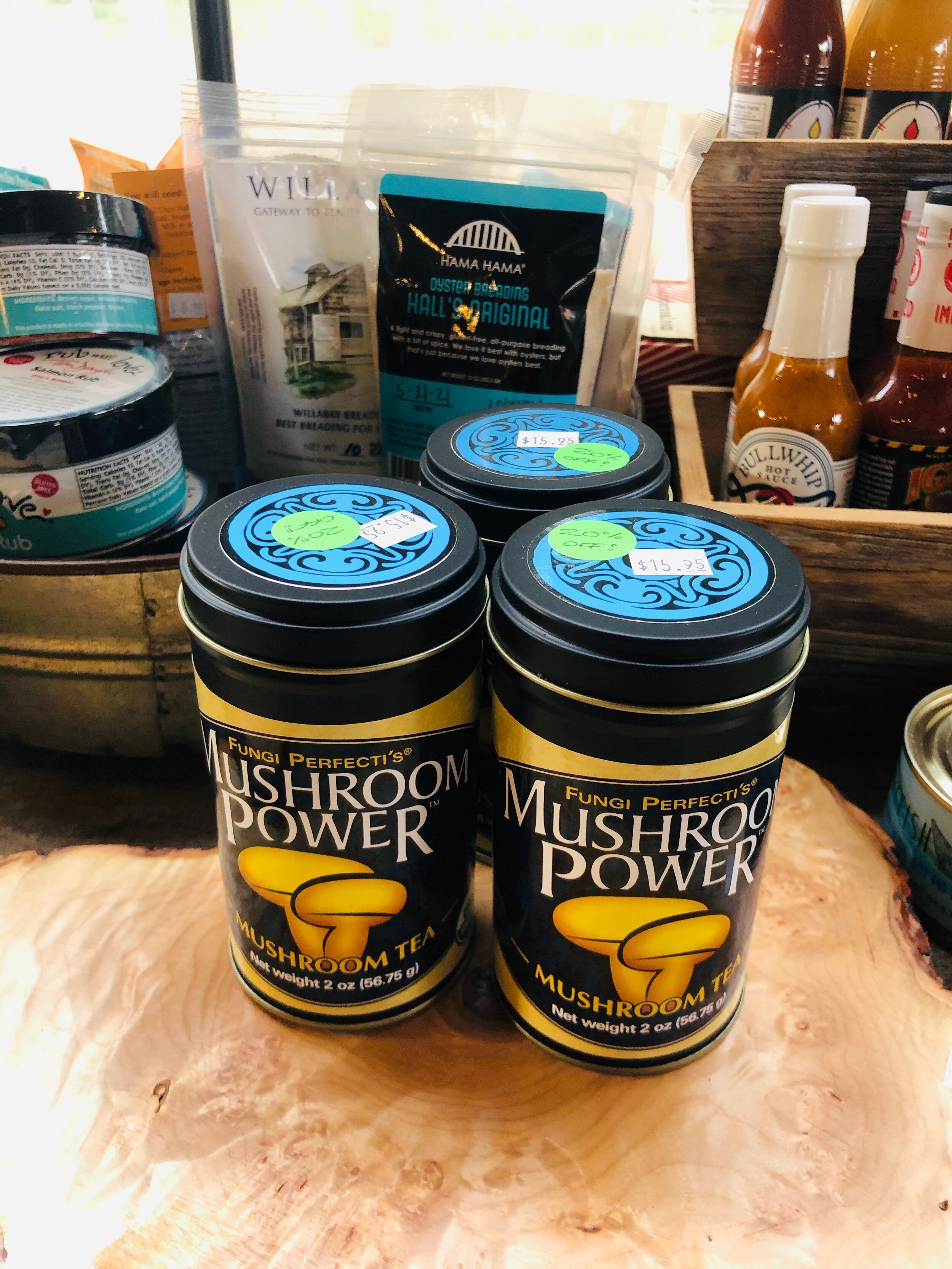
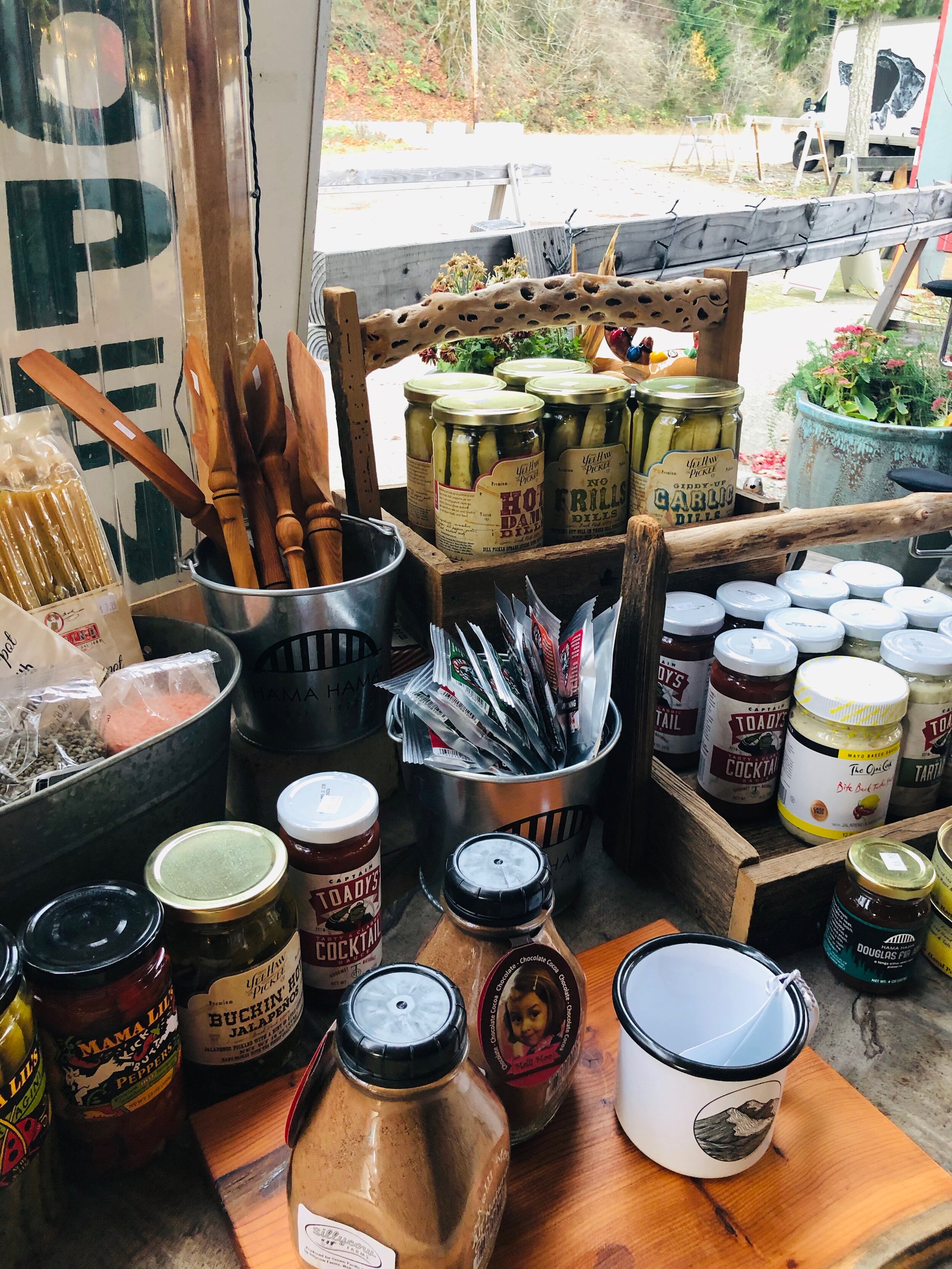
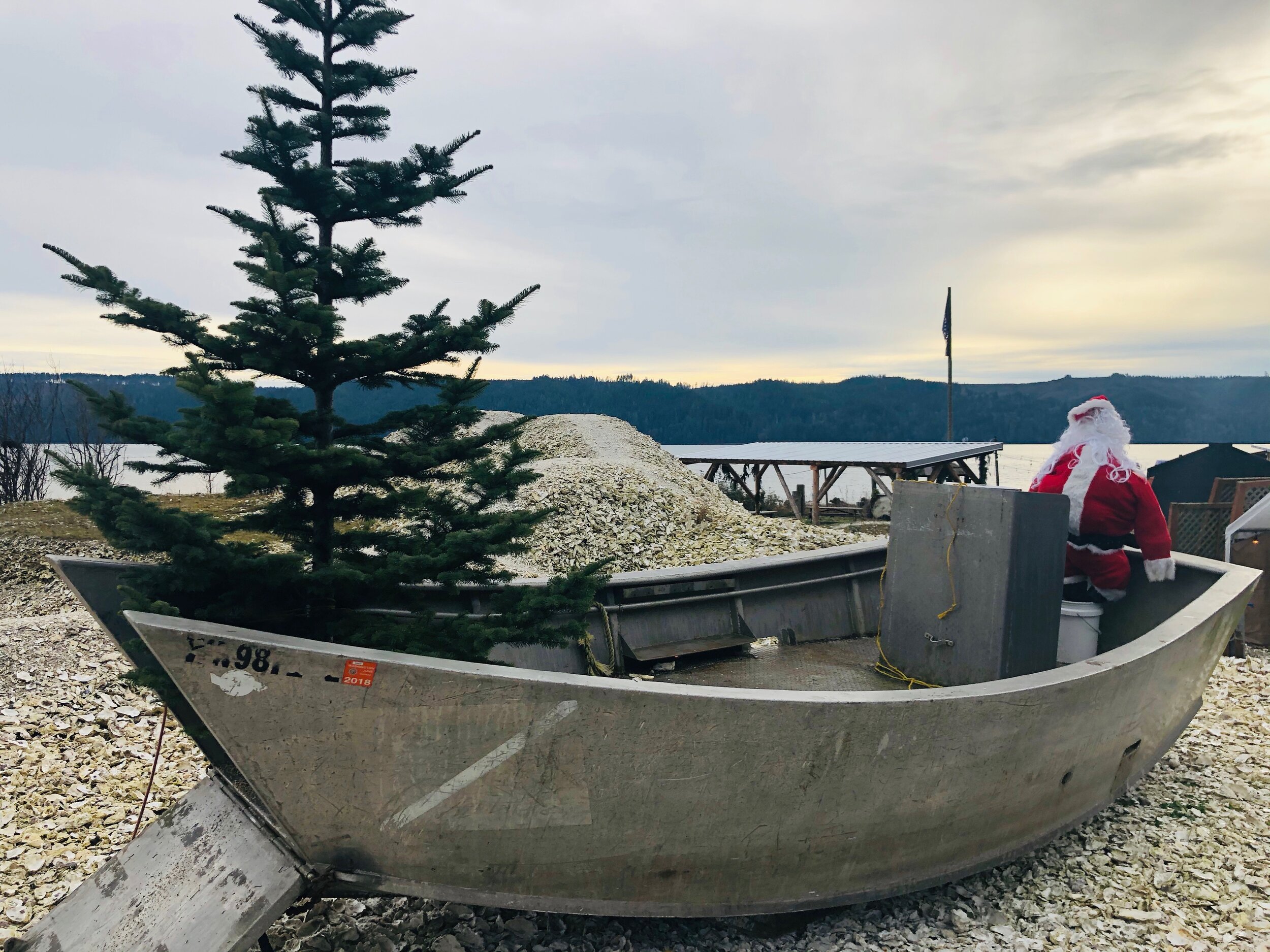
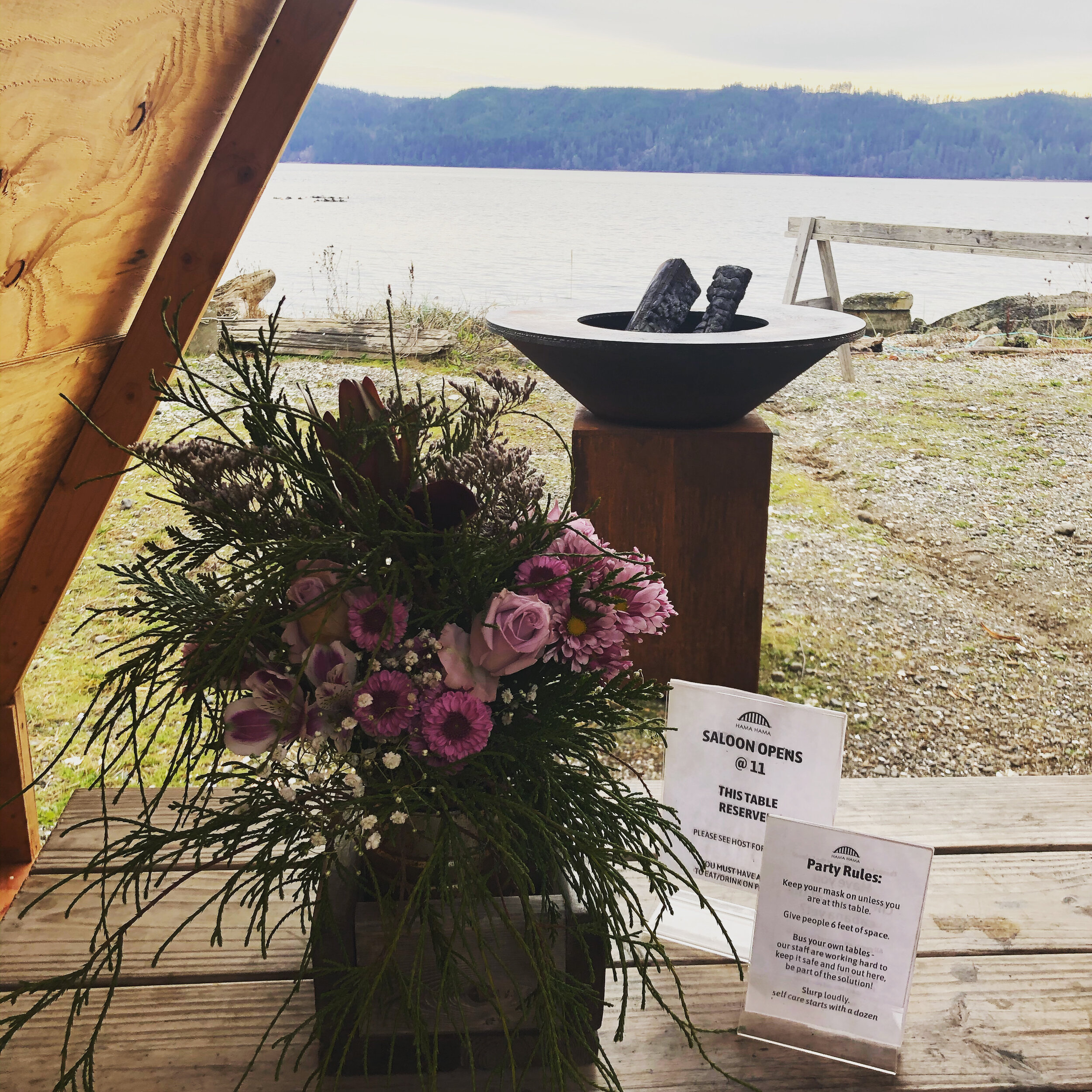
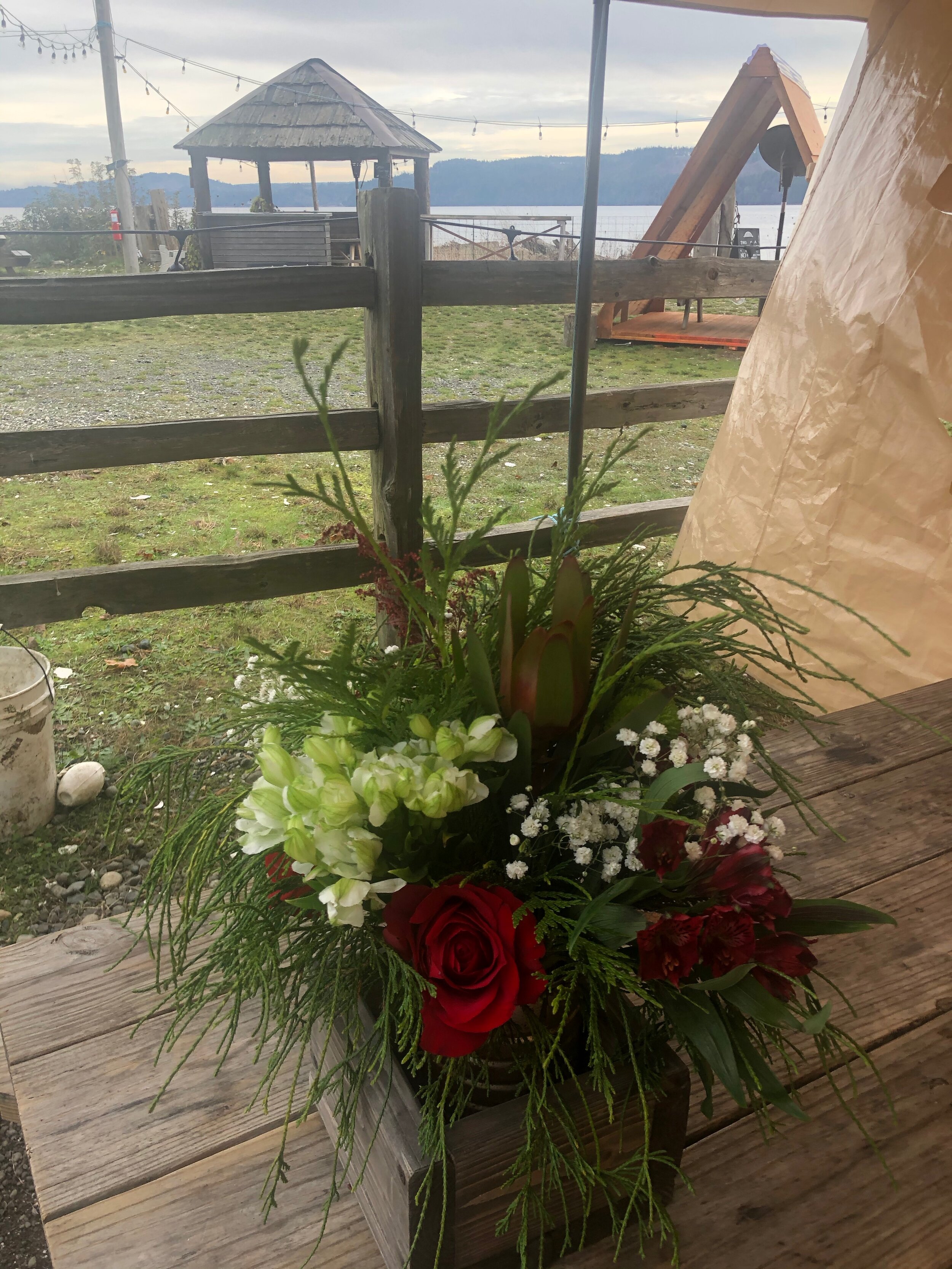
5. Hoodsport Coffee and & Shopping
We love Hoodsport. This adorable seaside town is tiny on size but big on character.
You can easily lose an hour wandering the shops here. Pull over, grab a coffee at Hoodsport Coffee, they also serve sandwiches and homemade soups, and start wandering the “boardwalk.”
Visit the Sunshine Creations Gallery where local artists display their unique creations in a beautiful setting.
Head over to the Hardware Distillery. The moment you walk through the door to soak in the rich aromas — you know you have come to “the place.“ The holiday decorations are up and the shop is COVID ready for customers. In the shops there are gnomes and tree shaped bottles. At the Distillery, cocktail kits are available for your one-stop shopping.
Pay a visit to the Stottle Winery Tasting Room, they are currently open Fri – Sun 11 AM – 5 PM. Finish up with a wander around Octopus Garden. This cute little shop run by husband and wife team, Tim and Lucy, sells customized jewelry and watercolor paintings and other decorative items. I love their marine inspired hand made silver earrings and pendants. One of a kind and reasonably priced.
We love the Hardware Distillery Cocktail kits — what a great gift! Between $45- $65, these kits are all you need too satisfy the spirit lovers on your list!
Just after Hoodsport is one of our favorite waterfront lodgings on the north side of Hood Canal. Glen Ayr Resort is located between Potlatch and Hoodsport and features a marina and fantastic views of Hood Canal from decks, cottages, and guest rooms. Enjoy diving, boating, fishing, and shellfish gathering right in the front yard! Facilities include a swim spa hot tub, a game room with a pool table, and a recreation lodge. Rates are reasonable the the resort facility is very clean.
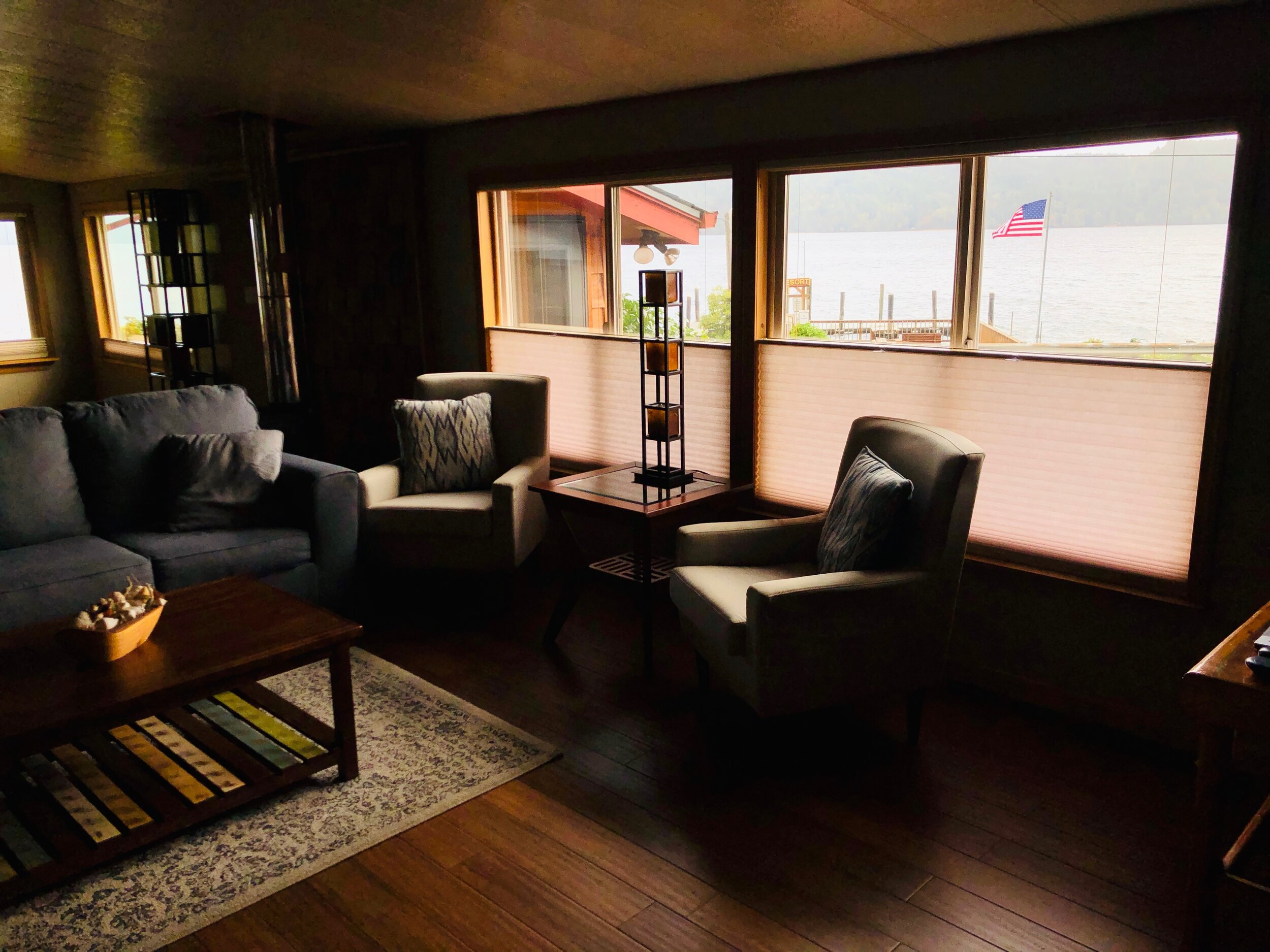
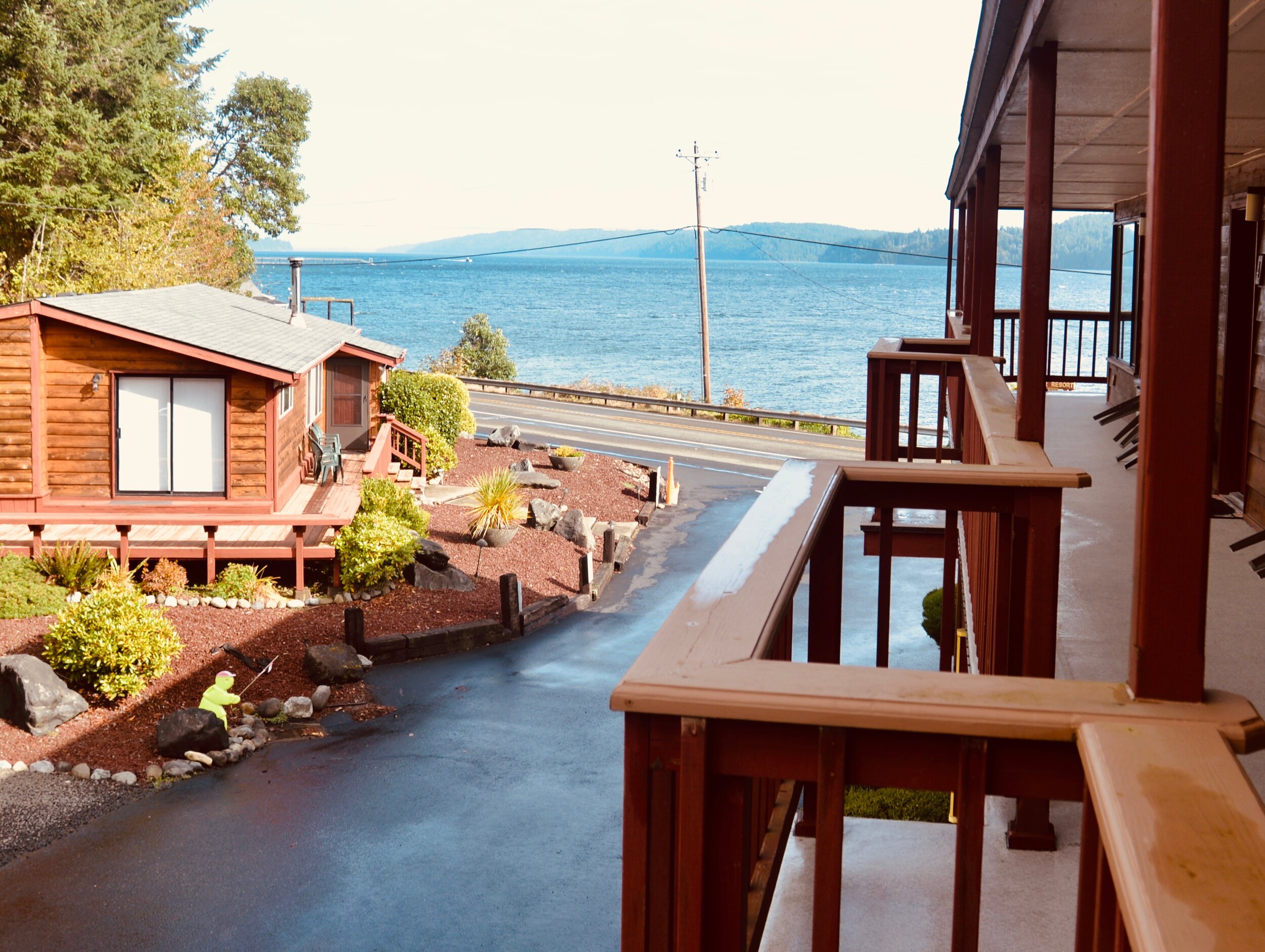




6. High Steel Bridge for spectacular views
If you have time, take a detour to explore the historic High Steel Bridge that spans the gorge and sits a staggering 300’ above the mighty South Fork of the Skokomish River.
The vertigo-inducing High Steel Bridge has an uncontested view of the last cascade on the itinerary, Vincent Creek Falls, and is easily accessed from Hwy 101. It’s also a quick pit stop after an awesome wintery afternoon of mountain biking if you happen to visit the area on a dry-ish day.
7. Spectacular Olympic Views and Quaint Shops
Originally settled in 1893 with the construction of a hotel, wharf, sawmill, and store, the area was heralded as the ultimate destination for wealthy families in the Northwest. Centered around many resorts rooted in the natural beauty of the site, the establishment of a rich artistic heritage followed in the 1920's. Union holds the title of the first non-native artist colony in Washington state. Inspired by the amazing views, artists of all kinds flock to what is truly a beautiful town.
Stop in a the Union City Market. This adorable beach shop has everything you could possibly need to make a sumptuous gourmet gift. Every item is carefully curated - from the handmade beach glass decor to the full size wall paintings. On weekends their glorious waterfront pop-up cafe is open on the marina’s waterfront. The bites are delicious and the views are divine!
Nearby Cameo Boutique & Wine Shop has a unique and inspired selection of fun gifts for your mother, sister, best friend, – and, if all else fails – check out their great selection of wine!
Waterfront Union City Market make a great Hood Canal Destination and “picture” spot with the backdrop of the Olympics.
Nearby Alderbrook Resort and Spa, one of the premier resorts in Washington State, is located on Hood Canal in Union. During the holidays, guests with reservations (closed to non-resort guests) enjoy holiday traditions with Santa and special events at the decorated resort. Make reservations today to enjoy your traditional, but non-traditional, event with Alderbrook!
8. Soak in the Spirit in Christmastown
Shelton is typically branded as a logging community. Railroad Avenue was built wide to accommodate logging trucks going down to the mill, but trees weren’t just cut to make into boards or pulp, Shelton was also known as “Christmastown, USA – the Christmas Tree Capital of America.” This year the town upped the spirit with live garland and cafe lights across the major intersections on Railroad Avenue.
Charlie Brown trees on the corners
Check out the quirky Douglas Firs on the corners. These little trees were donated by local logging companies (they were scheduled to be cut later in the spring in a natural thinning/harvest process). In the last week locals have begun decorating them. They are also free for the taking for families that can’t afford a tree this year.
Christmas has always been important to the timber town of Shelton. Located less than ten miles from Hood Canal on Hammersley Inlet, Shelton is serious about their Christmas tree roots. In 1962, to celebrate the Seattle World Fair, the town commissioned the retired Simpson Lumber shop artist, Clarence Beauchamp to build a three story Santa Claus to wave at visitors all year long.
32’ Santa Claus in Shelton | Jennifer Rutledge Photp
In 2019 the giant Santa was given a seasonal permanent location in the City of Shelton Outlook Park on Hwy #3 at the entrance to town. Thanksgiving through December, be sure to pull over in the outlook and get your family portrait. Free and COVID safe Santa photos!
Before the lights go on check out the quaint shops that line Railroad Avenue in the center of town but don’t miss the outlying treasures on Olympic Hwy (new town) or near Mason & Limerick. There is lots of opportunity to support small shop owners here. Check out the full gift list here.
9. This town is A-MAZE-ing
Last December Shelton took the Hallmark Channel head on. Shelton and Mason County celebrated their Christmastown distinction with an attempt at the Guinness World Record for “Most Lit Christmas Trees” in one location. The previous record was set by Hallmark in 2015 was 559 trees.
Trees were donated and countless community members cut, carried, stood, and strung lights on over 800 trees.
The record was recorded in July of 2020 with 797 qualified lit trees!
The town has rebuilt a Guinness Record Tribute maze this year for families to explore. With over 400 trees, this maze is available to explore for free. Located at 234 1st Street it is open each evening on a timer for families to visit through December 31.
Weekends through December 20 (Thursday through Sunday, 4PM - 8 PM) head over to the maze to enjoy marshmallow roasting (free), as well as crafting activities. Crafts are pre-packaged for safe distribution. Event has limited attendance due to COVID physical distancing.but no reservations are necessary to attend.
Curious about what else is going on in Christmastown? Check out the 797+ reasons to check it out!


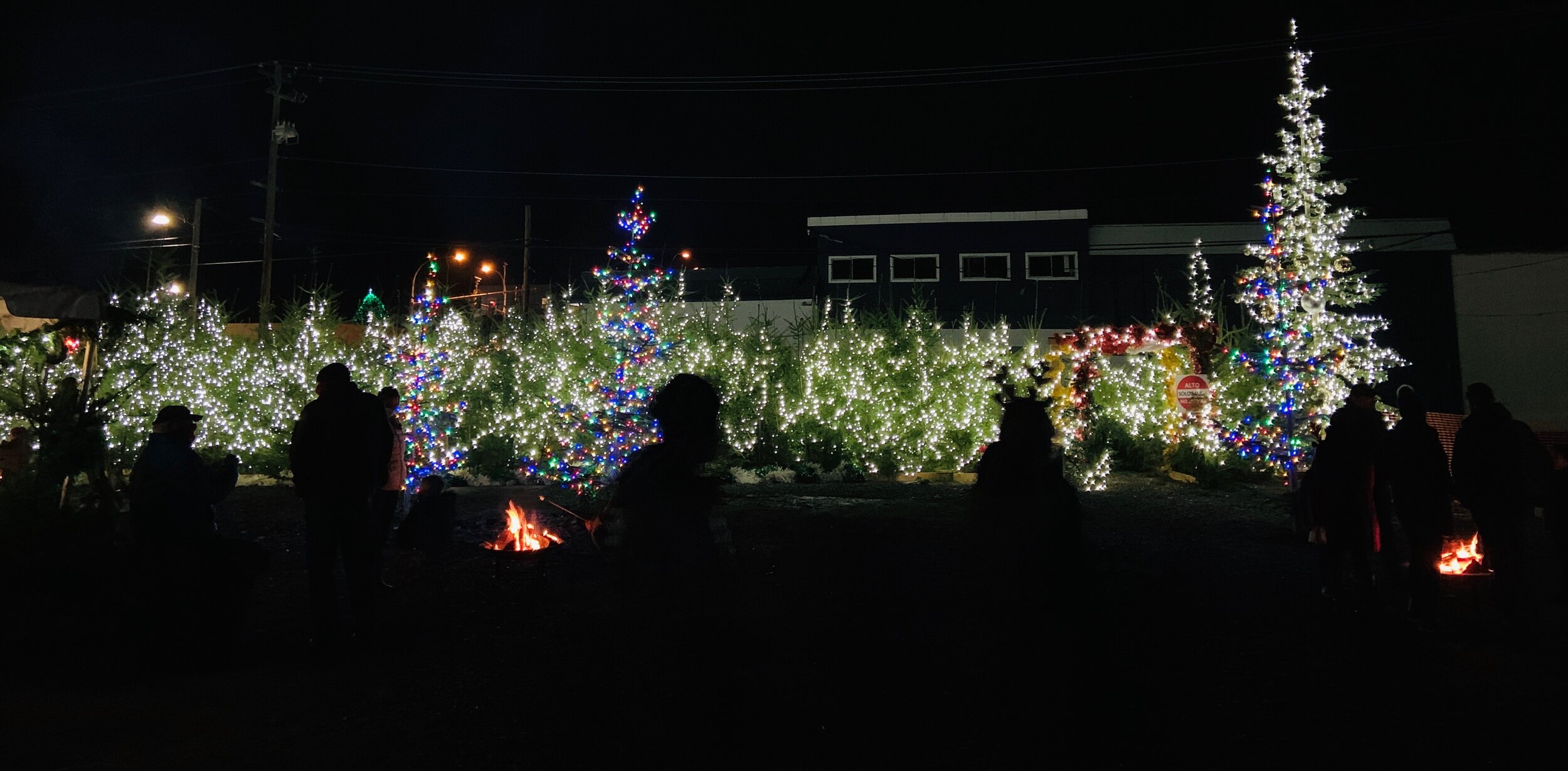

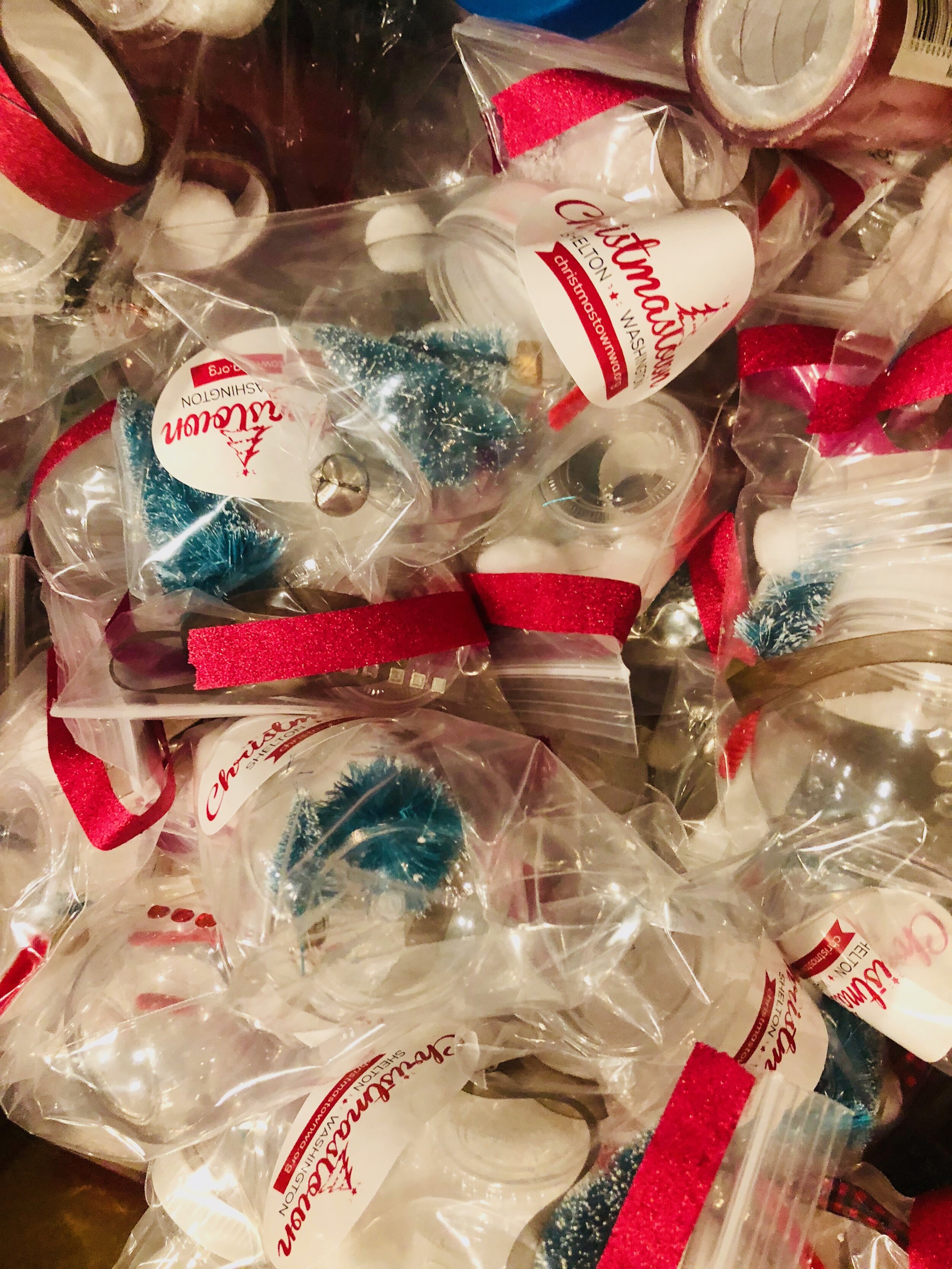


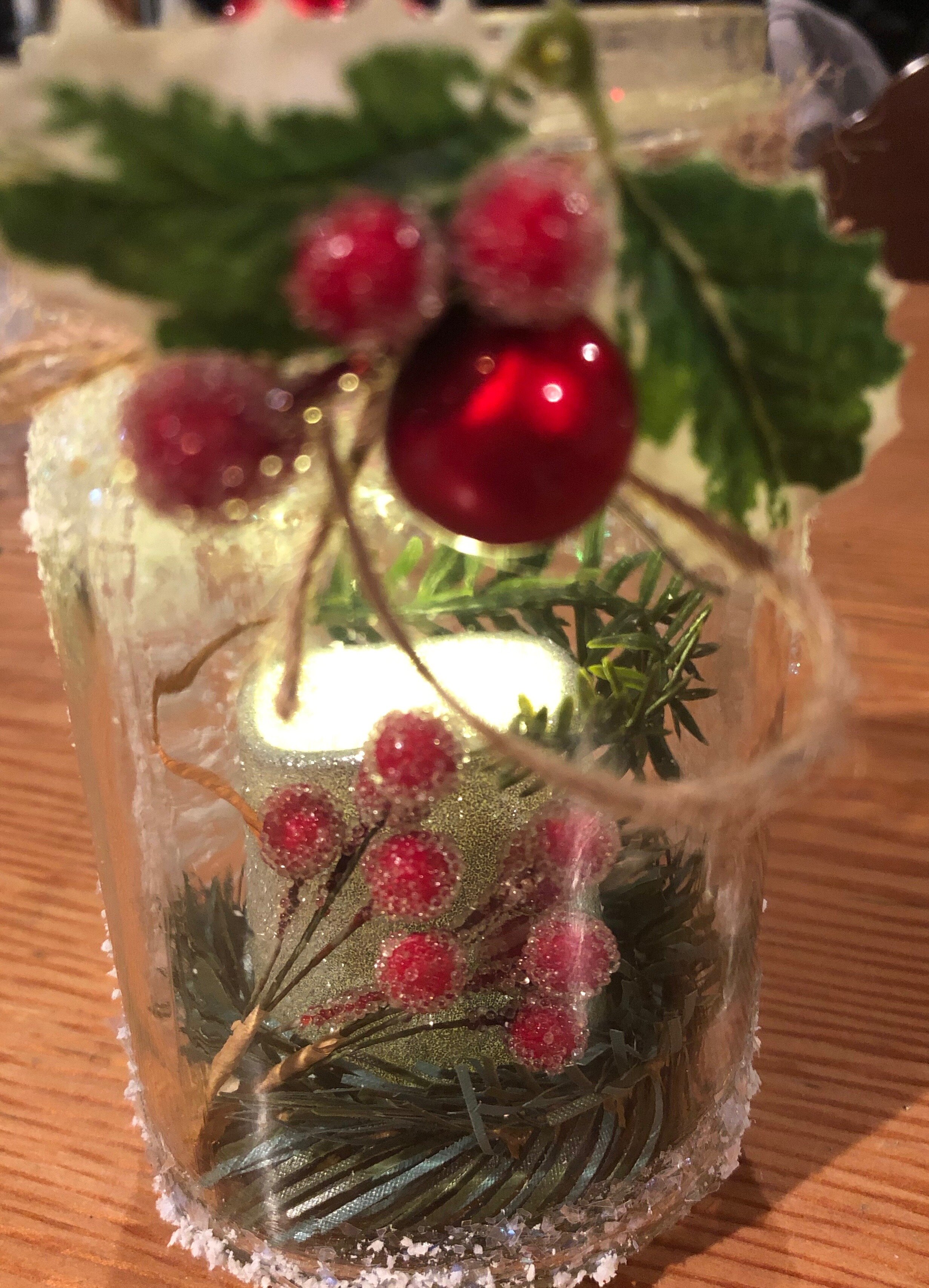
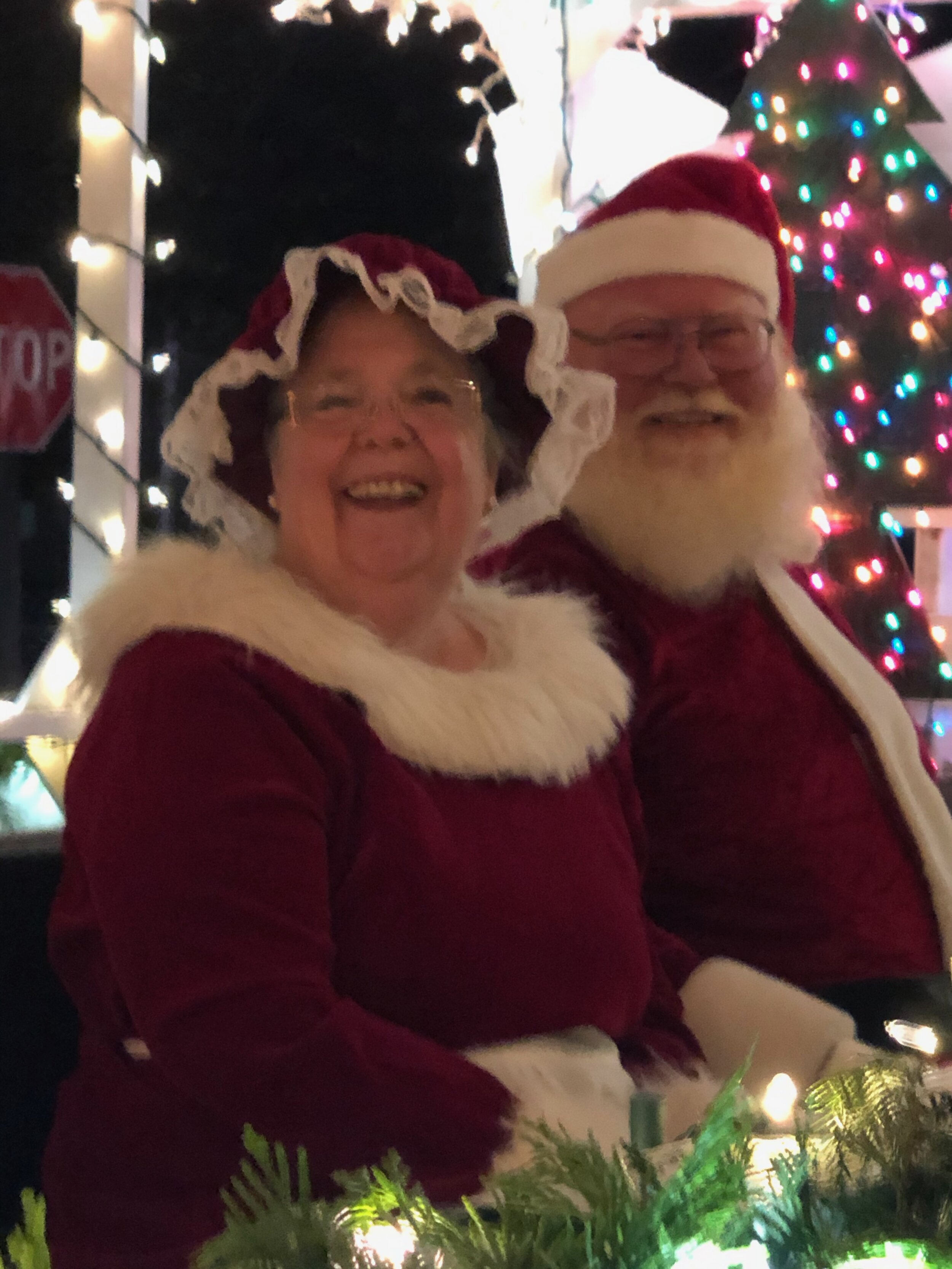
10. See the Lighted Boat Parade
The 2020 Shelton Yacht Club Lighted Boat Parade will be held December 18 & 19. Boats will leave the marina at 6:30 PM (weather permitting) and travel down Hammersley Inlet. All boaters are welcome to join in the parade regardless if you're a yacht club member or not. The boat parade can be viewed from the club parking lot, Church Point and Walker Park. Check the yacht club website for additional viewing options.
For more information on holiday happenings in Christmastown, visit christmastownwa.org
Searching for Shellfish
The traditions of clam digging and oyster harvesting run deeply through the historical veins of the Olympic Peninsula. Check out this easy itinerary from Shelton to Oakland Bay on South Puget Sound’s Hammersley Inlet.
The traditions of clam digging and oyster harvesting run deeply through the historical veins of the Olympic Peninsula. As one of the most bountiful places in the country when it comes to sea-fare,a visit compels us to unearthing our boots, shovels, and spades from the back of the garage.
With a thirst for adventure and a hankering for the freshest seafood around, we'll bee-line to our favorite digging grounds and want to take you with us as we embark on the adventure.
Caffeination Station | 9am
To get the most out of your endeavors, hitting the beach for the hour and a half before and the hour and a half after low tide is optimal. While it fluctuates over time, and you should always check the tide chart before heading out. If its morning, stop by Urraco Coffee Co. for an in-house roasted bean and a fresh baked goodie. Lounge on the dog friendly garden patio and be sure to take a bag of one of their deliciously gourmet beans with you.
Hitting the Beach
A short ten minute drive from Urraco takes you to the Oyster Reserves of Oakland Bay. Digging for both clams and oysters are permitted year-round. Most outdoor supply stores and even gas stations in the area will sell one, two, three day, or annual shellfish licenses for reasonable prices. Don't get caught without one! Don your rubber boots and your gloves, grab a bucket (regulations require that each adventurer has his own), and a clam rake and get to it!
Oakland Bay’s bounty is easily harvested at higher tides and requires little need to venture into the thick mud at the lowest point on the beach. Manila clams can be found in abundance and oysters can be spotted around every corner. Be sure to know the regulations of any site you visit.
Remember: the eats are only good if the creatures are alive and remain so until you are ready to throw them down the hatch. This means you should avoid broken shells or shells that aren't tightly closed. Leave damaged specimens in the ground, and keep up with current beach closures due to red tide and other harmful toxins here.
Enjoy the Harvest
Leisurely evenings in Hood Canal are second-to-none and that’s before you have a pot of Manila clams bubbling away in a savory sauce made with Hoodsport Winery riesling in front of you. There are a myriad of ways to prepare your shellfish harvest, but the experts from Taylor Shellfish Farms have a few tried-and-true recommendations that you can find here.
As the sun slowly sets on Hood Canal, remember that we love to see it all from your point of view. Share with #explorehoodcanal #hoodcanal and #wildsideWA and keep up with us on Instagram, Facebook, Twitter, and Pinterest for more adventure around the Olympic National Park. Happy gathering!
Monday – Friday: 6am to 7pm
Saturday: 7am to 7pm
Sunday: 7am to 5pm
Oyster Reserves of Oakland Bay
Rules (species specific)
Mason County is Officially Amazing
Mason County Wins Guinness World Record for the Largest display of Christmas Trees
The largest display of illuminated Christmas trees consists of 797 trees, and was achieved by Mason County (USA) in Shelton, Washington, USA, on 7 December 2019. Mason County is historically known as the Christmas tree capital of the world. To reignite the community spirit, the county decided to attempt this record title and created a Christmas tree maze as their display.
Last December Mason County and Shelton took the Hallmark Channel head on. Historically known as the “Christmas Tree Capital of the World,” the community celebrated this distinction with an attempt at the Guinness World Record for “Most Lit Christmas Trees” in one location. The current record was set by Hallmark in 2015 when they lit 559 trees in a New York park.
Mason County’s attempt was logged December 7th during the annual Christmas parade in Shelton, WA.
The 800+ trees were arranged in a lighted maze that families could explore along with Santa visits, hot chocolate, apple cider, food, caroling, gingerbread house contests, live music, gift workshops, and vendors at the “12 Days of Christmas” in a Christmastown, USA celebration. The trees and materials were donated by Green Diamond, Sierra Pacific Industries, Simpson and Port Blakey. The support of these timber leaders was essential to the record attempt’s success. All the trees were perviously scheduled to be thinned or removed.
During the annual Christmas parade, Municipal Court judge Stephen D. Greer and Shelton Police Chief Darrin Moody acted as official witnesses as they were led through the giant tree maze where they examined each tree for height and adequate lighting as per the Guinness World Record requirements. The count took 32 minutes. 797 of 802 trees counted were deemed appropriate for the record. The public was then allowed in the lit maze. Approximately 2500 people visited the maze that evening.
Many families enjoyed visiting the maze over the following weeks and organizers were pleased to distribute the trees in the local community. Trees were donated to families in need or purchased by donation. The Christmastown event and tree sales raised $2600.74. The funds were presented to the Kristmas Town Kiwanis for local dispersement including the annual “Food for Tots” Food Drive and the "Toys for Tots” program.
Official word of the Guinness World Record accomplishment was received in July 2020. Congratulations, Mason County on receiving this title. The Guinness record can be seen at www.guinnessworldrecords.com.
The event was coordinated by Explore Hood Canal partnering with Shelton Mason Chamber of Commerce, with support of City of Shelton Tourism, Mason County PUD #3, Mason County Tourism, Shelton Downtown Merchants, Kristmas Town Kiwanis as well as our timber partners aforementioned.
Thanks goes out to community sponsors: The Shopper, Bang Imaging, Himlie Real Estate, Peninsula Credit Union, Bowers Dental Group, Olympic Heating & Cooling, LLC, Mason County Republican Women’s Club, Elite Gutters & Guards, EI. Kristyn & Son Construction Inc., Olympic Title & Escrow, Kris Rose LMP., Cooper Studios, Denny’s Auto, Bamford Septic Repair, LLC., The Electrician, A Family Company, Olympic Title & Escrow, Maple Excavating, Franks Fix It LLC, Jami Davenport, Lake Limerick Golf Club & Cafe, Vickie Meadows & Chris Veblen and dozens of volunteers ( including Mr & Mrs Claus) who dedicated time during the busy holiday season to support this event.
Xinh Dwelley and Ni McMullen donated their time each evening of the event to cook fantastic creations for attendees and volunteers. Lisa at Fun Stuff Crafts engaged attendees with amazing take home projects, providing free fun engagement for attendees. Thanks also goes to the vendors who had faith to participate in this 12 day event.
Mildred Lakes
This grueling hike to a trio of backcountry lakes in a rugged wilderness setting is not for the weak of heart. Mildred Mildred Lakes, among the largest backcountry lakes the Olympics with excellent views of Sawtooth Ridge and Mount Pershing, is a challenging trail requiring use of hands and determination.
Craig Romano is an author of more than twenty hiking guidebooks including the bestselling Day Hiking Olympic Peninsula 2nd Edition (Mountaineers Books), which includes detailed descriptions for 136 hikes throughout the Olympic Peninsula. He is a featured columnist for the Fjord and Explore Hood Canal.
t’s the hardest, nastiest, meanest trail in the Olympics! And that declaration should not be taken lightly, as I have hiked thousands of miles (and written about hundreds of hikes) throughout the Olympic Peninsula. With perhaps only the trail to Lake Constance ranking as just as nasty—you won’t find a more curse-inducing trail than this one. The first time I ever hiked to the Mildred Lakes, I swore to myself that I would never ever do this trail again. I hated it. But alas, I was back on that wretched trail again a few years afterward. And my conclusion was that it’s still the hardest, nastiest, you-have-to-be-crazy-for hiking-this trail in the Olympics! So are you interested in hiking it?
Distance: 9.0 miles roundtrip | Elevation Gain: 2900 feet | High Point: 4100 feet Difficulty Loop: difficult | Snow free: July to October
Trailhead Pass Needed: Northwest Forest Pass or Interagency Pass
GPS waypoints: Trailhead: N47 34.517, W123 15.672 | Upper Lake: N47 33.461 W123 18.021
Hit the Trail
Okay, before hitting this trail, let’s have a chat.
No cheery coating—this is what you’re in for. This trail was never officially built. The trailhead was however. It’s fancy with a picnic table, privy and a view of a stunning waterfall. But don’t let those amenities fool you into thinking the trail is anything special. The trail is only 4.5 miles to the lakes, yet it will take you nearly that many hours to reach them. Why? The actual evaluation difference between the trailhead and the lakes is a mere 1,900 feet. But the real elevation gain is more than 3200 feet with copious ups and downs.
®Craig Romano Photo
There’s one section of trail that climbs more than 1,000 feet in about a half mile. It is a nasty clamber up roots, rocks and loose gravel. But don’t curse the root—for they’ll be your handholds. There’s another trail section where you have to vertically drop about 25 feet into a tight ravine. And you’ll be using a veggie belay to climb out of it. You will skirt mud, go through mud, and probably be covered in mud upon reaching the lakes.
And if you don’t let out a scream, your knees and toes most certainly will! So why then unless you’re a sheer masochist would anyone want to hike this trail? For one thing, the Mildred Lakes are among the largest backcountry lakes the Olympics. Their setting is quite sublime in a rugged basin surrounded by serrated peaks. You will definitely earn these lakes; as many hikers just aren’t cut out for this grueling journey. That means you’ll see a fraction of the amount of people you’d see at nearby Lena Lake.
And in this age of social distancing, the Mildred Lakes’ brutal approach helps make that directive easier to comply. So if you’re ready to bust your rump, read on!
Hamma Hamma Falls | ®George Stenberg
The Mildred Lakes Trail leaves the roar of the cascading Hamma Hamma River behind and enters the 13,000-acre Mount Skokomish Wilderness. Starting out fairly easy, the path winds through an old cut that has been growing back in pretty nicely. The way then passes a large avalanche chute and enters gorgeous old growth forest. Here what once a decent path now deteriorates into an obstacle course. Around fallen logs, over fallen logs, and straight-up rocky and rooty slopes the trail steeply climbs a 3200-foot ridge. Catch your breath, wipe the sweat from your brow and enjoy a good view of nearby Mount Pershing looming above.
®Craig Romano Photo
The trail then descends from the ridge into a cool forested glen graced by rushing Huckleberry Creek. And yes, there are huckleberries here—lots of ‘em to sweeten this hike a tad come late summer. At the creek come to a questionable log crossing. You can teeter on it to cross the creek. But it’s probably far safer to wade across. Don’t bother drying your feet, because another creek crossing awaits shortly afterward.
The trail now get tougher and a tad bit tricky. It ascends a steep ridge and comes to a tight ravine. Using roots as handholds, drop 25 steep feet into the dank draw before resuming a taxing climb. After clambering over rock, root, and ledge—and gaining 1000 feet in elevation in a little more than a half mile—the insanity ends on a 4100-foot ridge. Now wander along open ledges, enjoying excellent views of Mount Cruiser and the Sawtooth Range. You might be a little dismayed however as there are no lakes in sight. Your punishment isn’t over yet.
®Craig Romano Photo
The trail continues. Drop 250 feet and trudge through marshy mosquito breeding grounds. Make haste through it and finally reach the first of the Mildred Lakes. It’s set in deep old timber with a backdrop of rugged summits. The scene is serene. Scramble over more roots and rocks to the far side of the lake for good fishing spots, resting spots and campsites. Watch resident osprey dive bomb the placid lake.
The other lakes are prettier, so carry on by crossing lower Mildred’s inlet stream and following a rough path through heather meadows for about 0.3 mile to a junction. Here a rudimentary path leads right to middle Mildred Lake. Admire its rocky islands. Upper Mildred, one of the largest backcountry lakes in the Olympics can be reached by continuing on the more defined path for just a couple hundred yards forward. Located in a bowl between Mount Lincoln and Mount Cruiser, the setting is as rugged as the terrain you just hiked across. Quite beautiful too, and hopefully justification for all of the bruises, scratches, and aches and pains you’ll bring back with you to the trailhead.
®Craig Romano Photo
Mildred Lakes Notes
Wilderness rules apply
Land Agency Contact: Olympic National Forest, Hood Canal Ranger District, Quilcene, (360) 765-2200; http://www.fs.usda.gov/olympic
Recommended Map: Green Trails Olympic Mountains East 168S
Recommended Guidebooks: Day Hiking Olympic Peninsula 2nd edition (Romano, Mountaineers Books)
Trailhead directions: From Hoodsport travel north on US 101 north for 13.7 miles turning left at milepost 318 onto FR 25 (Hamma Hamma River Road). Continue for 13.3 miles (the last five miles are gravel and can be rough) to the trailhead.
Trailhead facilities: privy, picnic area
Tips for safe and healthy hiking during the Covid-19 Pandemic
It’s imperative that we do all we can to prohibit a second devastating outbreak of this disease. We can do that by adhering to the following while we enjoy our trails:
Avoid crowded hiking destinations. If you arrive and the parking lot is already full, head to another location
Avoid hiking in large groups outside of your family
Practice Social Distancing while on the trail, giving other hikers lots of room to pass and keeping your distance from them at lakes, summits, etc.
Wear a mask when encountering others on the trail. A buff or bandanna works well.
Pack hand sanitizer
Pack it in pack it out
Don’t be a surface pooper. Learn how to properly poop in the woods by always using privies first if available-or by heading at least 200 feet away from all trails, campsites and water sources and digging a cat hole for your business. Bury your waste and toilet paper
Pack out all pet waste.
Weather or Not | Predicting your day on Hood Canal
The fjord we call Hood Canal, flanked by the lofty Olympic Mountains to the west, creates a unique geography that is not only picturesque, but also results in weather systems that are very tricky to predict.
While talking about the weather is traditionally deemed the safest subject in polite company, predicting it definitely lands you in a volatile position, as weather forecasters who try to explain the many unique weather patterns we get along the Hood Canal can attest. From beautiful dry summers, to drizzly falls, stolen snow days and unexpected hurricane force winds– the weather of the Hood Canal never fails to surprise. Although it’s fun, it’s not fair to blame our mercurial weather on forecasters based in Seattle.
The fjord we call Hood Canal, flanked by the lofty Olympic Mountains to the west, creates a unique geography that is not only picturesque, but also results in weather systems that are very tricky to predict.
Although likewise coastal, Hood Canal experiences far more instances of snow than Tacoma or Seattle. Unlike other Washington coastal communities, the saltwater corridor of the tidal Hood Canal is too narrow to sufficiently warm the air.
Another factor influencing snow fall is the location of the Olympic Mountains. Traditionally, weather is known to travel from the west off the Pacific Ocean to the East. Following this we would expect that because of its location lying in the eastern lee of the Olympic Mountains the Hood Canal would be protected from these weather systems, but that is not how the weather always behaves. Low pressure systems off the Pacific often results in high pressure weather in Washington’s Northeast, which reverses this lee and draws weather in an East to West direction. Also cold air from the mountain tops often falls down into the fjord rapidly dropping the air temperature.
This cooler, snow ready weather makes winter sports an unexpected pleasure of the Hood Canal. Many locals take advantage of this 4x4’ing in the mountains on the weekend for snowy tailgate parties.
Sometimes the community joins in on the festivities. Last year, Quilcene hosted a community snowball fight after a particularly white week. However, recent snow falls have been fairly tame in comparison to the four feet of flakes Hoodsport received in 1916 or twenty-seven inches in 1943!
Since the Hood Canal is fed by the estuaries of the Skokomish, Union and Hamma Hamma Rivers along with a number of smaller tributaries, it has a layer of freshwater atop the salt. In very cold weather, this brackish water has been known to freeze over. In the winter of 1924-25 the Hood Canal froze from Lilliwaup to Belfair. In typical pioneering spirit, there are many historical accounts of exploiting this new surface. There were reports of the Twana elder Henry Allen driving his wagon across the canal from Hoodsport.
Frank Pixley who founded the artist colony of Olympus Manor at Union reportedly walked across to Tahuya. Fritz Dalby (of the Dalby Waterwheel fame in Union) went ice-skating in front of the current site of the Robin Hood Restaurant. The Hood Canal is reported to have frozen over in 1950, 2009 and most recently in 2015.
A similar low-pressure vacuum that makes Hood Canal prone to snowstorms also can result in heavy winds. In the summer-time this weather calms down to gentle breezes, which makes the straight stretch of Hood Canal a favorite with sailing clubs.
However, during the winter these winds can get fierce. One windstorm that hit in February of 1979 was particularly infamous. A low pressure moved in the Juan de Fuca Strait drawing all the air of Western Washington into tremendous winds. Unfortunately, Hood Canal with its deep fjord shape and its South-North orientation lined up perfectly with the direction of this wind and created a powerful wind tunnel.
The floating Hood Canal Bridge connecting the Kitsap and Olympic Peninsula located at the mouth of the Hood Canal could not stand the winds that reached 80 m.p.h with estimated gusts of 120 m.p.h. Although the bridge crew opened the bridge to help relieve the stress of the buffeting wind, the bridge’s pontoon storm hatches blew open and the bridge took on water. No one was hurt, but on February 13th 1979 the world’s longest saltwater floating bridge sank. What was usually a 1.5 mile bridge crossing became a 115 mile detour around the Hood Canal inconveniencing thousands of commuters. WSDOT scrambled to re-establish ferry routes between Lofall and South Point across the canal just south of the bridge and extra ferries were added to the route between Edmonds and Port Townsend. The bridge was repaired and reopened on October 24th 1982 with heavier anchors and more stringent bridge closure procedures. Many called for the bridge to be replaced with a spanned bridge that wouldn’t be at the mercy of the 16.5 foot tides, the corrosive quality of salt water, and the strong currents, but the fjords 300 + depth and sandy bottom is too difficult and cost prohibitive to span. Today, approximately 20,000 vehicles cross the bridge daily and in the last forty years the bridge has not suffered such a failure again.
While the wind, snow, rain, and sudden brilliant sunny days make it hard to pack for a visit on the Hood Canal, don’t let the weather deter you. Pick a book and snuggle beside by the fire and enjoy the hygge you keep hearing about while the misty damp engulfs the trees outside. Or pull on your gumboots and favorite slicker and meet the storm full on – storm-watching and puddle jumping can be pretty fun too! But if it snows, dust off your favorite hot toddy recipe and challenge your friends to an igloo building contest. Embrace the unexpected, it’s the Northwest way.
Contributor: Stella Wenstob, MA
Lena Lakes Hiking Destinations
Gracing the Hamma Hamma Valley are two lakes sharing the name, “Lena.” But aside from the name, they are strikingly different from each other. Renown guidebook writer, Craig Romano, takes us on a trip to visit both these lakes.
Craig Romano | Craigromano.com
Gracing the Hamma Hamma Valley are two lakes sharing the name Lena. But aside from the name, they are strikingly different from each other.
The hike to Lower Lena is an easy kid and dog friendly jaunt through old growth forest. The hike to Upper Lena is a grueling and demanding grunt to a stunning high basin within Olympic National Park. Seasoned backpackers take to the upper lake and often set out afterward to scramble surrounding craggy peaks or head out on a rugged high country route. Lower Lena entertains first time hikers and newbie backpackers often testing their gear and skills for the first time. Expect plenty of company at the lower lake and a good chance for solitude at the Upper Lena.
Hit the Trail
Both lakes use the same approach. On a very well-trodden path head off in second-growth forest. The way immediately climbs, but the grade is gentle. Lena Creek can be heard crashing in the distance.
Lena Lake
Continue up the trail and eventually enter groves of beautiful old growth forest. The trail nears Lena Creek and then crosses it on a solid bridge. You might be dismayed however to be standing on a bridge spanning a dry rocky draw. What happened to the creek? It often makes a subterranean passage beneath all of those mossy rocks.
Now continue hiking working your way around and below a ledge. The trail then continues to climb coming to a junction at 3.0 miles. If you’re lower lake bound, bear right and within no time come to an inviting ledge granting a wonderful view of Lena Lake 100 feet below.
To reach the shoreline continue and descend passing busy campsites. You’ll eventually come to a junction with a trail leading back to the trail heading for the upper lake. Head right and reach the shoreline. The trail crosses Lena Creek and continues towards The Brothers—but that’s more of interest to climbers. You’ll figure out in no time that Lena Lake is one of the most popular hikes in the Olympics. Be sure to treat this heavily visited place with care and to practice Leave No Trace ethics.
Upper Lena Lake
If you’re more interested in a wilder setting, skip the trip to Lower Lena and from that first junction, head left. Immediately notice how much lighter the tread is now. Bear left at the next junction and begin following Lena Creek through spectacular primeval forest. At just over 4.0 miles the trail enters Olympic National Park. Dogs are prohibited from this point on—and if you plan to camp at Upper Lena you must have a backcountry permit (issued at Hoodsport Visitor Center and other Olympic National Park ranger stations). Until this point the climbing has been fairly moderate, but that is all about to radically change.
The trail continues alongside Lena Creek heading up an increasingly tighter valley. After crossing a tributary creek on a log bridge the trail gets downright nasty! Prepare yourself for an insanely steep climb up a rocky, rooty, and at times brushy course. It’s arduous and physically taxing, and when soaked by rainfall it can be treacherous. A good set of trekking poles will come in handy. The climbing eases after you carefully negotiate a ledge and clamber up a steep rocky bed of big rocks,
Once again come to and cross Lena Creek, which may be following a subterranean passage here as well.
Continue through open attractive old-growth forest groves. Make one more steep climb before cresting a ridge cradling Upper Lena Lake. Before bolting for the lake, turn around and look back at Mount Rainier in the distance. Now charge for the lake. Enjoy a breathtakingly beautiful backdrop view of 5960-foot Mount Bretherton rising above and reflecting in the lake. Camps (permits required) are along the lake’s eastern shore, and by a short path, on the lake’s western shore.
If you’re up for the day, stay awhile and soak up the beauty. In autumn the surrounding hills colorfully reflect in the lake’s placid waters. Look for critters big and small frolicking in those hills looking for berries. Feel free to help yourself to a handful as well. If you have any energy left consider following a half mile side trail to beautiful Milk Lake set beneath a small glacier on Mount Bretherton. Then rest up and prepare your knees for the brutal and jarring descent back to your vehicle. The beauty and solitude are definitely worth the grind.
Craig Romano
Award winning author and outdoors writer who has authored and co-authored of more than 20 books including Day Hiking Olympic Peninsula 2nd Edition (Mountaineers Books), which features 136 hikes on the Olympic Peninsula. craigromano.com
Lena Lakes Details
Distance:
Lower Lake: 6.0 miles roundtrip; Upper Lake: 14.0 miles roundtrip
Elevation Gain: Lower Lake: 1225 feet; Upper Lake: 4100 feet
High Point: Lower Lake: 1900 feet; Upper Lake: 4600 feet
Difficulty: Lower Lake: moderate; Upper Lake: strenuous
Snow free: Lower Lake: March—Dec; Upper Lake: July—November
Trailhead Pass Needed: Northwest Forest Pass or Interagency
GPS waypoints:
Trailhead: N47 35.984 W123 09.055
Lower Lake: N47 36.994 W123 09.789
Upper Lake: N47 38.068 W123 12.329
Dogs are ok at Lower Lena but prohibited at Upper Lena Lake.
Camping (no fires) at Upper Lake requires National Park Wilderness Camping Permit (contact Olympic National Park, Wilderness Information Center (360) 565-3100)
Land Agency Contact: Olympic National Forest, Hood Canal Ranger District, Quilcene, fs.usda.gov/olympic and Olympic National Park, nps.gov/olym
Recommended Map: Green Trails Olympic Mountains East 168S
Recommended Guidebooks: Day Hiking Olympic Peninsula 2nd edition and Backpacking Washington (Romano, Mountaineers Books)
Trailhead directions: From Hoodsport travel north on US 101 north for 13.7 miles turning left at milepost 318 onto FR 25 (Hamma Hamma River Road). Continue for 7.5 paved miles to the trailhead.
Trailhead facilities: privy
Fall Recreation on the Fjord and Surrounding Area
Ron Adams | Verle's LLC
The long, warm and sunny days of summer on or near Hood Canal have nearly come to a close once again. The camping, biking, hiking and water sports we enjoyed will soon be recent yet unforgettable memories. Fall is about to surround us with a beautiful mosaic of rich yellows, greens, and reds as the leaves of hardwood trees give way to their wonderful ballet of fall colors.
However, the changing of the seasons does not bring an end to outdoor activities around Hood Canal. To many it is the beginning of a new and exciting chapter of outdoor opportunity and adventure.
Salmon and Steelhead can be found in most of the pristine rivers near Hood Canal where a true trophy and adventure of a life time await those who are willing to test their skills and moxy to harvest some of this plentiful bounty. Steelhead are different than their cousins the salmon in the fact they can return to their home rivers several times and spawn many times before they reach the end of their life cycles whereas pacific salmon only spawn once. Steelhead are a species of rainbow trout that is spawned in a river and then goes out to saltwater to mature. Their life in the nutrient rich waters of the Pacific Ocean allow them to grow rapidly and reach over 30 lbs in weight. Many lakes in the surrounding area are open year round for fishing and can provide healthy delicious protein.
Mushroom gathering it also very popular and several delicious varieties await those who know where to find them.
If any of this entices you, you are not alone. Thousands of outdoor enthusiasts will make the trek to this area to do everything I've mentioned and more.
Find out More
Established in 1948 Verles is celebrating 70 years of having a finger on the pulse of the Hood Canal and most things outdoors. With a skilled staff and a great selection of gear, Verles is there to help you get away and be successful in your outdoor adventure any time of the year. Verles is located at 741 West Golden Pheasant Road in Shelton.
Celebrating Our Winter Olympics
Yes, it's a shameless play on words –While the athletes compete in the XXIII Winter Olympics in PyeongChang – we can celebrate with our own neighborhood Olympics. Now is the time to search for the "Traveler," and marvel at how Mount Washington looks just like the coin profile!
Towering over the Juan de Fuca Strait, the Olympic Mountains are an impressive sight. Although the tallest peak, Mount Olympus, reaches only 7,965 feet, the steep manner they rise from the ocean gives the mountains the illusion of great height. While the athletes compete in the XXIII Annual Winter Olympics in PyeongChang, we can celebrate with our own neighborhood Olympics.
UNION, WA
The Traveler is visible in spring on the face of Mount Washington.
In 1788, the explorer Captain John Meares named the tallest peak Mount Olympus in honor of the Greek explorer Juan de Fuca who had first passed by the mountain and named it Santa Rosalia in 1774. Since then the range has become associated with the ancient home of the Greek gods in name.
The Olympic view from the Harmony Hill cottage overlooking the Canal in Union, WA
In spite of their jutting appearance, the Olympic Mount Range are not volcanic. This is surprising given the proliferation of volcanic ranges in the Pacific Northwest, for example Mount Baker and Mount Rainer. As evidenced by the marine fossils found in the summits of the range, the Olympic Range once was part of the ocean floor. Approximately 120 million years ago, the Pacific Tectonic Plate crashed into the North American Plate and created the Olympic Range.
The actions of glaciers melting and freezing again created the “glacial horn” appearance of some of the more craggy mountains, a process that is also seen in heights such as Mount Everest and the Matterhorn.
Remnants of ancient Ice Age glaciers (from 26,000 to 13,300 years ago) are thought to make up portions of the larger existing glaciers in the park — specifically, those glaciers found on Mount Olympus and Mount Anderson. The smaller glaciers in the park were formed during the last “Little Ice Age” of only three to five thousand years ago.
The melting of these glaciers is a constant source of water for local watersheds. As well, the height and proximity to the ocean of Mount Olympus favors this mountain with an incredibly moist climate, making the Hoh Rainforest the wettest location in the United States. Contrastingly, parts of the rest of this horseshoe shaped range are in a rain shadow, creating a fairly dry climate.
Most of this range is protected within the Olympic National Park. This massive park system offers plenty of opportunities for excursions and many of these services are open in the winter. Why not plan a day trip to the mountains to sample the snow? Take the kids or friends and plan a mountain adventure. Build an igloo, go snowshoeing, or just have a snow ball battle. Although the lower reaches may be drowning in rain, if you head to the hills you might just find a drier, fluffier version. Pack a high protein lunch (such as cheeses, sliced meat and fruit) to keep you going and a thermos of your favourite hot drink to warm you up.
For the kiddies bring hot chocolate and for the more mature members try our hot toddy recipe. If you have a propane stove, or some sort of portable stove system, why not have a high altitude hotdog roast?
If you are searching for more organized activities, Hurricane Ridge offers ranger-guided snowshoe walks (snowshoes provided!) and economical ski day passes, as well sledding and tubing is free for children . The more adventurous seasoned camper may want to try their hand at “winter camping.”
Check the ONP website for road conditions before you answer the mountain’s call, as winter conditions can close areas. Be mindful that weather can be unpredictable and it is always better to be safe than sorry, as the Olympic National Park website warns - Always carry the 10 Essentials: map, compass, flashlight, knife, matches, nylon cord, extra food and water, and raingear with warm clothes. Let someone know where and when you are taking your hike. Make emergency plans for them to follow if you do not return. Be safe and have fun!
Easy and Delicious Wintertime Campfire Recipes
There’s hardly anything better than friends gathered around a campfire. Throw some tasty, warm drinks in the mix and a meal prepared over an open flame, and you have the formula for a winning winter dinner.
There’s hardly anything better than friends gathered around a campfire. Throw some tasty, warm drinks in the mix and a meal prepared over an open flame, and we contest that there’s a formula for winning winter.
Break out your cast iron, throw some dry wood into the back of your car, gather your friends, and try one of our favorite campfire treats! Oh, you may notice that there’s a distinct bourbon theme that runs through our favorite campfire recipes. That’s no coincidence. And we know you’ll probably already have a bottle in tow anyways.
1. Chipotle Bourbon & Garlic Oysters
This drool-worthy decadence is surprisingly easy, amazingly Instagram worthy, and the perfect warm-up for the rest of your campfire meal. This recipe is courtesy of Hog Island Oysters out of California, but comes recommended by Lilliwaup’s own Hama Hama Oysters. We trust those guys. If you’re a newbie, check out Hama Hama’s general tips for grilling oysters.
Ingredients:
2 dozen Hama Hama oysters
½ lb (two sticks) unsalted butter
½ cup brown sugar
½ cup bourbon
¾ cup finely chopped garlic
Half a can of 10 oz. chopped chipotle chilis in adobo sauce
How to make chipotle butter:
We love this recipe because you can prep the butter at home and bust it out when you’re ready to throw the oysters on the grill. The butter requires at least an hour to chill so be sure to plan ahead.
Dissolve the brown sugar into the bourbon. Combine all ingredients in a medium bowl and mix well until a lumpy texture is achieved and all ingredients are thoroughly combined. Lay out a piece of parchment paper, pile butter into the center and wrap into a ‘log’. When finished, it should be just shorter than a foot and about two inches in diameter. Refrigerate.
How to cook oysters on the grill:
This one requires a pit fire with a grill. The good news is that there are a number of quaint and quiet campsites with fire pits. Build your fire so that the flames don’t quite reach all the way up to the grate. Shuck your oysters, and place them on the grill with a ¼ inch pat of your chipotle butter. Once the oysters and butter are bubbling, remove them from the grill, let them cool for a hot second, cheers and enjoy.
2. Bourbon Glazed Chicken
This recipe is from one of our favorite road trip read-throughs: “Campfire Cuisine: Gourmet Recipes for the Great Outdoors” by Robin Donovan. If you’re looking for a tasty side to go with your bourbon-infused campfire feast, we recommend the White Beans with Chanterelles, or the Maple-Glazed Yams from her book. Mmm.
Ingredients:
4 boneless, skinless chicken breast halves
1/3 cup bourbon
3 tbs. brown sugar
2 tbs soy sauce
1 tbs sesame oil
1 clove garlic, chopped
juice of ½ lemon
salt & pepper
How to:
This recipe is easy to prepare from home as well, but for theatrics’ sake, it’s pretty fun to pound the chicken breast with your bottle of bourbon at the campsite. All that’s required on the front end is to mix all the ingredients well, pound the chicken breasts in a separate bag, and marinade all together for at least an hour.
When you’re ready to grill (this requires a campfire with a grate as well), remove the chicken from the marinade and place on the grill, cooking for 5 to 7 minutes on each side. While the chicken is cooking, put the rest of the marinade into a cast iron skillet and boil for at least 5 minutes. Allow for it to thicken. Spoon bourbon glaze over the top, and serve immediately.
Shorter days and colder weather are no excuses for not taking advantage of the year-round glory that is the Olympic National Park. We’ll see you out there. And until then, see you on Facebook, Twitter, Pinterest and Instagram.
In Search of Salmon in and Around the Fjord
As the weather chills, the local streams and rivers are festooned with the lovely shades of orange and red of the turning leaves. This season also marks the last weeks in the life cycle of many salmon species as they travel up these rivers and streams to spawn and die.
Stella Wenstob
photo: South Puget Sound Salmon Enhancement Group
As the weather chills, the local streams and rivers are festooned with the lovely shades of orange and red of the turning leaves. This season also marks the last weeks in the life cycle of many salmon species as they travel up these rivers and streams to spawn and die.
Using a sense not completely understood by biologists, millions of migratory salmon return to their home streams to lay eggs.
After swimming up the stream to their spawning spot the female chooses a spot in the shallow, but swift flowing part of the river that is ensured to be highly oxygenated, called the riffle. In some of the inland streams that location can be many hundreds of miles up rapids and past many impediments. Here she digs a depression in the gravel that will serve as her nest or redd. The males will put on an impressive show biting and jumping to show their dominance and protect their chosen female from other males. After the eggs are laid in the redd, the male will deposit sperm over them, and the female will cover the eggs with gravel to protect them. A female may create as many as seven redds before she is finished spawning and each redd may hold as many as 5,000 eggs.
As soon as the salmon enter the fresh water of the stream their skins begin to change color, their sexual dimorphism enhances, they stop eating and they begin their decaying process. A migrating salmon typically lives for about two weeks after entering the freshwater.
The carcasses provide an important food source to other animals and small invertebrates who in turn provide food for the salmon fry (baby salmon) as they get older. Additionally, the nutrients given off by the rotting carcass are important fertilizers to the plants and trees growing on the banks, which in turn provide essential root systems that prevent erosion and protects the streams for further generations of salmon.
There are seven species of salmon in the Pacific Northwest: Pink (Oncorhynchus gorbuscha), Sockeye (Oncorhynchus nerka), Coho (Oncorhynchus kisutch), Chum (Oncorhynchus keta), Chinook (Oncorhynchus tshawytscha), Steelhead (Oncorhynchus mykiss), and Cutthroat (Oncorhynchus clarki clarki).
All of these species have very different life-cycles – some spend several years before they migrate up streams; some can run and spawn several times before dying; some only spawn at the mouth of streams, where others need to spawn in lakes at the head of rivers. This unique phenomenon of the salmon running can be viewed in streams and rivers all across the Hood Canal and South Puget Sound.
Kennedy Creek
The Kennedy Creek Salmon Trail located off of Hwy 101 opens up for full tours with docents answering questions from November 2 through to December 1 from 10 AM to 4 PM on weekends. This trail is maintained by the South Puget Sound Salmon Enhancement Group and their website is a great resource for learning about the trail and salmon ecology.
Beginning at the head of Oyster Bay, at the traditional site of the Sawamish/T’Peeksin village (ancestors of today’s Squaxin Island Tribe], this trail was once part of a greater network of Native American trails that connected South Puget Sound with the Pacific Coast. The Kennedy Creek was known as “Place of the Singing Fish” by the Squaxin Island Tribe due to the resonant singing of the frogs heard along the stream’s banks in the spring. Chum (or dog fish) are the dominant species that run this stream at numbers as high as 800,000 salmon a year. The tribe harvested these fish for oil and for food, drying them on racks. The salmon can be seen running right from the creek’s bank.
Salmon Center
The Salmon Center located in Belfair is open from 8 AM until 5 PM, Monday through Friday. Besides offering interesting exhibits about salmon ecology, they operate salmon traps on the Union River (off of Highway 300) that target adult summer Chums.
Twanoh Creek
As you continue along the South Shore of the Hood Canal, Twanoh Creek in Twanoh State Park offers good vantage points to view running salmon.
Purdy Creek
At the bend of the Hood Canal on a tributary of the Skokomish Watershed is George Adams Fish Hatchery run by the Washington Department of Fish and Wildlife. Each spring they release 500,000 juvenile Coho into the Purdy Creek. While the hatchery does not have scheduled tours, the friendly staff are eager to answer questions and the pens are visible from the Highway.
Hoodsport
The Hoodsport Fish Hatchery located in Hoodsport also does not offer scheduled tours, but in the fall the WDFW offers very popular Chum salmon fishing classes from the beach out front of the hatchery.
Quilcene
The Quilcene National Hatchery has been run continuously since 1911. Now focusing on Coho stock, the Quilcene National Hatchery has raised nearly every species of salmon. The hatchery successfully reintroduced Chum salmon back to the Big Quilcene River and increased winter Steelhead populations of the Puget Sound. They are open from 7:30 AM to 3 PM on weekdays and only on weekends and holidays in the spring and summer when the camp host volunteers are present. Visitors are encouraged to tour the facility and meet the hatchery staff.
More Salmon Viewing
Situated in the Belfair State Park are the Big Mission and Little Mission Creeks, which offer great salmon viewing. A little north of the North Shore Road following Elfendahl Pass Rd is Stimson Creek, a good place to view spawning salmon.
For a list of salmon spotting sites, WDFW have created an interactive multi-layer map called SalmonScape,
that shows the streams and tributaries used by migratory salmon in the state.
Hood Canal Hike: Duckabush River Trail
The Duckabush River starts in the heart of the Olympic Mountains. Fed by glaciers, snowfields, and a myriad of springs and alpine lakes; this major Olympic Peninsula river provides excellent wildlife habitat and makes for some stunning scenery. Explore this valley in the winter for the added bonus of solitude, a chance to observe elk, and to witness a rain-swollen river careening through clefts and over boulders.
Craig Romano | author Day Hiking Olympic Peninsula 2nd Edition
The Duckabush River starts in the heart of the Olympic Mountains. Fed by glaciers, snowfields, and a myriad of springs and alpine lakes; this major Olympic Peninsula river provides excellent wildlife habitat and makes for some stunning scenery. Explore this valley in the winter for the added bonus of solitude, a chance to observe elk, and to witness a rain-swollen river careening through clefts and over boulders.
Hit the Trail
The Duckabush River Trail is a portal into the wild interior of the Olympic Peninsula. A well-maintained trail travels along a good portion of the waterway allowing you to experience its grandeur. The trail travels a verdant valley for more than 20 miles terminating at Marmot Lake in the heart of Olympic National Park.
That’s a long journey primarily reserved for multi-day backpackers who often continue farther from there to cross historic O’Neil Pass. Day hikers however will be content to head up this trail for just a few miles.
An objective for many hikers and one that includes a good day’s worth of mileage and a little climbing too is to an imposing riverside knoll known as the Big Hump.
If the 7.8 mile distance and more than 1400 feet of elevation gain to reach this destination is too much, a satisfying turnaround spot is a nice stretch of river just prior to the climb.
The Duckabush River Trail like many of the trails leading along rivers into the Olympic interior begins as an old roadbed. Park officials, foresters and others once sought to punch roads deeper into the Olympics. However, over time, changing attitudes that emphasized preservation of areas free of roads and dwindling budgets that couldn’t maintain many miles of backcountry byways led to miles of roadway being converted to trails. In almost all of these cases this has meant miles of gentle hiking as the old roadways were often well graded. That is the case for the beginning of this trail.
Head off down the trail gently climbing through a uniform forest of second-growth fir. This part of the Duckabush River valley was logged—but it was many decades ago. The real old and impressive trees are yet to come. At 1.2 miles the trail enters The Brothers Wilderness, a 16,000-plus acre federally protected section of the Olympic National Forest. Wilderness designation means that this rugged and ecologically important tract of land bordering the national park will never be logged, developed or have a road traverse it. Bicycles and machinery are not permitted either, allowing folks who come to explore this area by foot or horseback a true wilderness experience.
The trail continues through a low gap near Little Hump and then begins a descent of 250 feet, following an old logging railroad grade on an almost perfectly level trajectory. Loggers here didn’t take all of the big timber as a few standing giants attest.
While this part of the Olympics is in a rainshadow, receiving around 70-80 inches of rain a year compared to two to three times that on the other sides of the mountains, mossy limbs and a thick understory makes it feel somewhat like a rainforest.
After passing a campsite the trail finally comes upon the Duckabush River. At 2.6 miles, you’ll reach a spectacular spot where giant cedars and firs hang over the churning, crashing river. This is a great spot to turn around and perfect for a good half day hike or one with young adventurers.
Go Farther
If you’re intent on tackling the Big Hump, continue up the trail preparing yourself for a stiff 1,000 foot climb. The way steadily and steeply at times climbs. Old-growth greenery is soon replaced with fire-scarred trees and burnt and downed timber. Here in 2011 a careless camper started a wildfire that scorched a large patch of old-growth on the Big Hump. Hardy fire-scarred trees stand among stands of fire-ravaged timber. While trail crews have since rehabilitated the tread here, avoid this section of trail during periods of high wind, as burnt snags are prone to toppling.
At a little over 3 miles come to a ledge with a spectacular view east down the river valley.
On a clear day you can see all the way to the Cascades. To the south, impressive St. Peters Dome hovers—often catching swirling low clouds. Return to this spot later in the spring and you’ll have an array of wildflowers enhancing the views. Keep hiking and come to another outcropping before finally cresting 1700-foot Big Hump at 3.9 miles.
For most day hikers, this is far enough. But if you still feel like hiking, continue through a mosaic of old growth and fire scorched trees and descend 600 feet back to the river. Here at 5.3 miles from the trailhead is a camping area near a series of impressive rapids. During periods of heavy rain the river can be deafening here. Watch for darting dippers in the rapids as you rest up for your return to your start.
And if you are a strong hiker or are out on a several day backpacking adventure, the trail generally remains snow-free through the winter for many more miles. Note that at 6.7 miles from the trailhead it enters the national park—meaning dogs are not allowed to continue—and if you are planning on camping, you’ll need to secure a backcountry permit beforehand.
Hood Canal's Spectacular Birding Sights: Theler, Twanoh, & Potlatch
Looking for a refreshing easy local walk with plenty of birds and wildlife? Consider visiting the accessible Theler Wetlands near the south entrance to Belfair, WA. Interpretative signs, native plants, and even a reconstructed whale skeleton – makes this an inspiring walk.
With its wealth of shoreline, fresh and saltwater marshes, mudflats, and of course the bountiful forest, the fjord is a birders’ paradise.
And whereas winter and spring aren’t the most popular seasons for human tourists (meaning less competition for lodging and dining), they happen to be the best for catching the avian crowds. From soaring birds of prey to elusive divers, birdwatching is one more reason to head to the Canal.
The Audubon Society’s Great Washington State Birding Trail is a great resource.
Below we've included three birding areas to get you started!
Theler Wetlands
Located at the head of Hood Canal the Theler Wetlands offers several accessible walking trails within a protected salt marsh and estuary wetlands. The Theler Wetlands of Belfair include a gorgeous salt water estuary. The wetlands are accessible through many miles of level trails and boardwalks, surrounded by roses, shrubs, and blackberries in bloom in the summer months. The trails amount to 3.5 miles round-trip, with the option of three different routes.
The Union River Estuary Trail is the longest trail offered. To the left of the trail is an old dike that travels through some of the tidal wetlands, and to the right is fresh water marshes filled with cattails and tall grasses.
The viewing point from this perspective is spectacular! There are 360-degree views of the Union River, Hood Canal, and the Olympic Mountains.
Sam Theler, a real estate developer, deeded the wetlands to the North Mason School district in 1968 in honor of his wife.
Rebuilt whale skeleton on display in the interpretation classroom
Families can give these trails a visit, and if they are open, displays and hands-on exhibits are available to examine. They help to teach more about the wetlands ecosystem. There are mounted animals with plaques of information on each, along with a gray whale skeleton for display. There is a picnic area and a restroom as well. Keep an eye out for the many birdhouses along each trail—they are hard to miss! Often spotted are red-winged blackbirds, kingfishers, herons, eagles, otters, and geese. These trails are perfect for people of all ages.
Twanoh State Park
Twanoh State Park is a favorite in the summer for swimming and watersports, but the quieter winter and spring months make it a great place for viewing wildlife and birds. Bring your binoculars to the shoreline for an eyeful of diving birds such as loons, mergansers, murrelets, and ruddy ducks with their distinctive upright tails. In the towering cedars and maples inland, listen for brown creepers and red crossbills.
Potlatch State Park
Like Twanoh, Potlatch bustles with humans in the summer and birds in the winter and spring. With 5,700 feet of saltwater shoreline, it’s a great place for viewing waterfowl, particularly during high tide. In the water, look for heron, scoters and scaups, and check the trees for fox sparrows and Steller’s jays.
For a complete list of bird sites check out this great PDF Audubon Guide.
Hood Canal Travel Guide: Hike + Campfire
Itinerary #8: Spring Adventuring
There is a host of romantic notions about staying inside all winter, putting on fuzzy socks against the cold, and hibernating beneath a blanket. Instead of letting a little rain stop us from getting after it, we choose adventures that are even better with a little atmosphere!
There is a host of romantic notions about staying inside all winter, putting on fuzzy socks against the cold, and hibernating beneath a blanket. For some, rain grants permission for hours-long Netflix binges. But that’s not what we’re known for in the Pacific Northwest. Instead of letting a little rain stop us from getting after it, we choose adventures that are even better with a little atmosphere!
Now that the fear of forest fire has lessened, taking a break midway for a festive campfire makes any hike extra memorable. Enjoy having a popular trail all to yourself, and treat yourself for a job well done with dinner in town and a cozy cabin stay.
Lena Lake | 12pm
Lena Lake is a large gem nestled in the hills of the Olympic National Forest. This area was closed for much of the August because of an area forest fire. A wide and relatively accessible trail makes the journey to the lakeshore a family-friendly, but satisfyingly challenging day trip. From Highway 101, turn onto North Hamma Hamma Road/Forest Service Road 25 at milepost #318. Follow it for 7.5 miles to the trailhead, which offers plenty of parking alongside the road.
The 3.5 mile trail to the lake parallels and then crosses Lena Creek. Especially during the rainy season, the trail can be wet and slippery, so be sure you’re packing waterproof boots and other winter hiking essentials.
At the fork in the trail approximately three miles in, the trail to the right will take you directly to the lakeshore. If you’d prefer a brief scenic detour, a quarter-mile jaunt along the left path will provide you with an overlook that’s perfect for photo-ops or simply soaking in the view.
Campfire | 3pm
Nothing makes a hiking outing extra special like a crackling campfire to warm the hands and maybe even roast up a snack. With a set of homemade fire-starters, even damp wood won’t ruin your fun. Making them couldn’t be easier, either. Before you leave home, throw a dozen 100% cotton balls into a sealable plastic bag with a blob of Vaseline pure petroleum jelly. With the bag sealed, knead the Vaseline into the balls. When you’re ready to start your fire, pull one of the balls apart a bit to expose the dry fibers, apply a flame or spark, and you’re on your way.
The code of the wilderness is to Leave No Trace, so keep your fire small and practice good fire safety in addition to packing out all of your trash. Fire danger is generally very low in the Olympic Peninsula during winter and spring, but double-check that no burn bans are in effect.
Once you’re sufficiently warmed and pleasantly smoke-scented, pack up and retrace your steps to the trailhead.
Wash it down | 5pm
Even if you enjoyed a snack with your campfire, the hike back to your car and drive into civilization will have you craving a hearty meal. Hoodsport is the closest town, and offers a range of tempting options. Whether you choose fried chicken at Model T Pub & Eatery, fish and chips at Eagle Creek Saloon, or fajitas at El Puerto de Angeles, you won’t be disappointed.
If you’re heading farther south, Union offers a few more options. We’ve said it before, but it’s hard to beat Robin Hood Village Resort for a satisfying dinner in a cozy, intimate setting. It’s the perfect transition from wooded wonderland to creature comforts. And speaking of creature comforts…
Soak the day away | 8pm
A campfire is a great way to warm the hands, but to really warm up after a wintery hiking adventure, nothing tops a hot tub. Ten of the cottages at Robin Hood Village Resort have their own private hot tubs. Whether you hiked all six miles of the Lena Lake loop, did an even more extensive adventure, or simply strolled around downtown, you deserve to treat yourself. Reserve your cottage now—or explore other great local lodging options.
What’s your most memorable hiking or campfire experience? We’d love to hear about it—and see pictures! Reach us on Facebook, Twitter, Instagram, and Pinterest.



